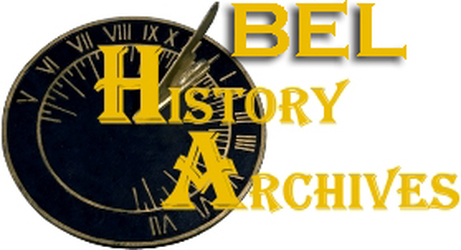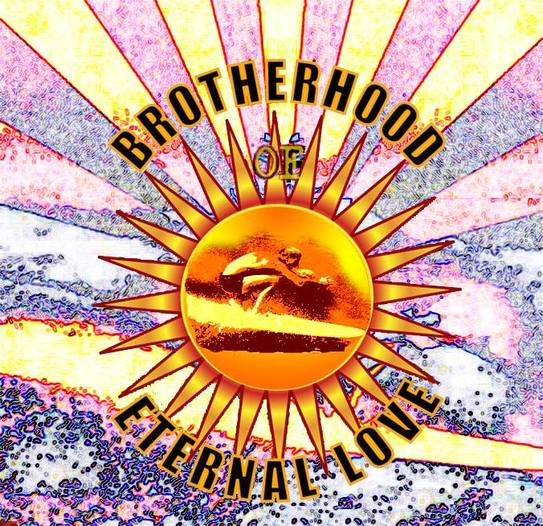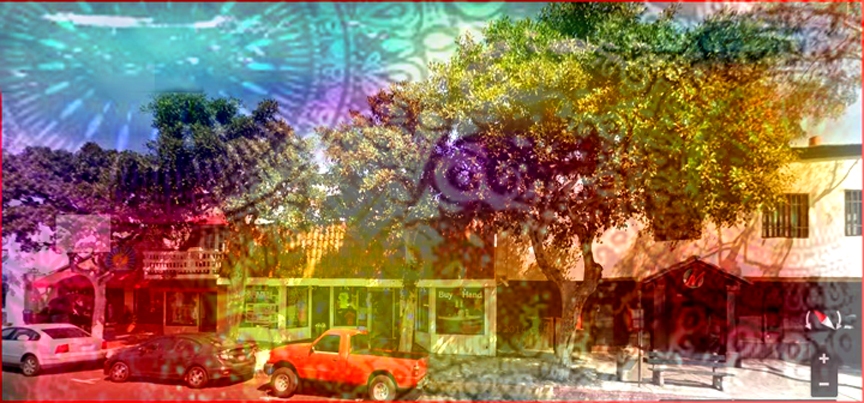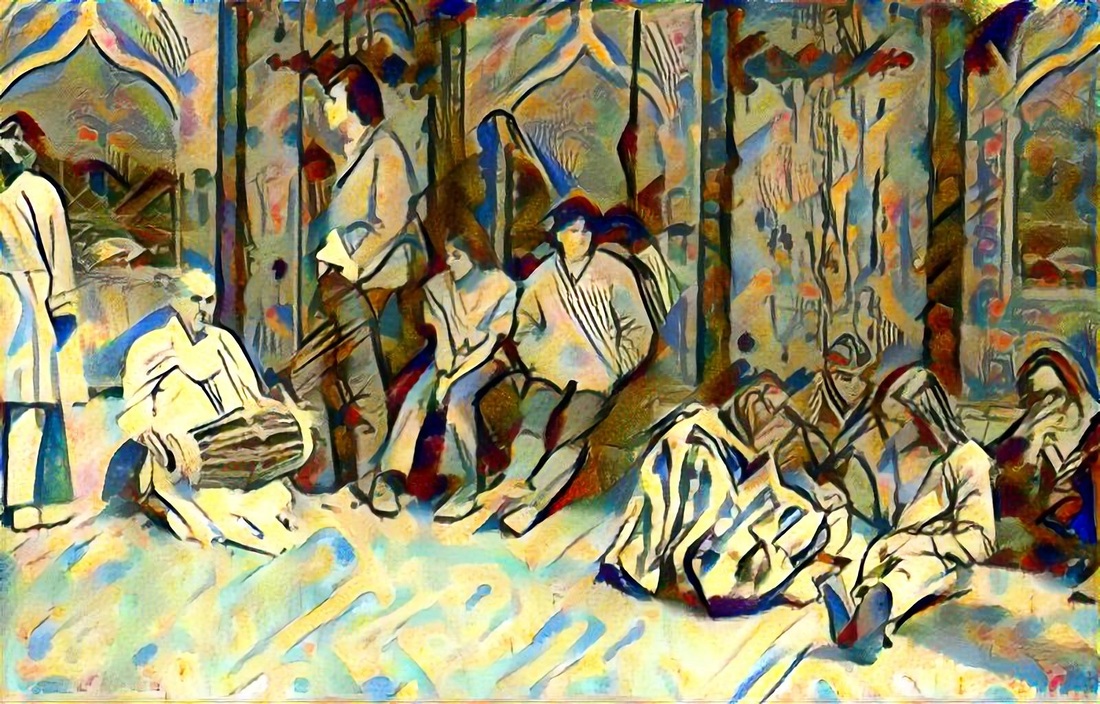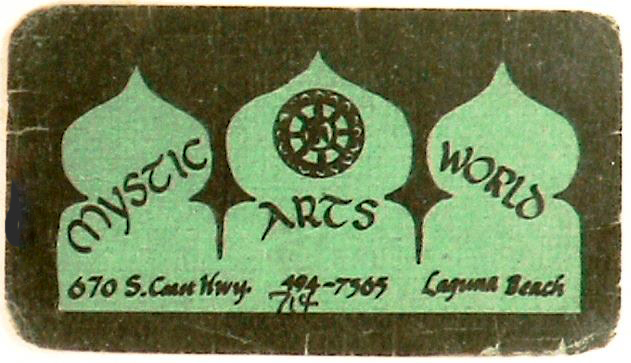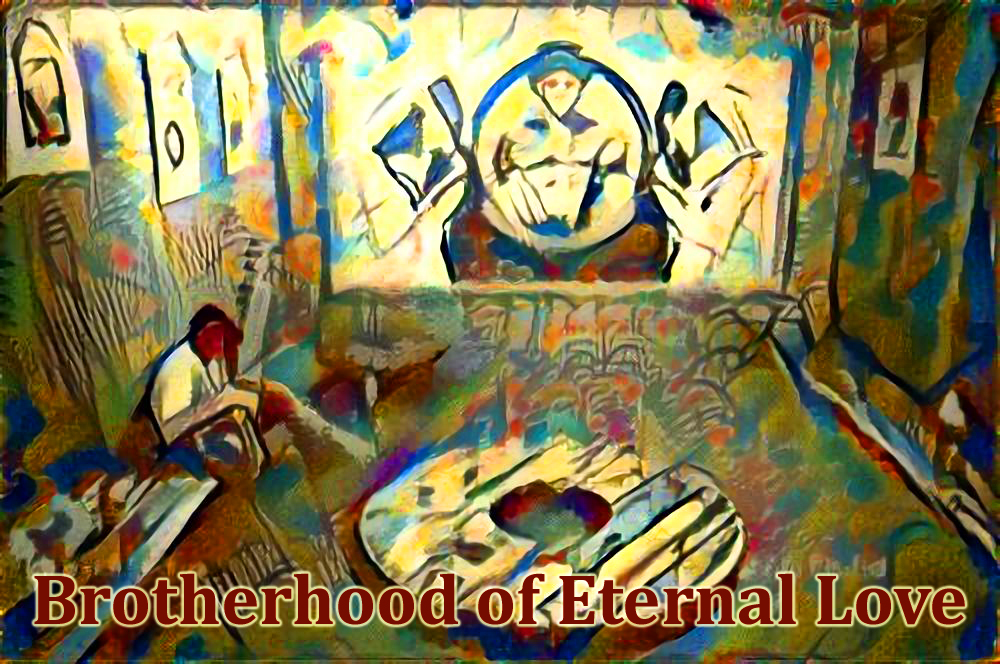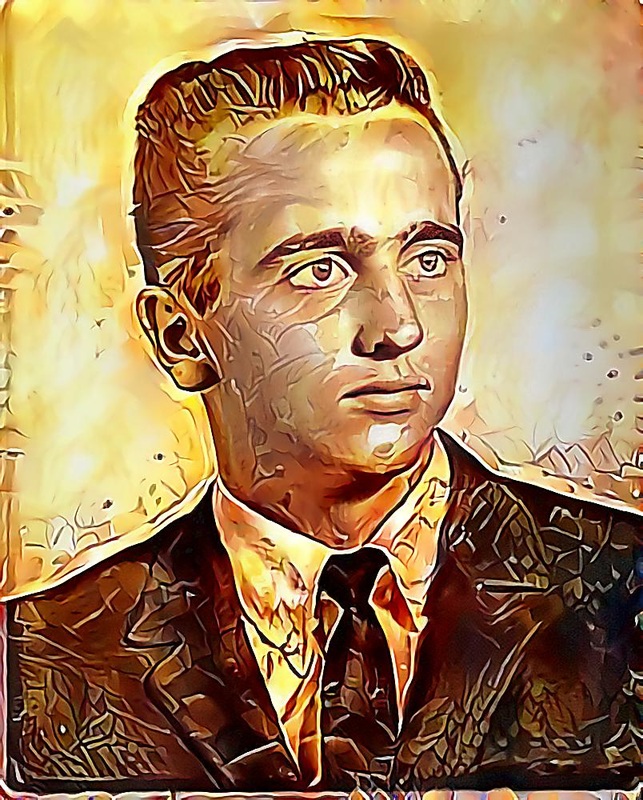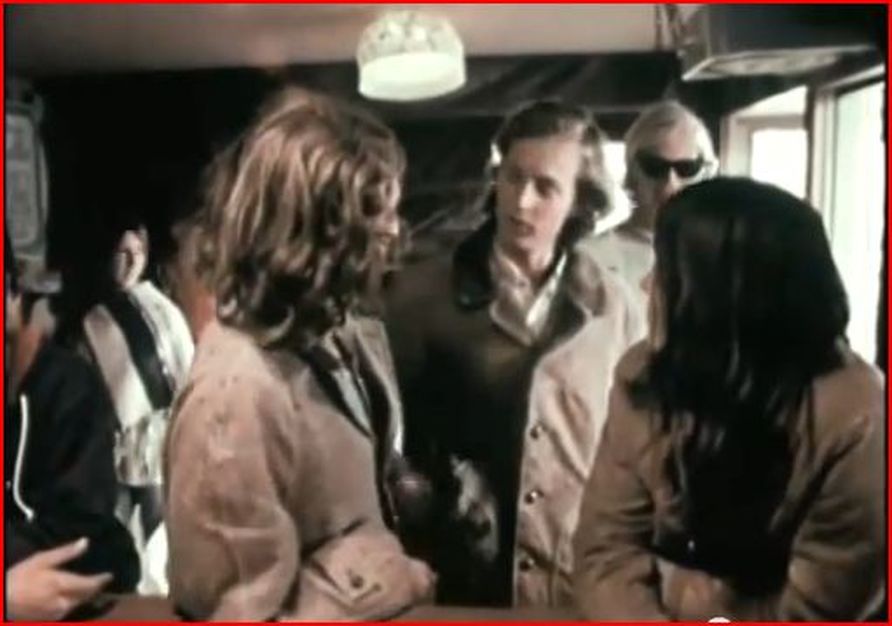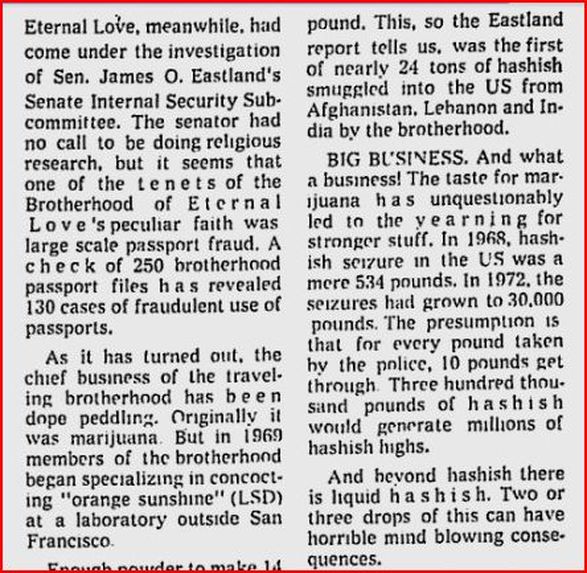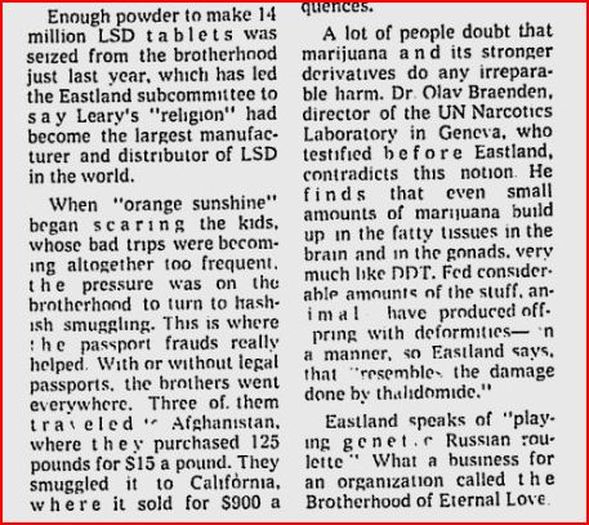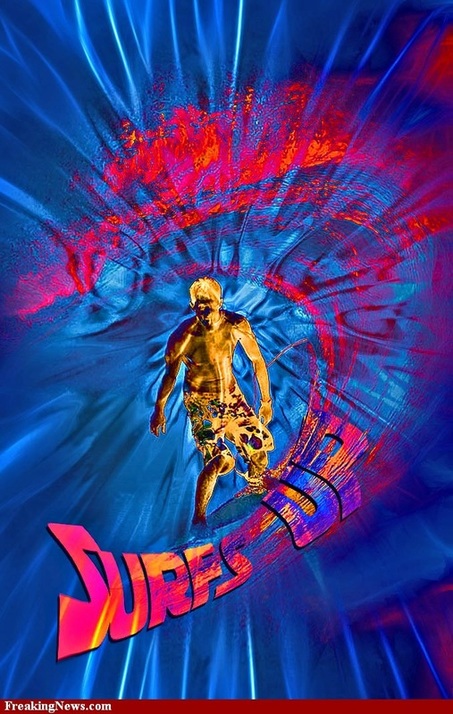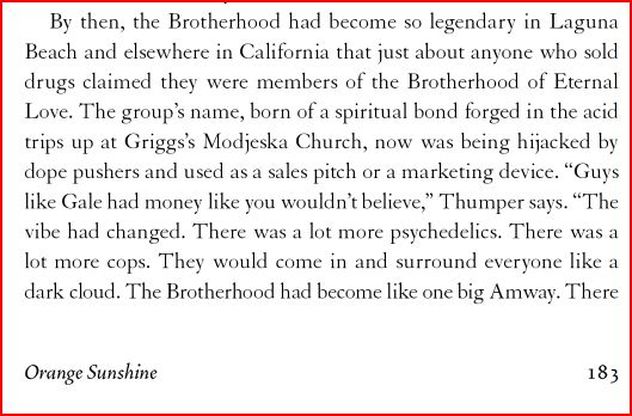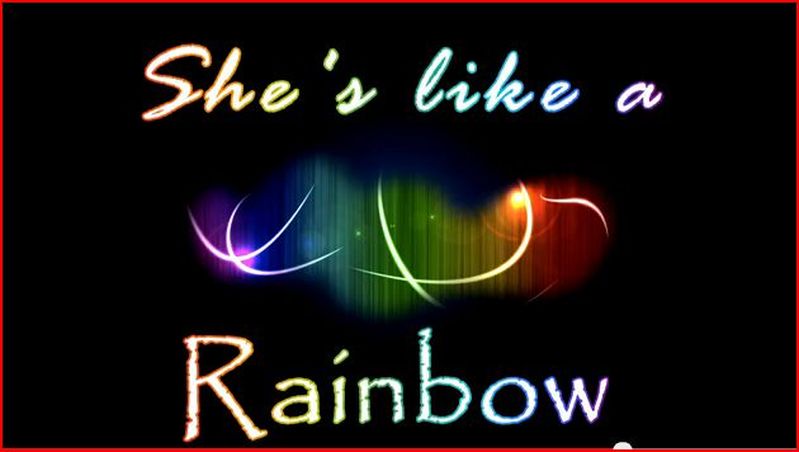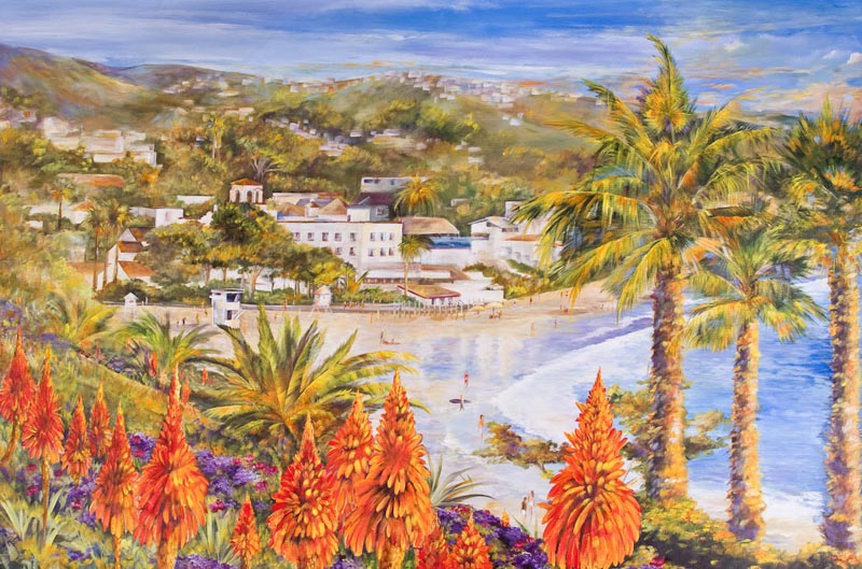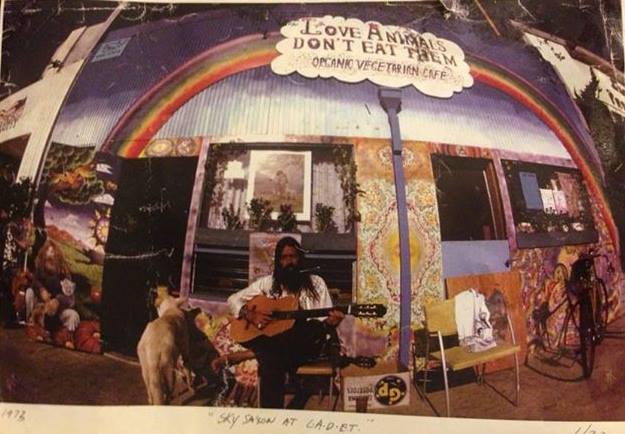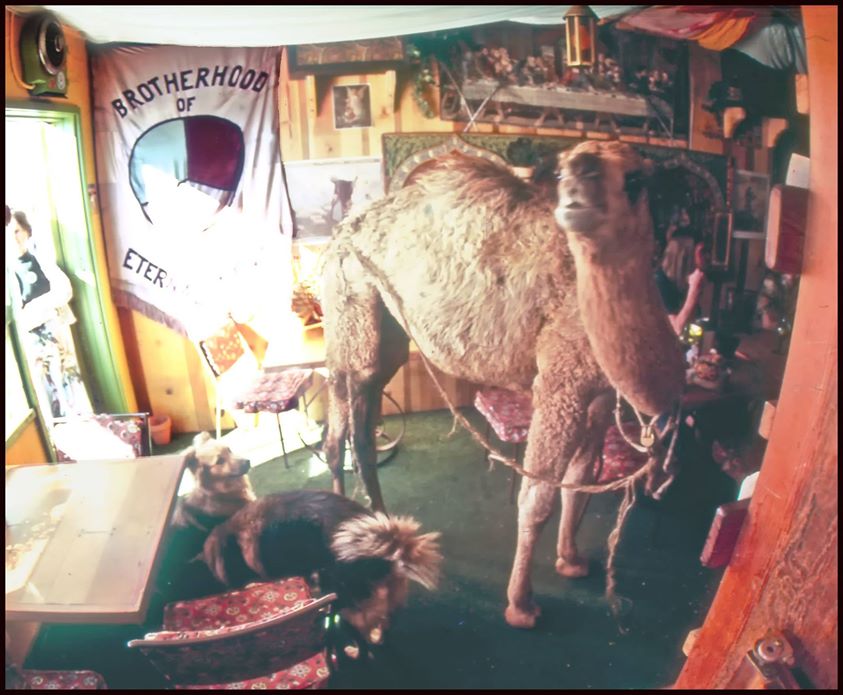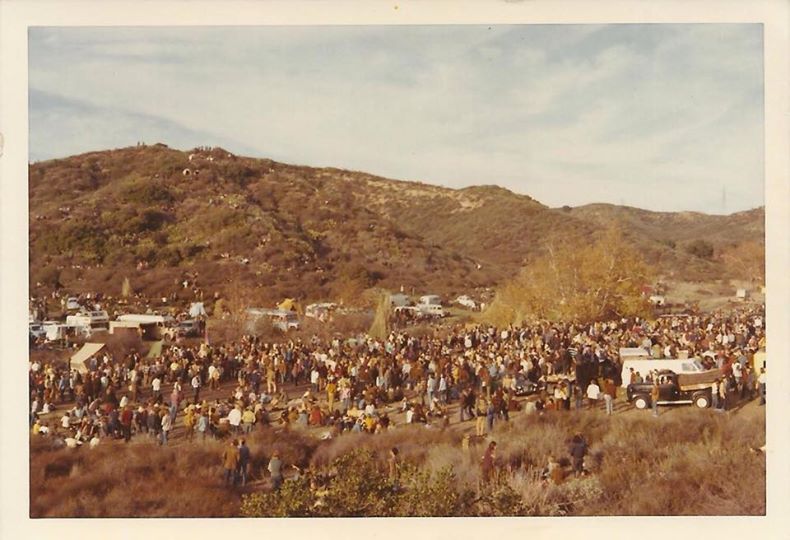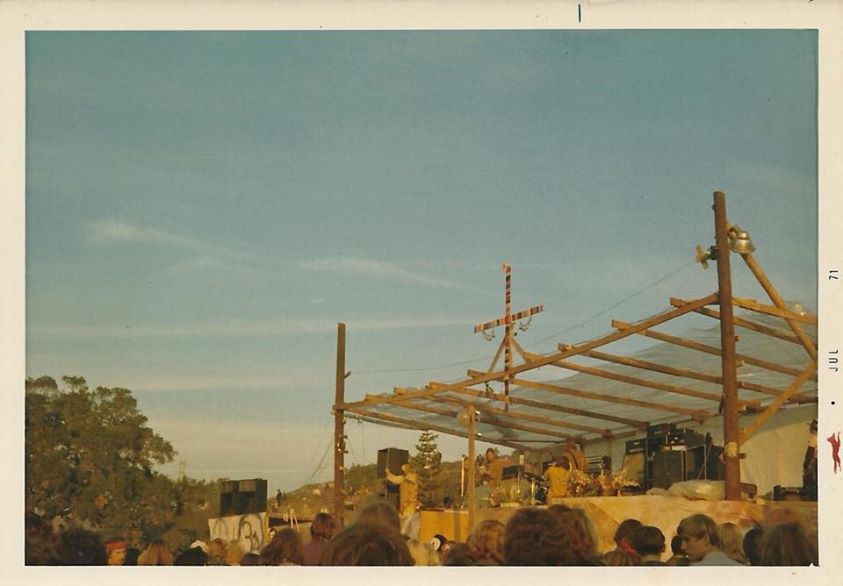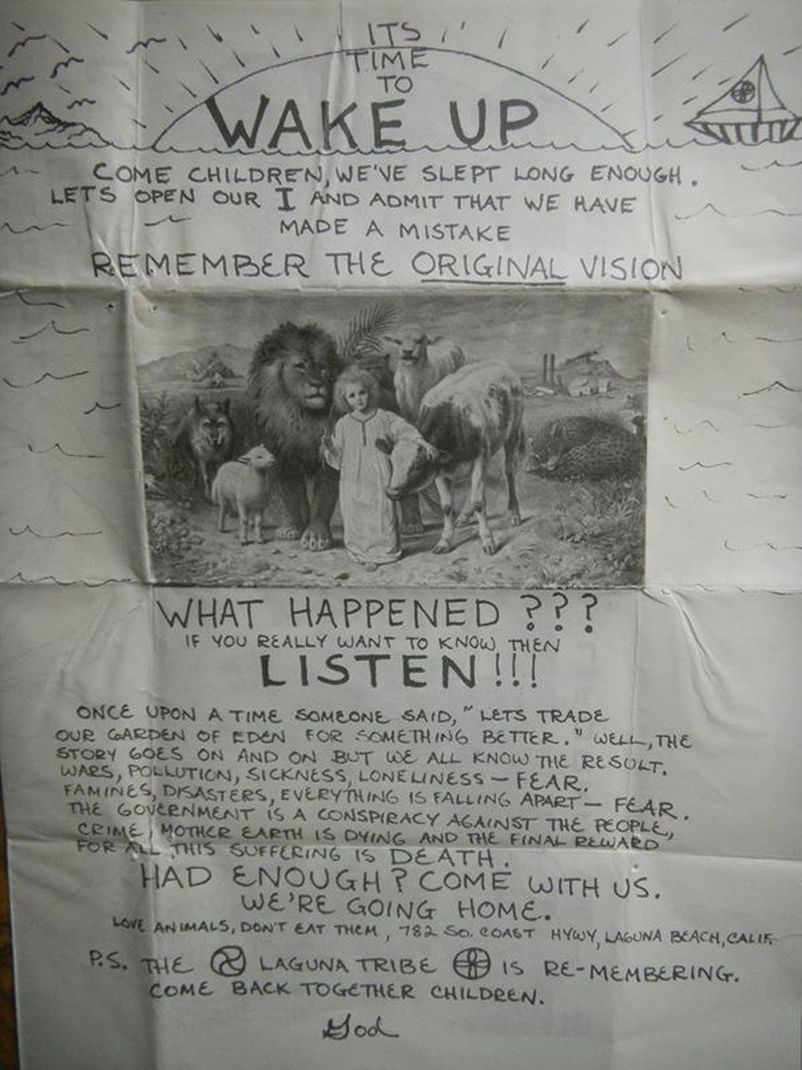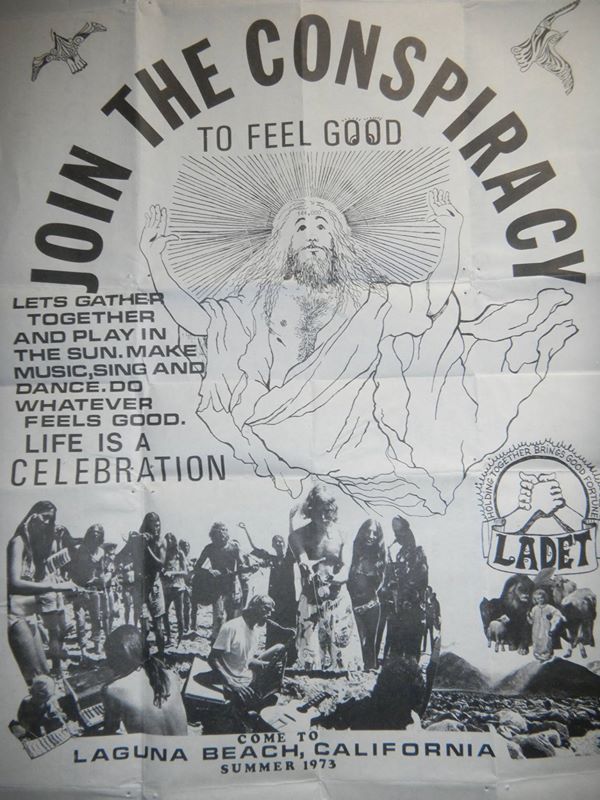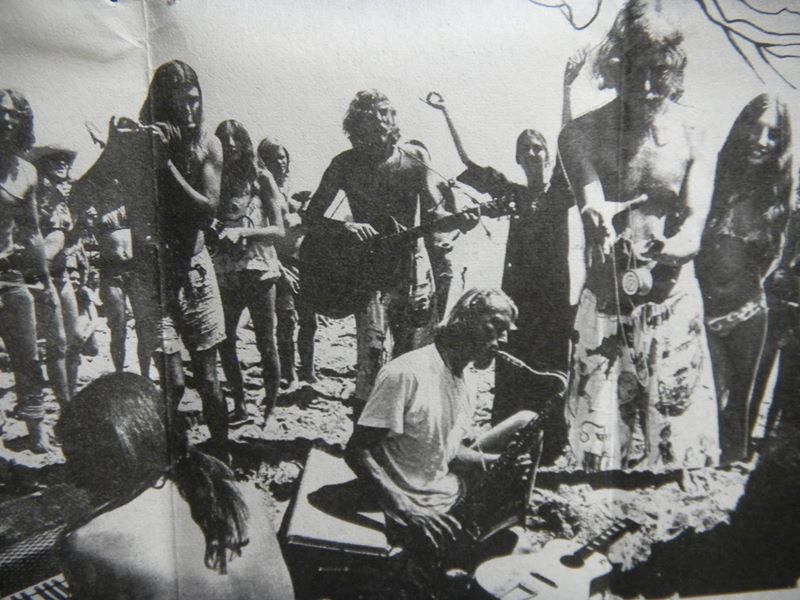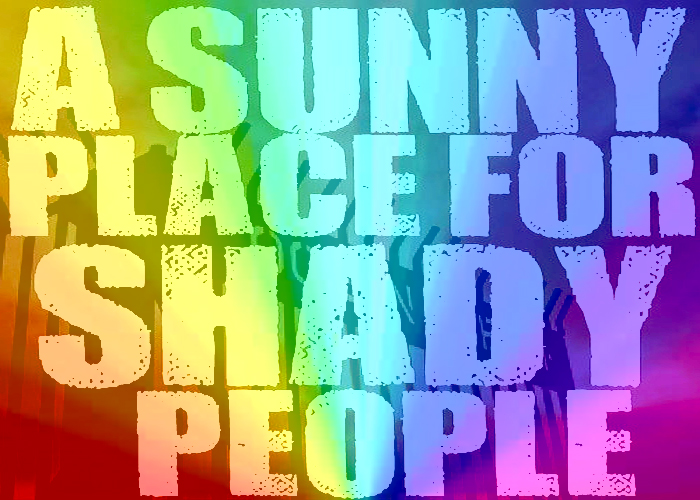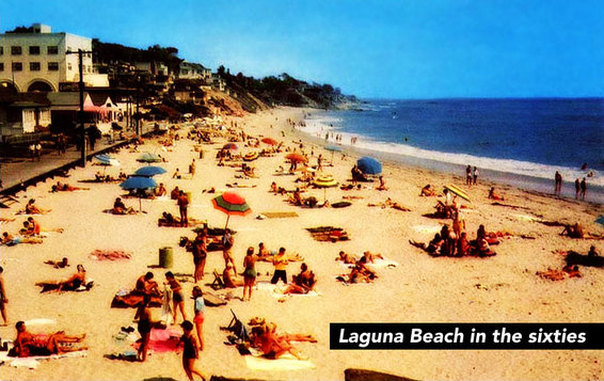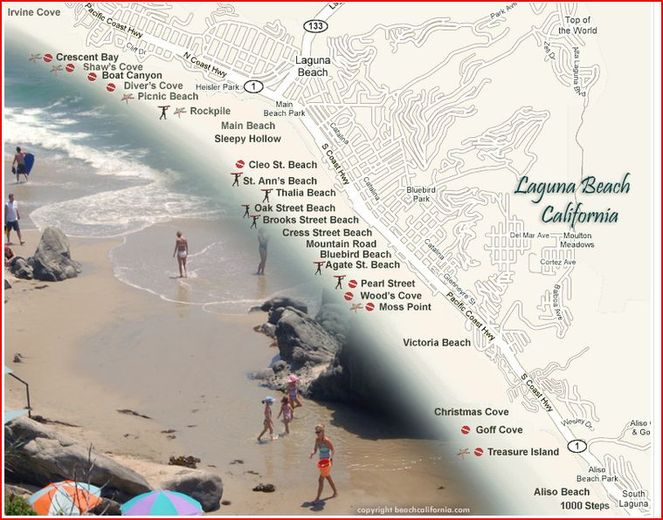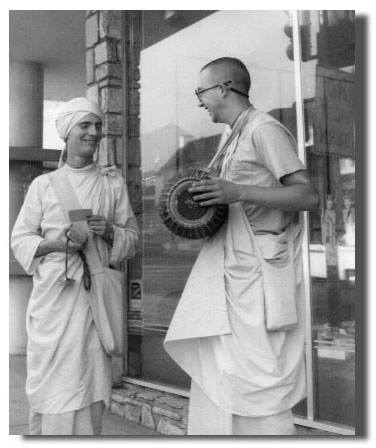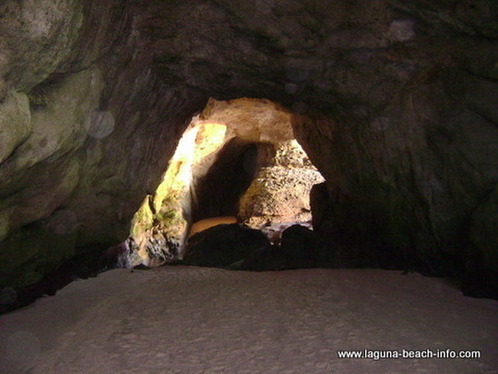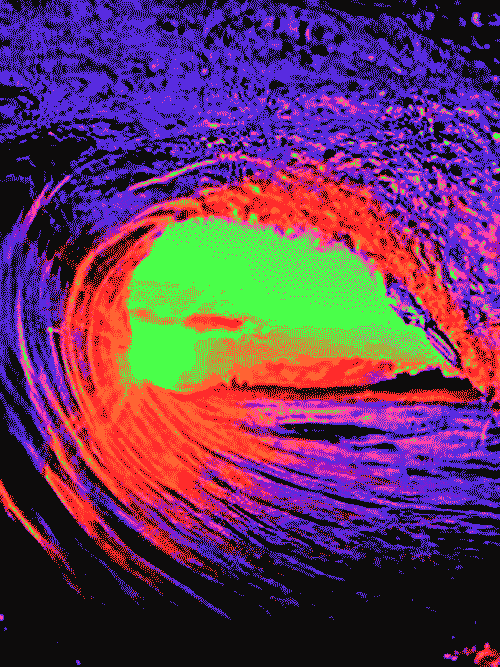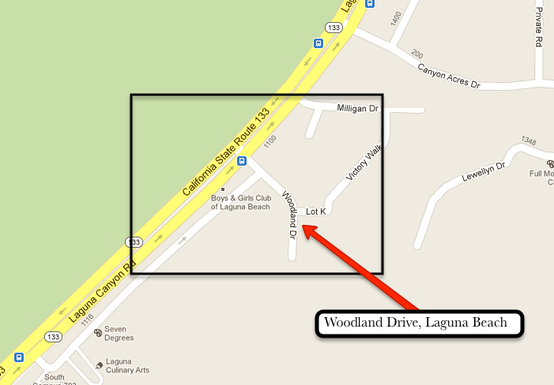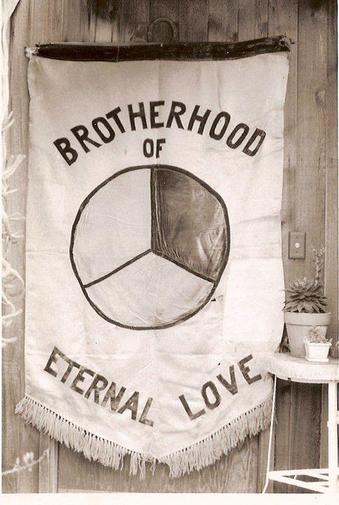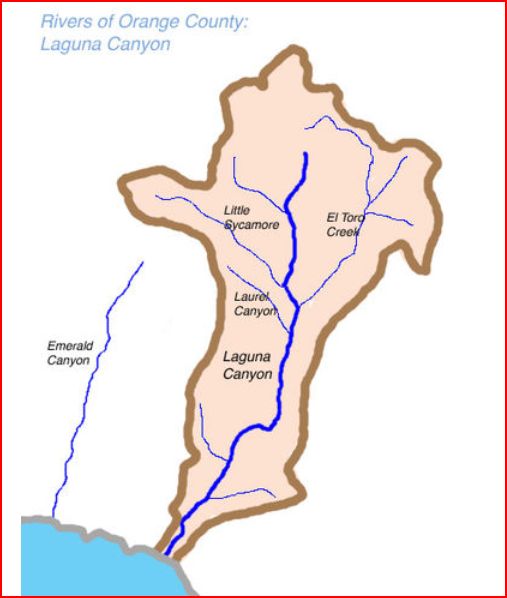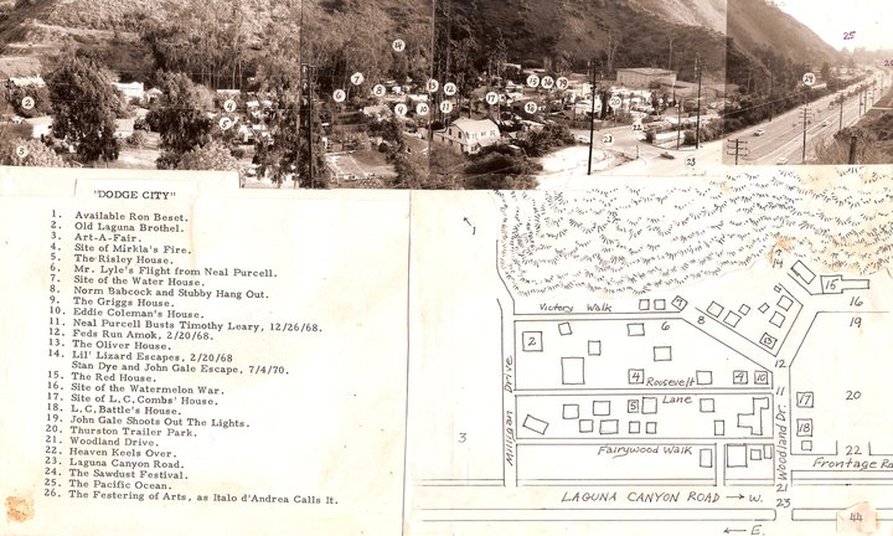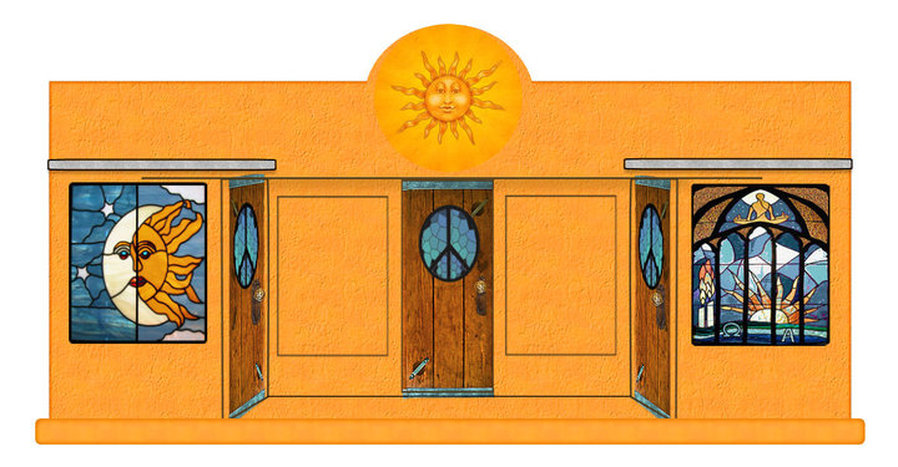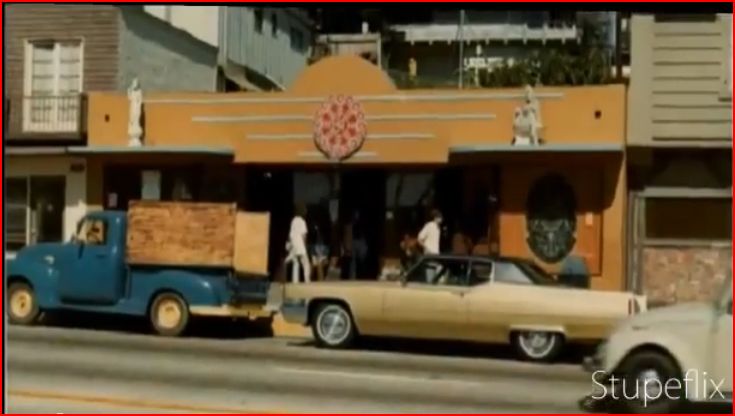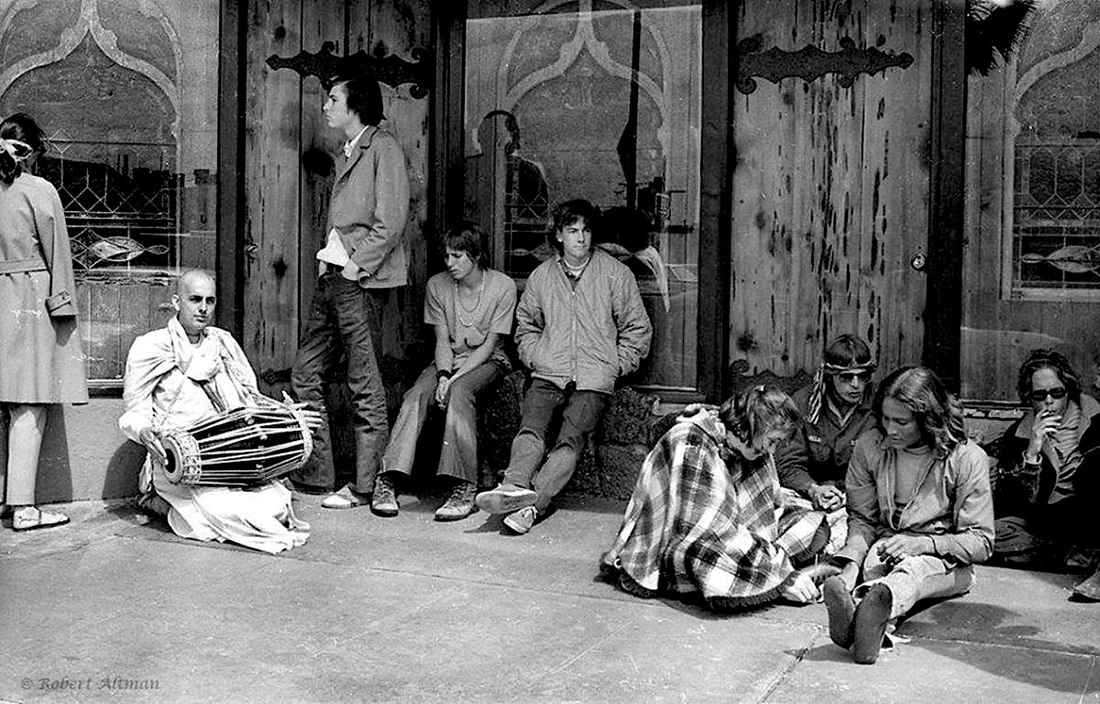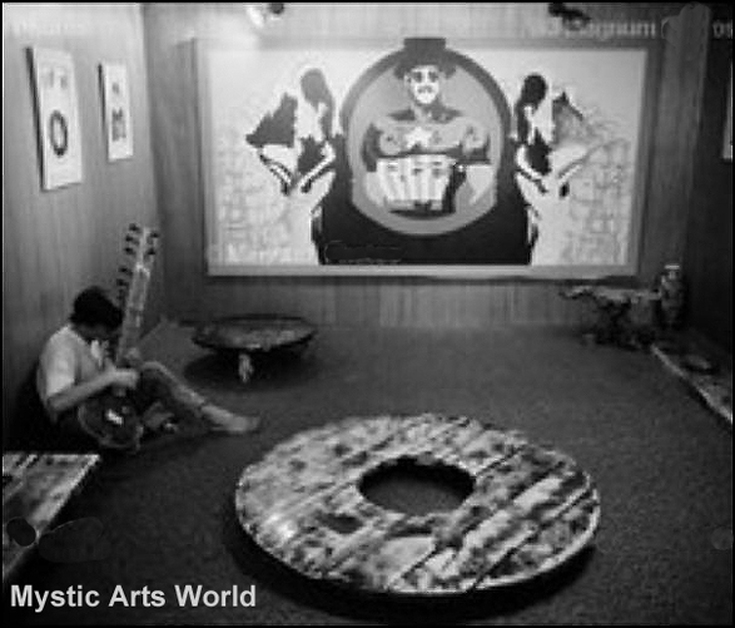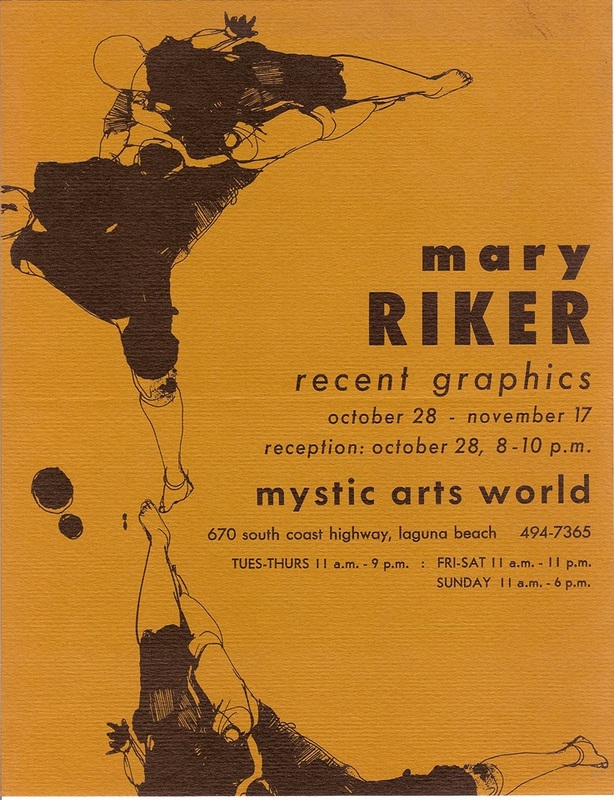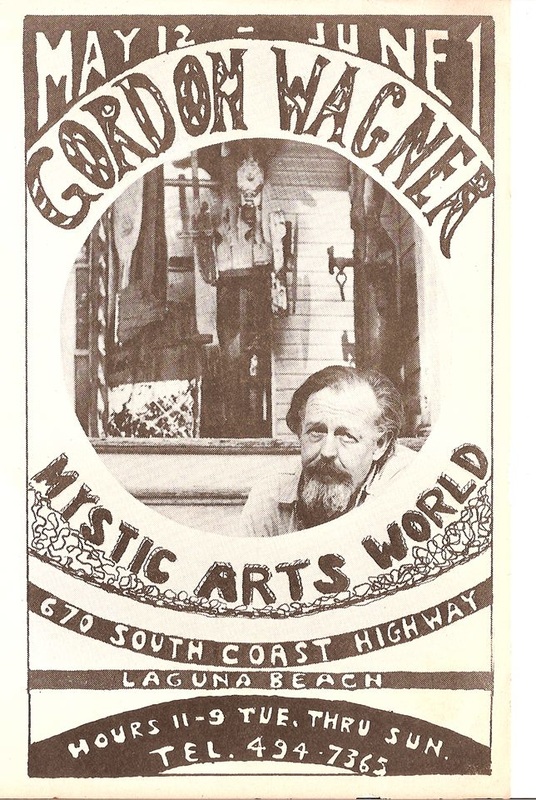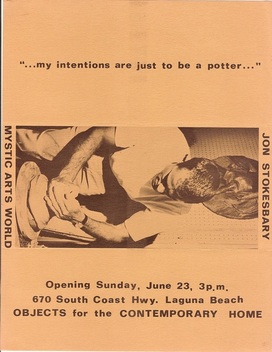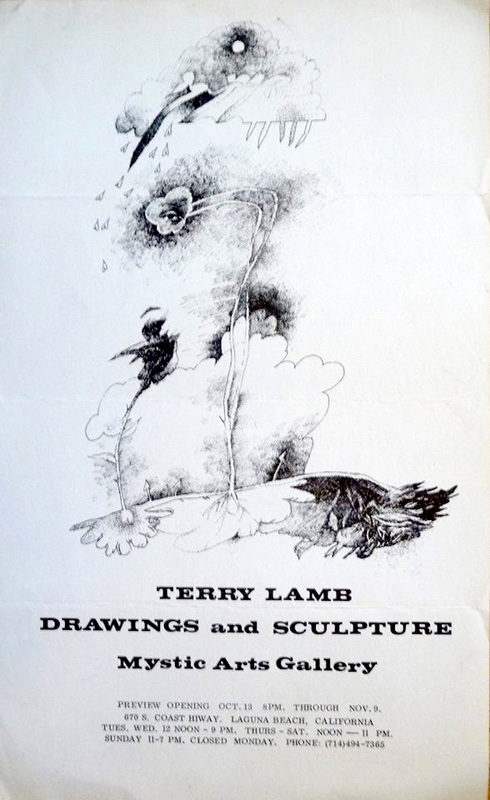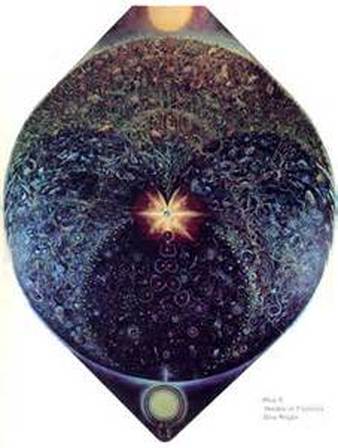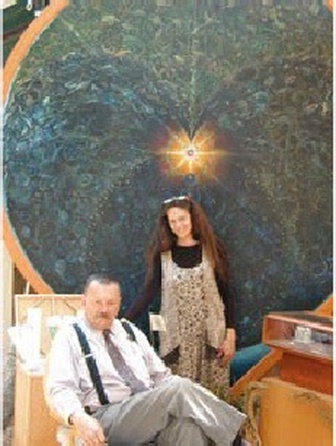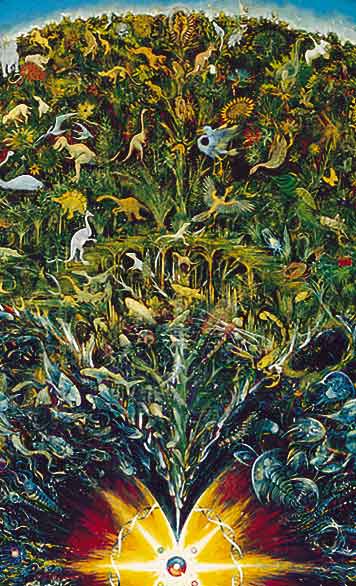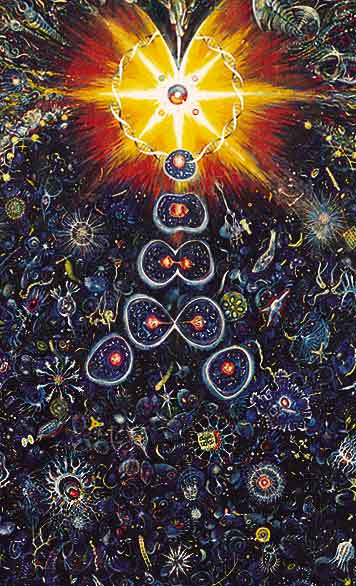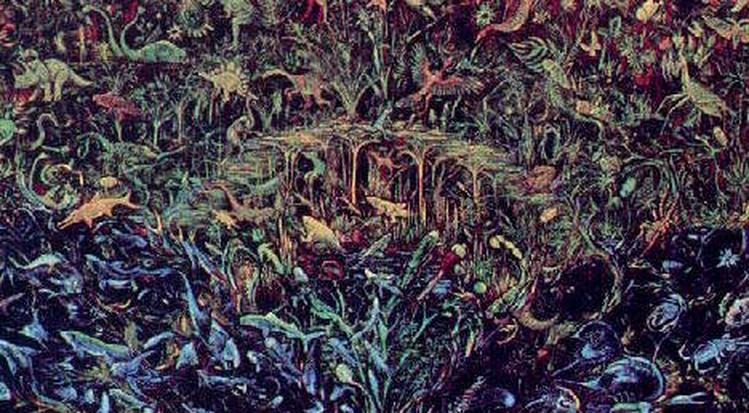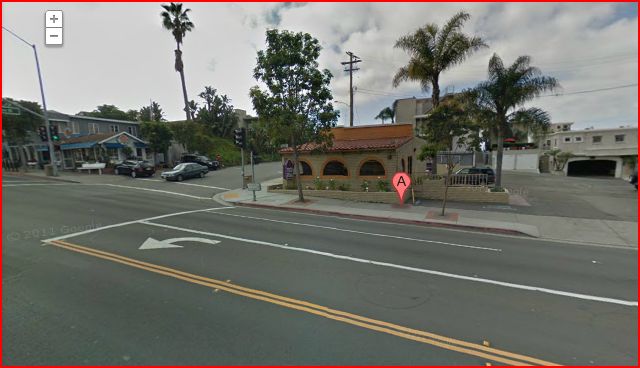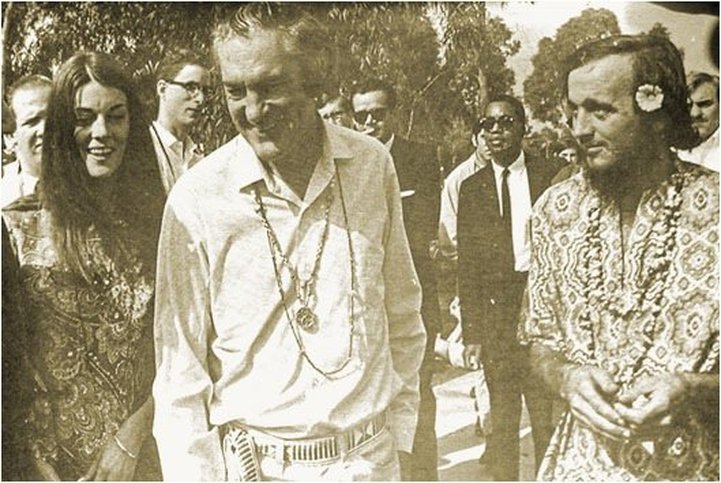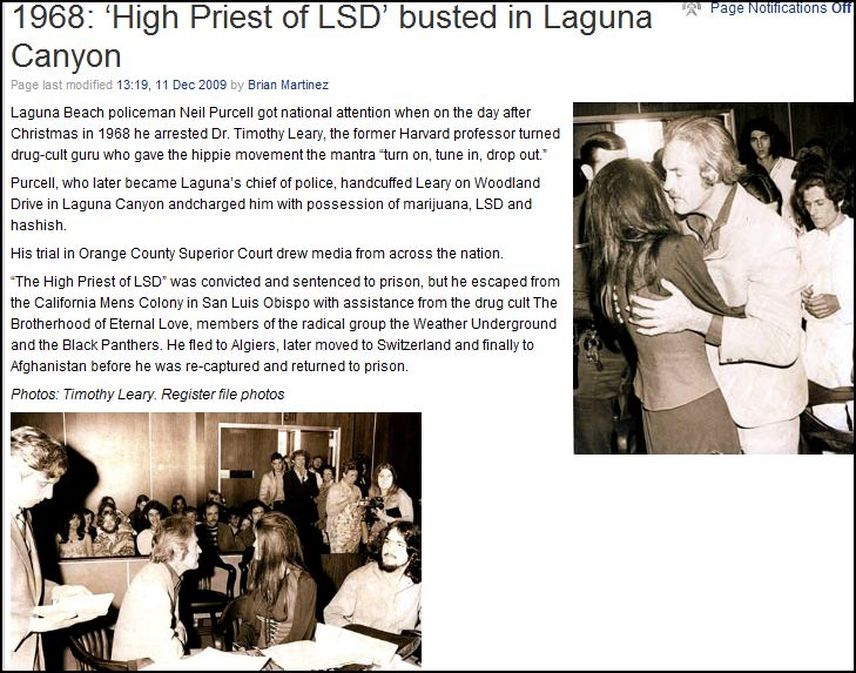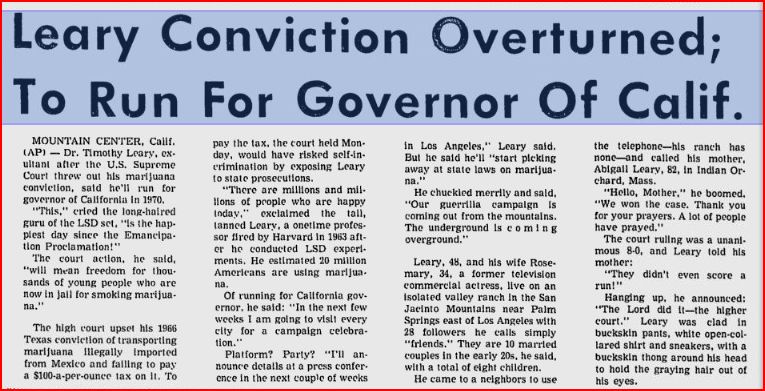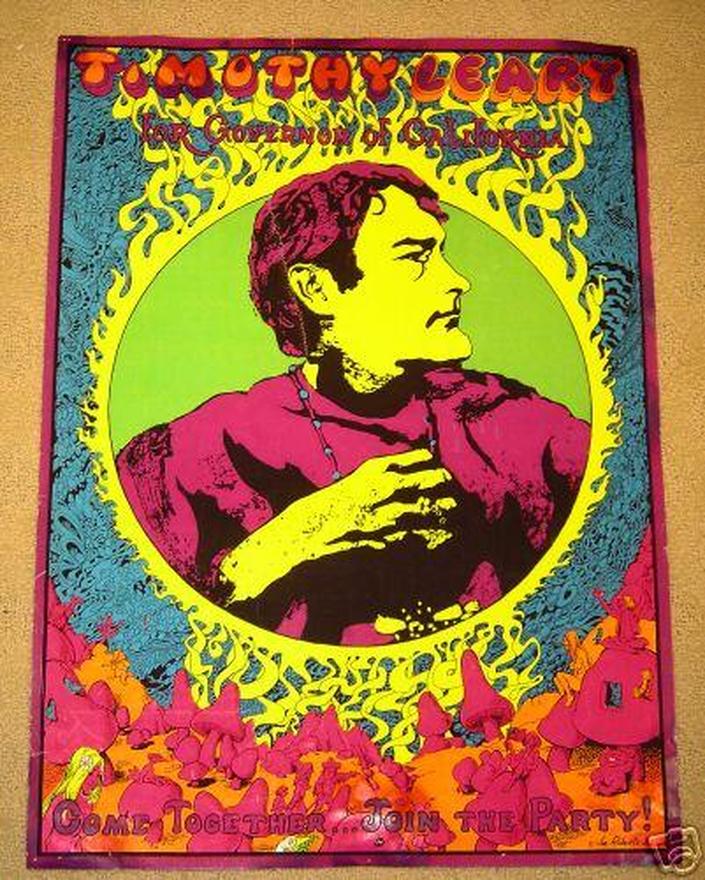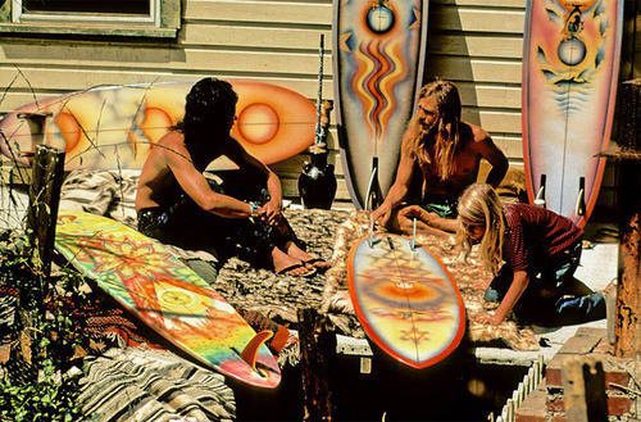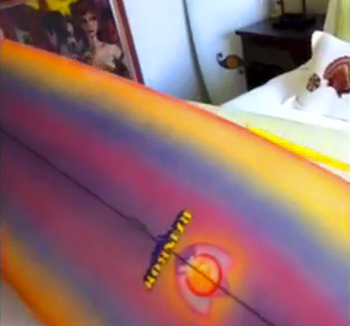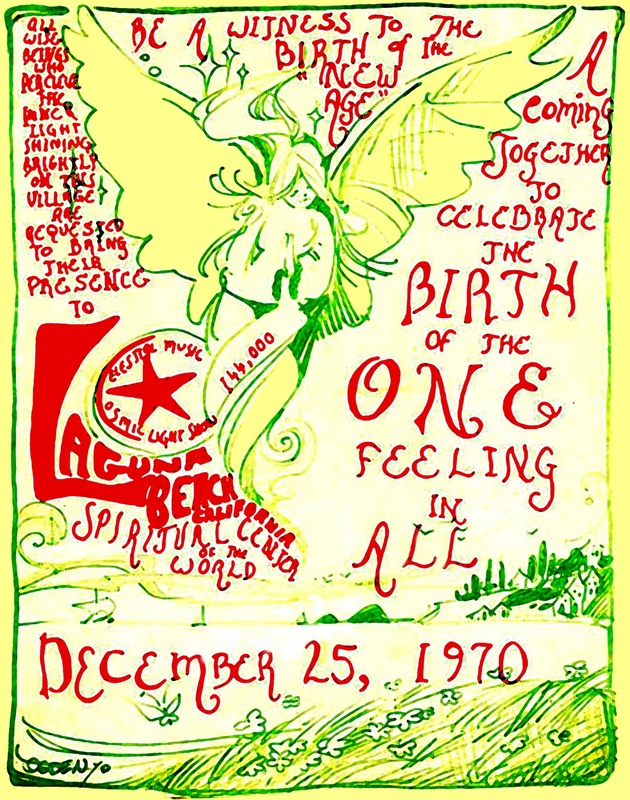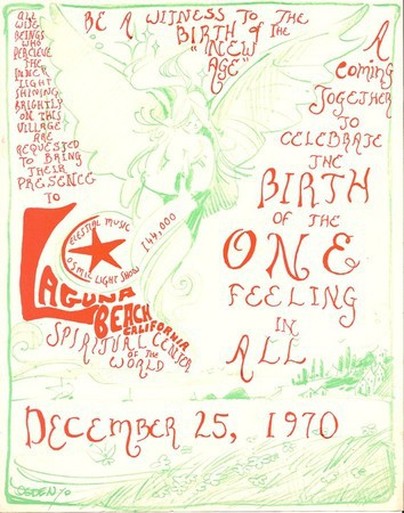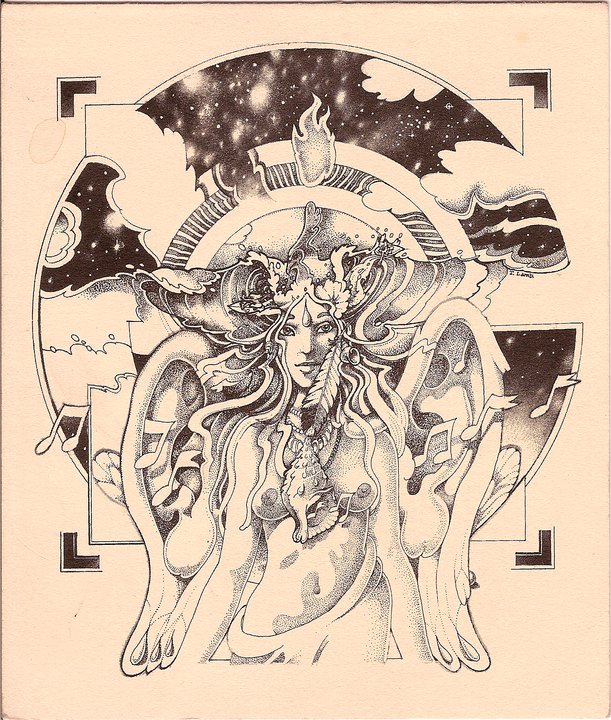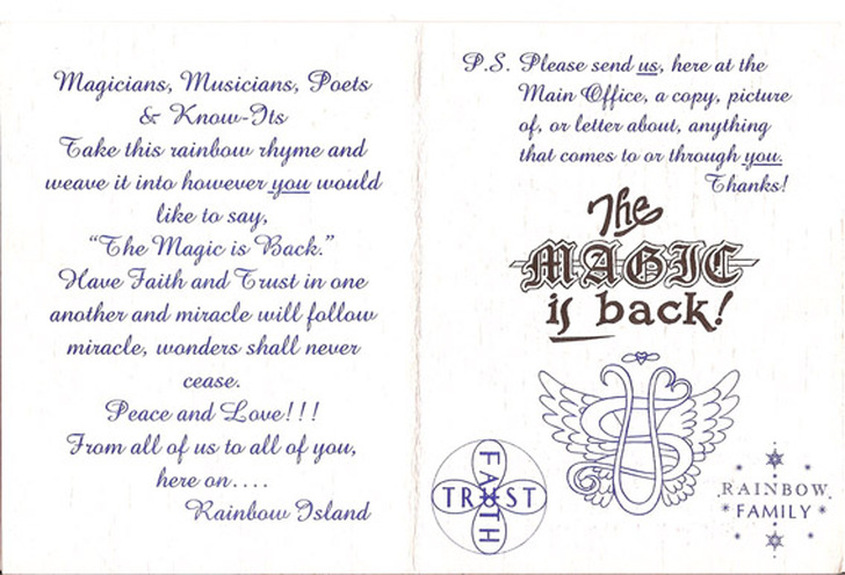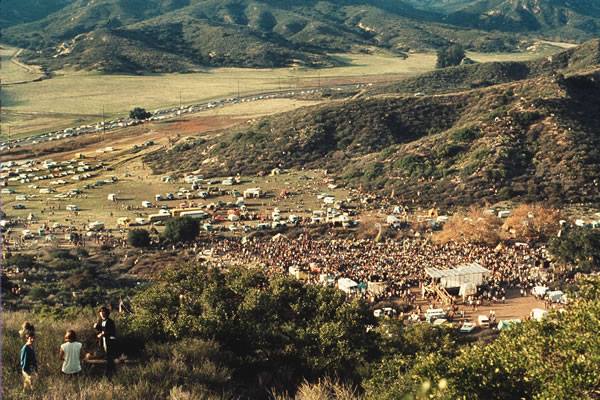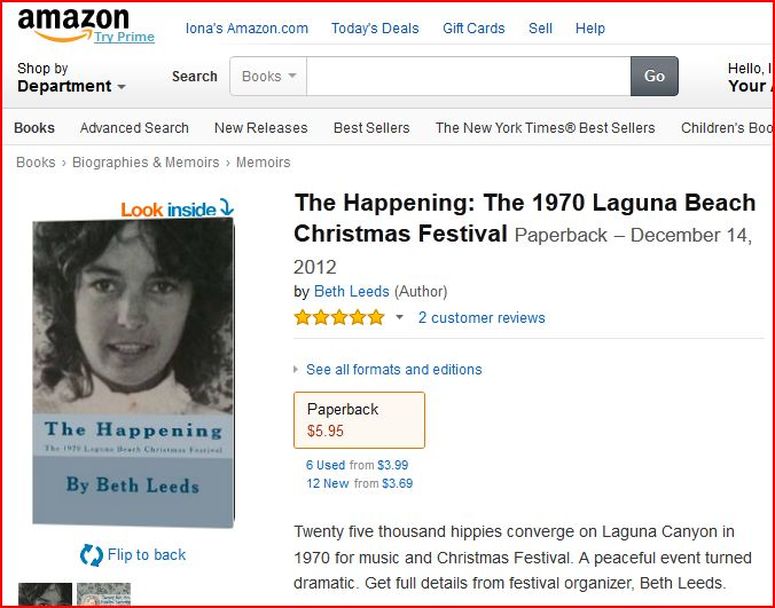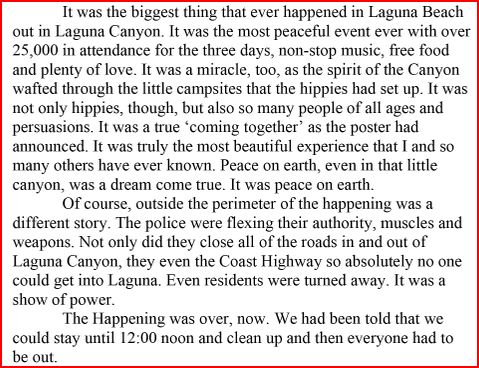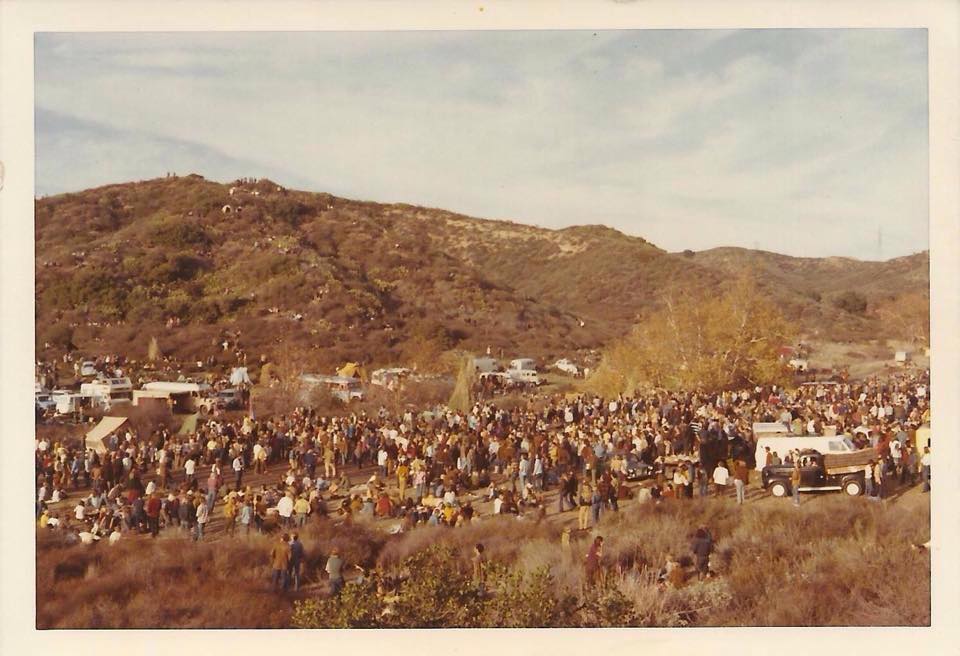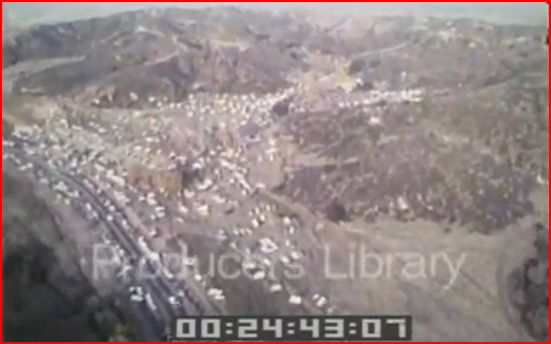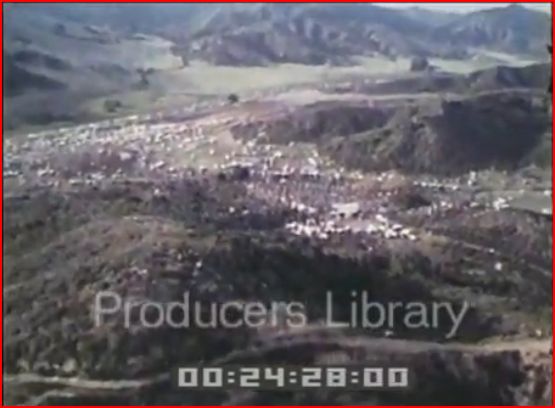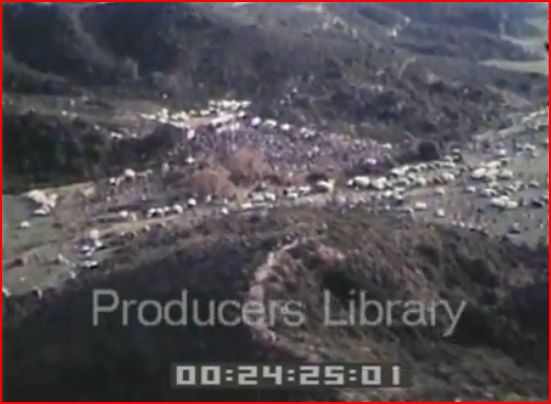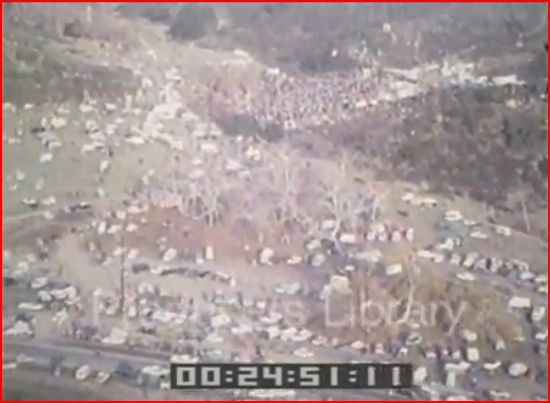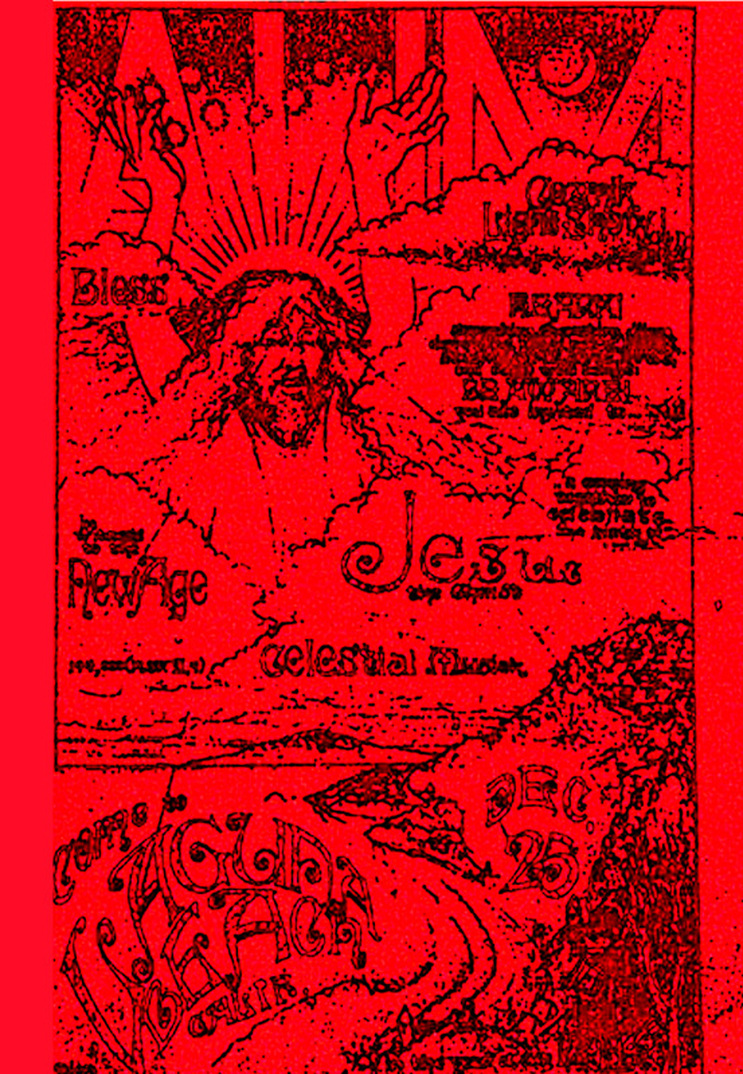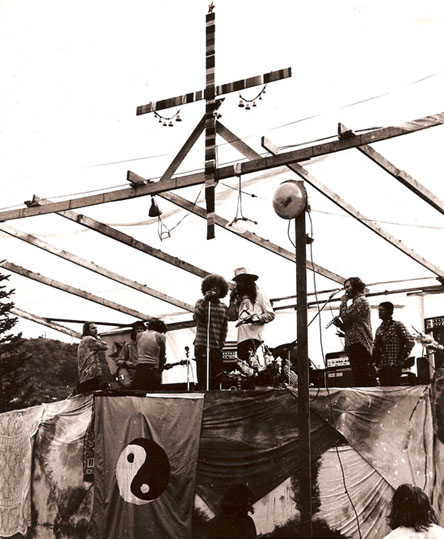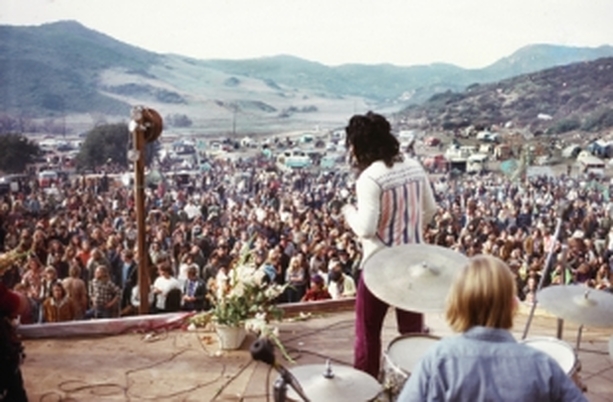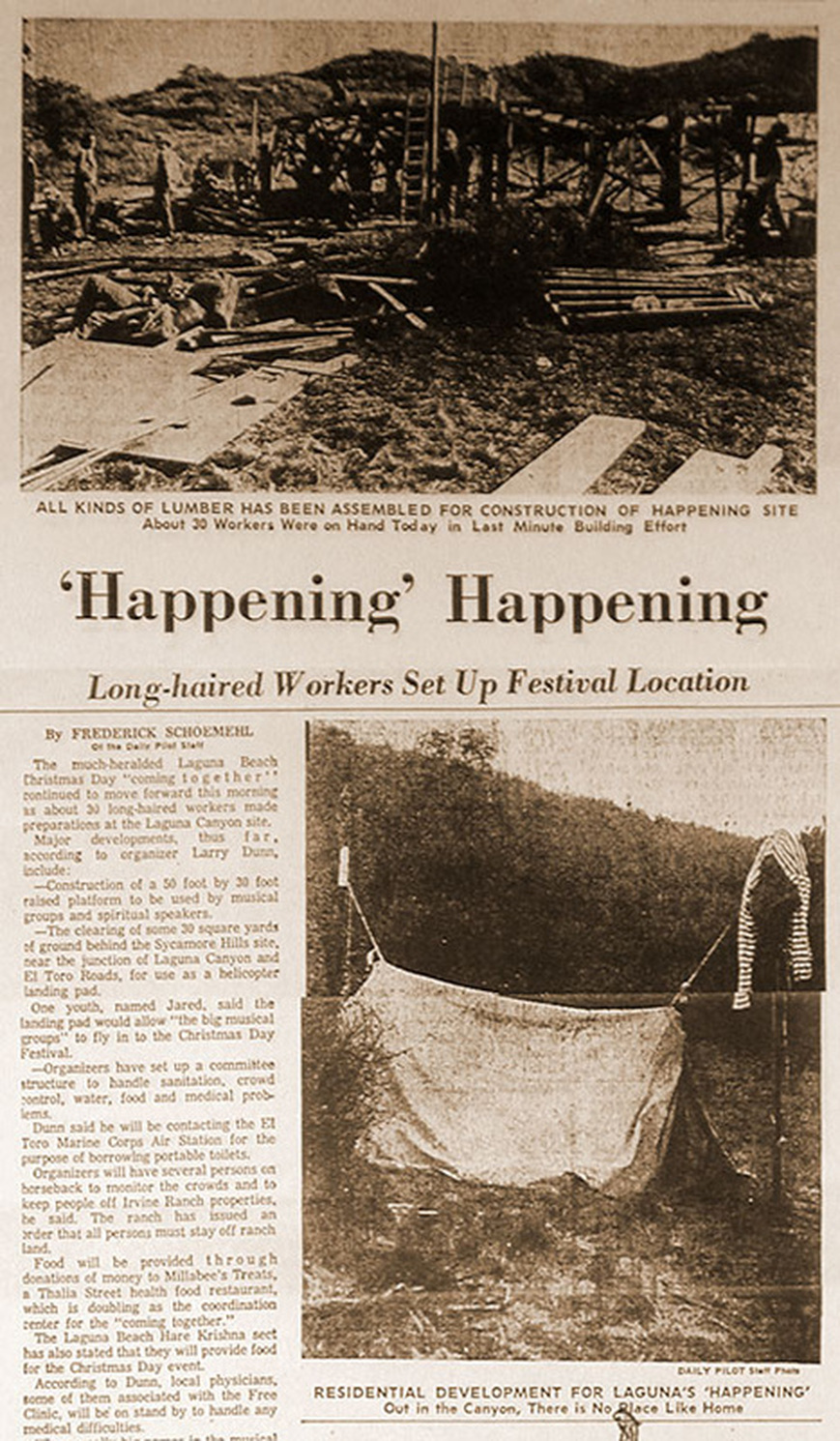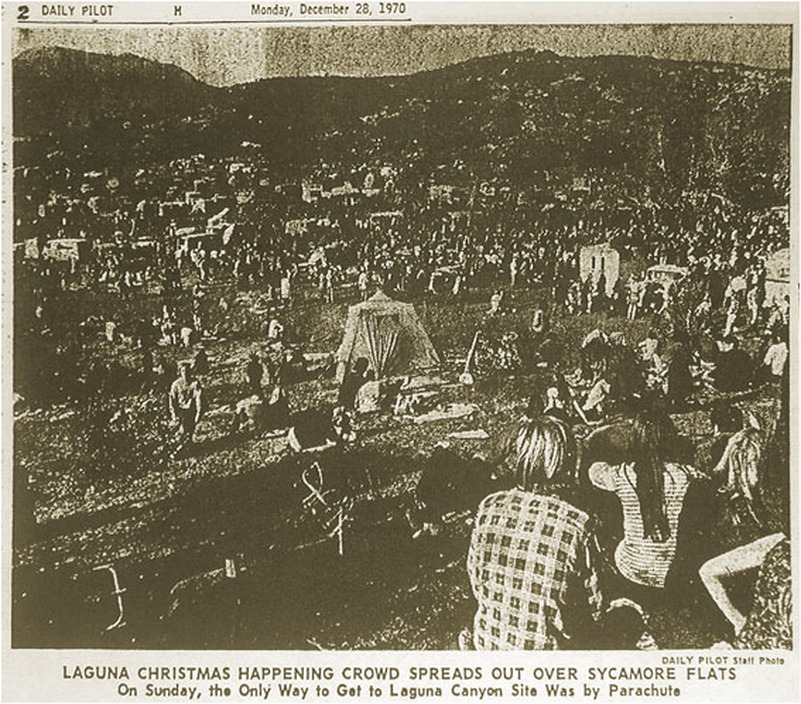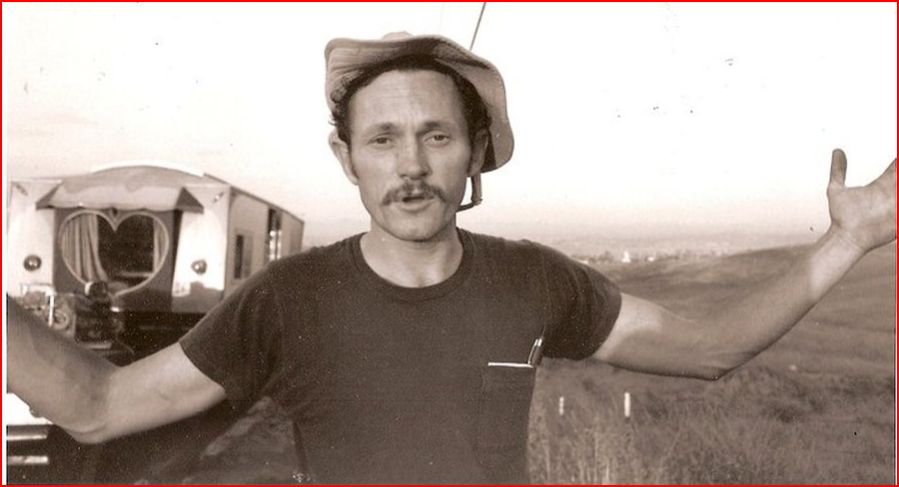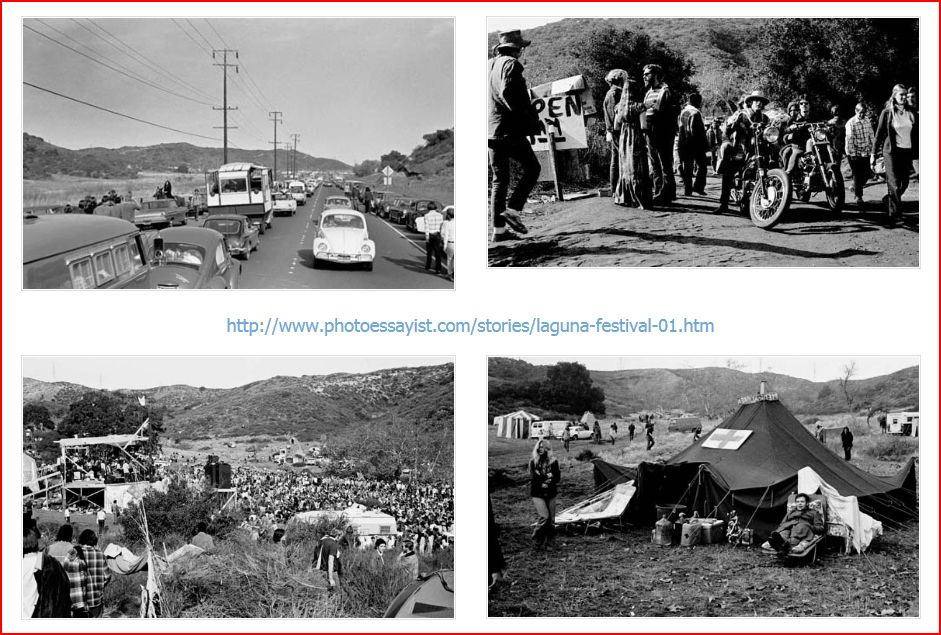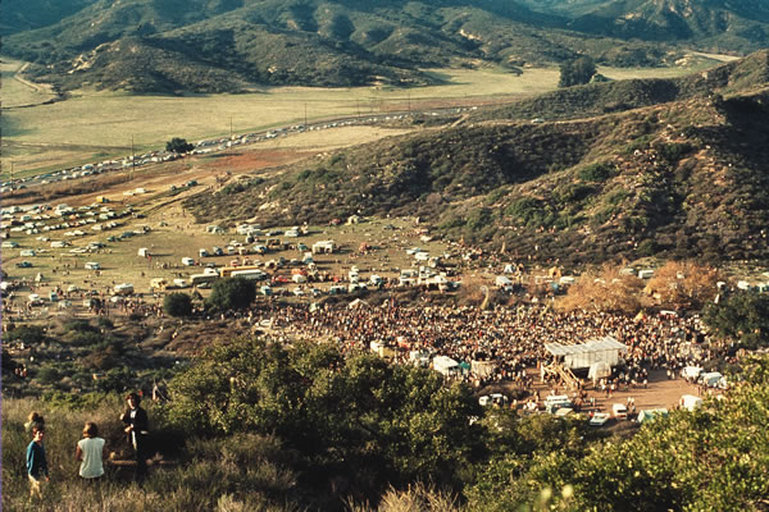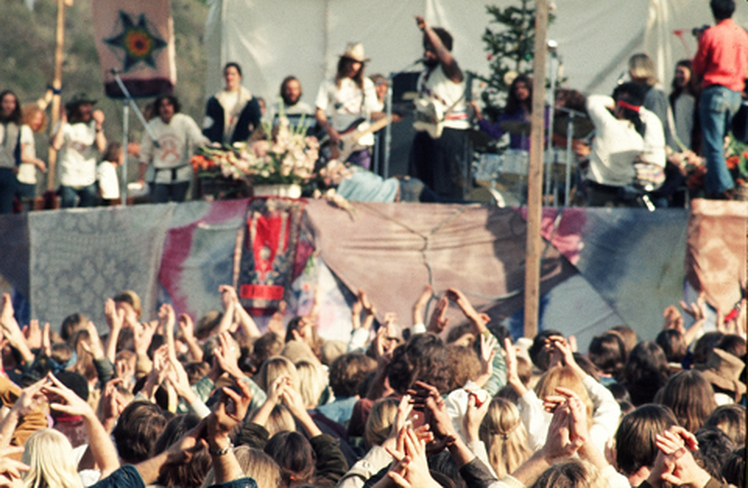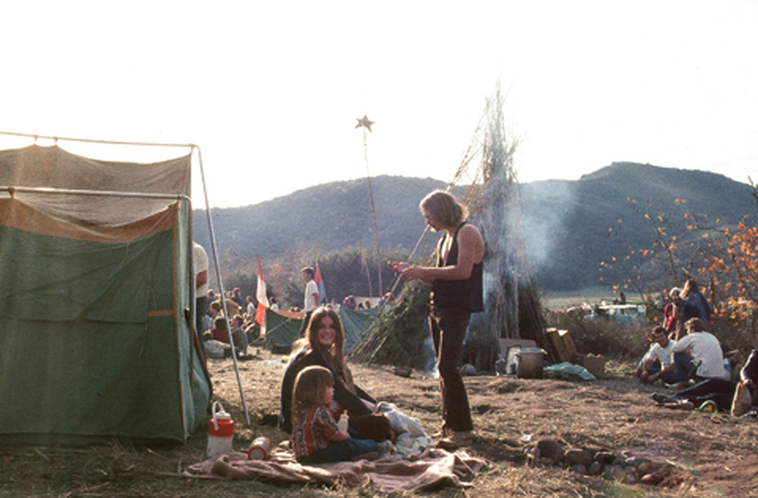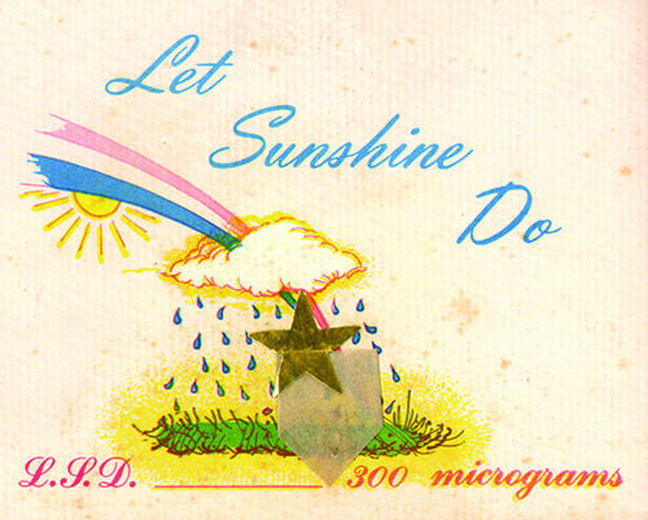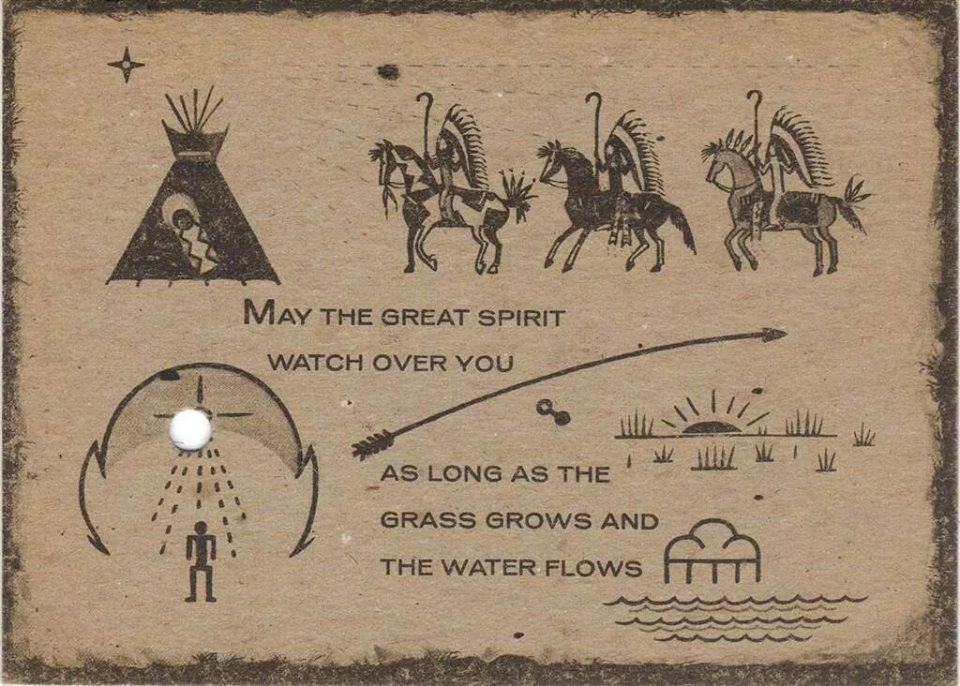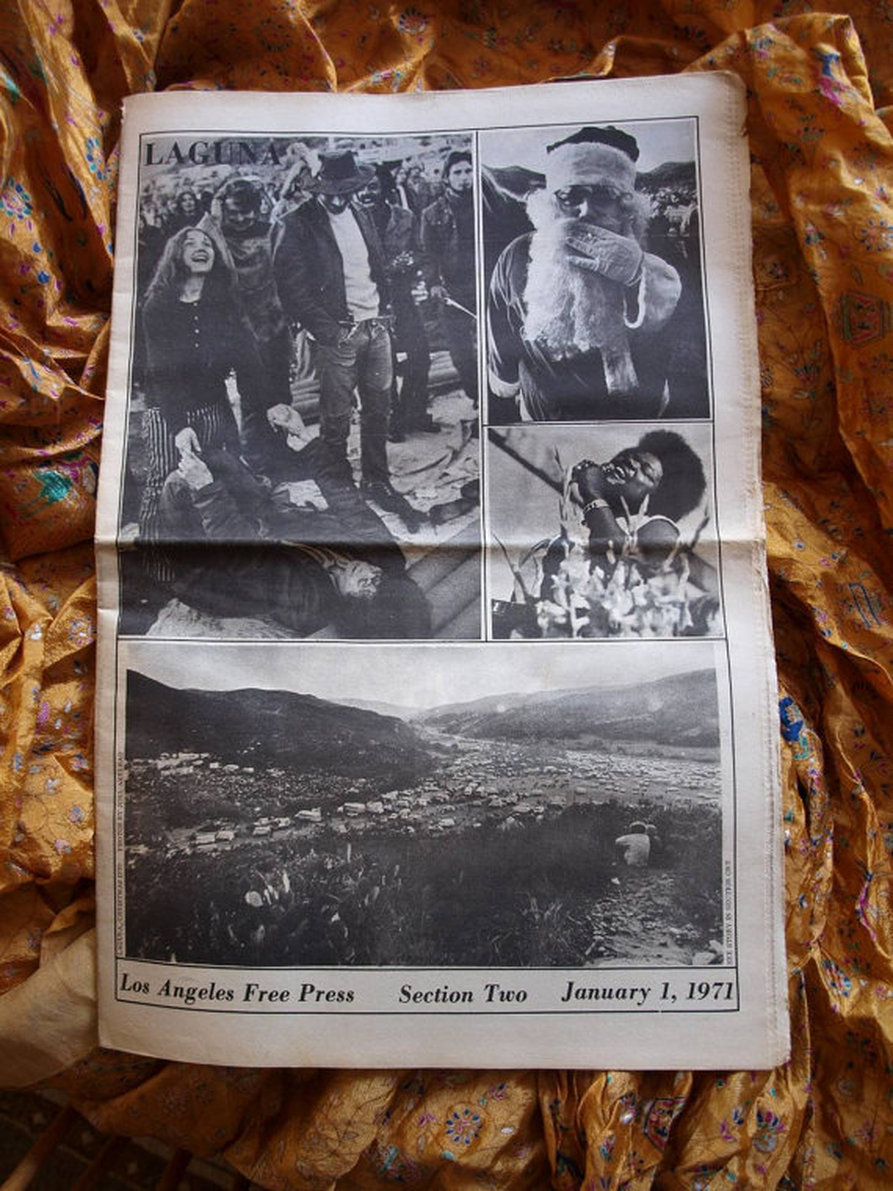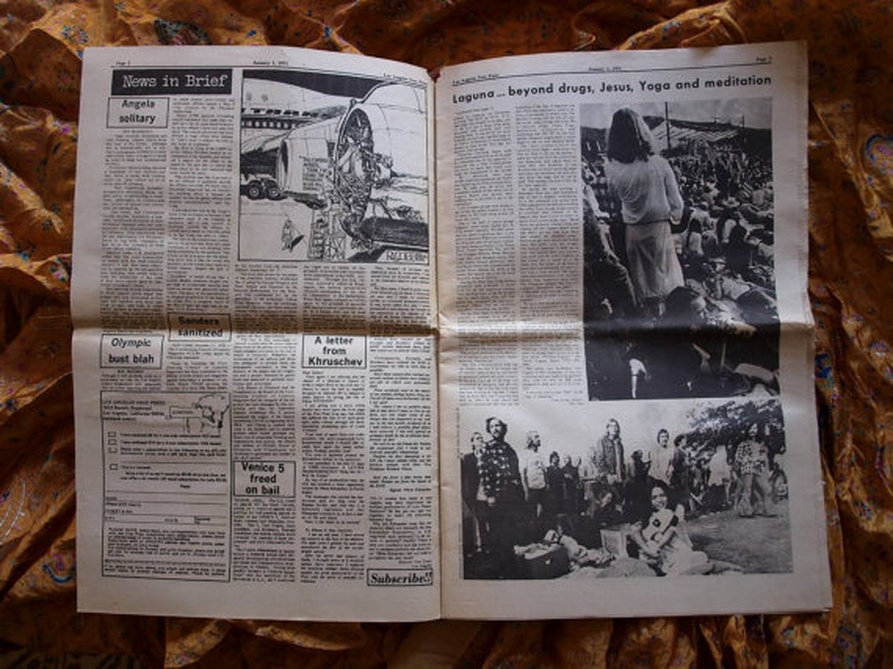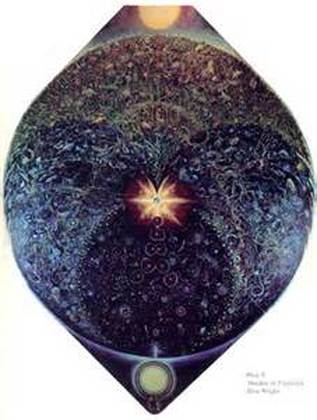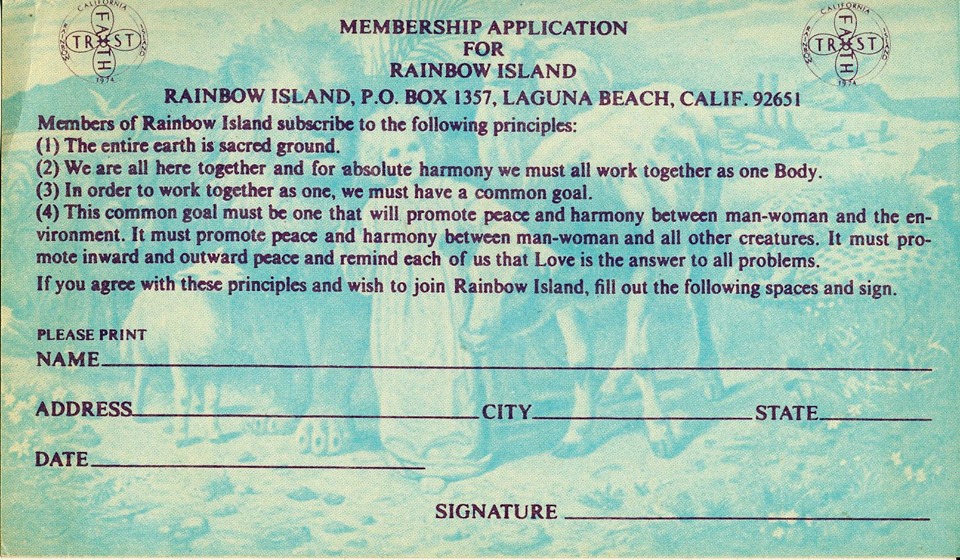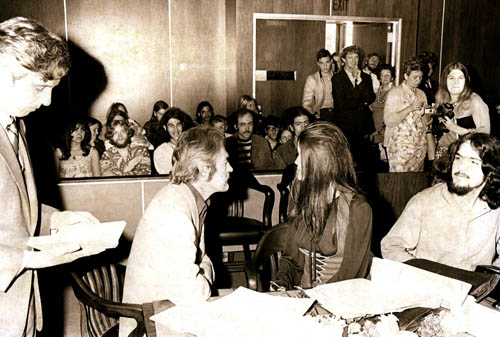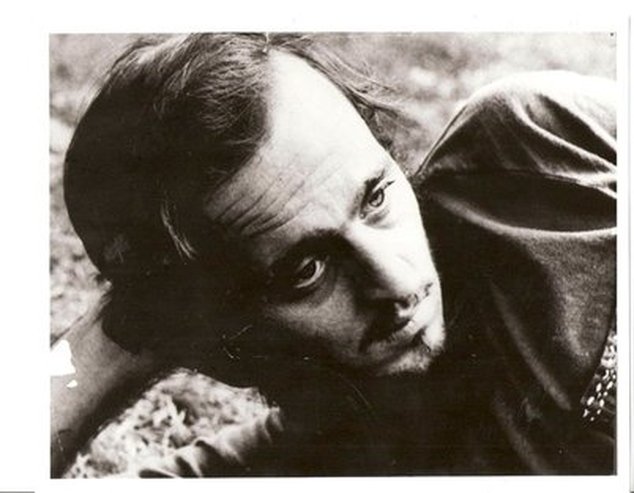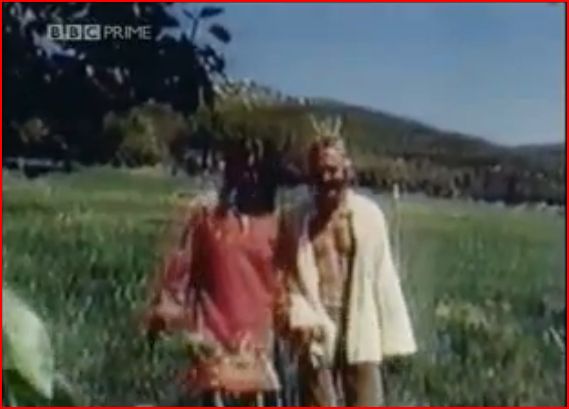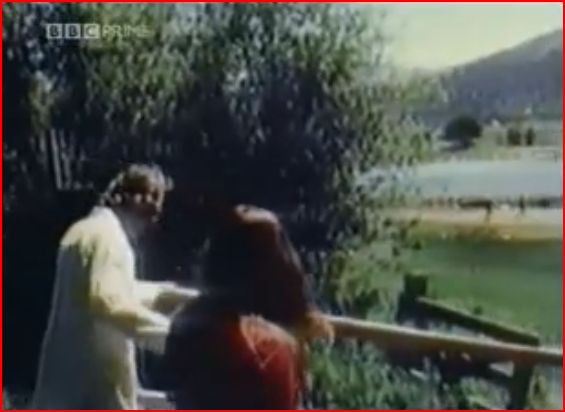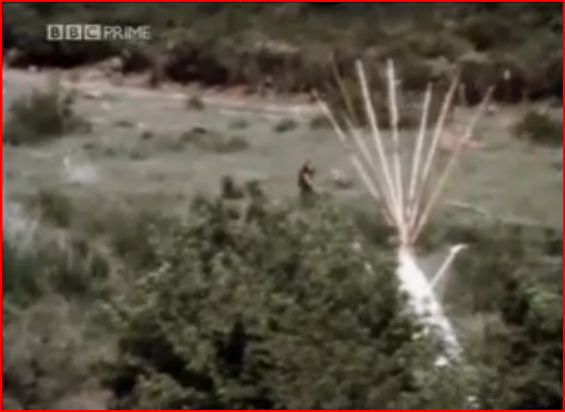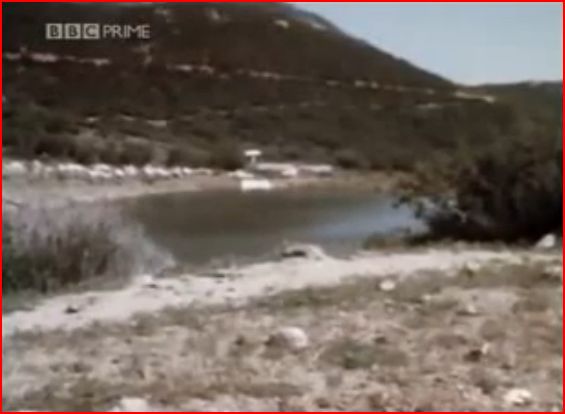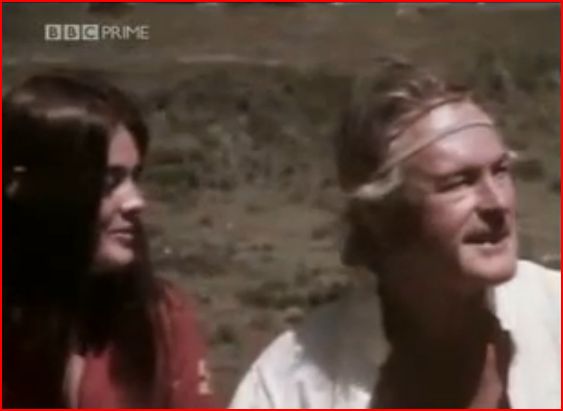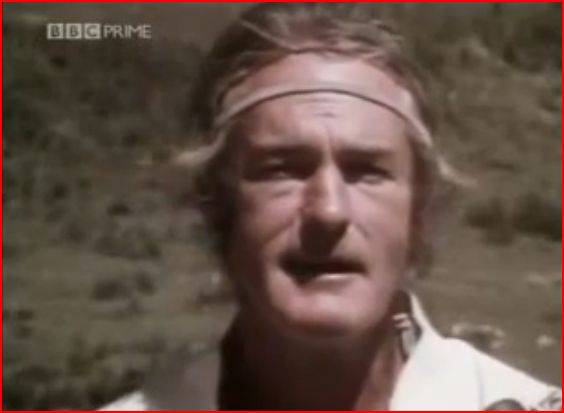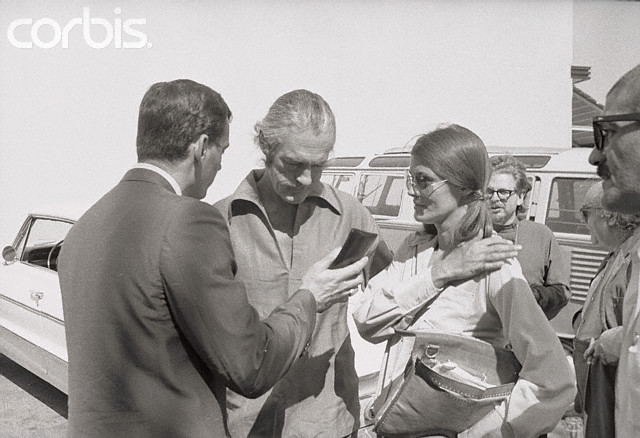Laguna Beach
WET SIDE STORY
Mystic Arts World, Dodge City, 1970 Xmas, Happening, Tim Leary, Surfing
Roger Basset Design
Mystic Arts World (1967-1970), a head shop in Laguna Beach, was ground zero for psychedelic culture in southern California during the late 1960s and early 1970s. It was there that a loosely organized group of artists interested in alternative culture, mystical experience and the transformation of society, “The Mystic Artists”, congregated and exhibited their art. Their artistic expression ranged from Beat assemblage to figuration to psychedelic art. http://stunewslaguna.com/component/content/article/16038-art-exhibit-to-feature-mystic-arts-world-040715
Artists who exhibited at the Mystic Arts World (MAW) included Carol Abrams, Isaac Abrams, Richard Aldcroft, Roger Armstrong, Jan Peters Babcock, Tom Blackwell, Mark Blumenfeld, Robert Ronnie Branaman, Jane Callender, Italo d’Andrea, Paul Darrow, Louis Delsarte, Khigh Alx Dhiegh, Philip Freeman, Ray Friesz, Louis Goodman, Reuben Greenspan, Bill Groves, George Herms, R.L. “Holly” Hollingsworth, Robert Jocko Johnson, Julie Kahn, Steve Kensrue, Karen Kozlow, Terry Lamb, Bob Laney, Ed Lutz, Robert McCarron, Joe Miller, Dwight Morouse, Jim Nussbaum, Harve Parks, Beth Pewther, Noble Richardson, Larry Rink, David Rosen, R.L. Bob Ross, Mary Riker Segal, Gayl Stenlund, Gerd Stern, Jon Stokesbary, Wiktor Sudnik, John Upton, Gordon Wagner, Andy Wing, Dion Wright, and Bob Young. A small section of the exhibition will include the posters and graphics that Bill Ogden did for the Brotherhood and Mystic Arts World.
Artists who exhibited at the Mystic Arts World (MAW) included Carol Abrams, Isaac Abrams, Richard Aldcroft, Roger Armstrong, Jan Peters Babcock, Tom Blackwell, Mark Blumenfeld, Robert Ronnie Branaman, Jane Callender, Italo d’Andrea, Paul Darrow, Louis Delsarte, Khigh Alx Dhiegh, Philip Freeman, Ray Friesz, Louis Goodman, Reuben Greenspan, Bill Groves, George Herms, R.L. “Holly” Hollingsworth, Robert Jocko Johnson, Julie Kahn, Steve Kensrue, Karen Kozlow, Terry Lamb, Bob Laney, Ed Lutz, Robert McCarron, Joe Miller, Dwight Morouse, Jim Nussbaum, Harve Parks, Beth Pewther, Noble Richardson, Larry Rink, David Rosen, R.L. Bob Ross, Mary Riker Segal, Gayl Stenlund, Gerd Stern, Jon Stokesbary, Wiktor Sudnik, John Upton, Gordon Wagner, Andy Wing, Dion Wright, and Bob Young. A small section of the exhibition will include the posters and graphics that Bill Ogden did for the Brotherhood and Mystic Arts World.
Sunshine Juice Bar
"The Brothers settled in Laguna Beach, a small seaside resort thirty miles south of Los Angeles. It was the pure scene, an electric beach community tucked against a semicircle of sandstone hills rising twelve hundred feet above the Pacific. The majestic landscape attracted an artist colony, and the sun and waves brought surfers. John Griggs supplied a lot of LSD for a growing Freaktown where hippies danced barefoot across beaches and mountains murmuring, "Thank you. God." In this exquisite setting the Brothers employed acid as a communal sacrament, hoping eventually to obtain legal permission to expand their consciousness through chemicals in much the same way that the Indians of the Native American Church used peyote. To support their spiritual habit, they opened a storefront in Laguna Beach called Mystic Arts World, which sold health food, books, smoking paraphernalia and other accoutrements of the psychedelic counterculture. The headshop became a meeting place for hippies and freaks of every persuasion, and soon more people wanted to join the fledgling church.
While Mystic Arts provided a steady income, it wasn't enough for the ambitious plans of the Brotherhood. They needed more money to purchase land for their growing membership, so they started dealing drugs—mostly marijuana at first, which they snuck across the border in hundred-pound lots after paying off police officials in
Mexico. Within the next few years the Brotherhood of Eternal Love developed into a sophisticated smuggling and distribution network that stretched around the globe. Huge quantities of hashish were brought in from Afghanistan by Brothers equipped with false ID and crew-cut wigs. They eluded the authorities by zigzagging across oceans and continents in transport outfitted with hollow compartments filled with contraband—unloading at one port, sometimes traveling a short distance overland, then reloading at the next port and substituting yet another phony registration for the vehicle. They also sold LSD obtained from Owsley's lieutenants in Haight-Ashbury.
Leary and his new wife, a young ex-model named Rosemary, had a standing invitation from John Griggs to visit Laguna Beach. He was greeted by the Brotherhood like a private heaven-sent prophet, and he acted the part, preaching to the group about love, peace, and enlightenment. Leary enjoyed the adulation as well as the town's mellow atmosphere. He and Rosemary rented a house near the ocean and spent much of their time dropping acid, lolling in the surf, and talking with the hippies on the beach. Leary was very conscious of his role as elder statesman of the town's burgeoning head colony. He tried to stay on good terms with everyone and
never missed a chance to flash his trademark grin when he saw a policeman." --Acid Dreams
While Mystic Arts provided a steady income, it wasn't enough for the ambitious plans of the Brotherhood. They needed more money to purchase land for their growing membership, so they started dealing drugs—mostly marijuana at first, which they snuck across the border in hundred-pound lots after paying off police officials in
Mexico. Within the next few years the Brotherhood of Eternal Love developed into a sophisticated smuggling and distribution network that stretched around the globe. Huge quantities of hashish were brought in from Afghanistan by Brothers equipped with false ID and crew-cut wigs. They eluded the authorities by zigzagging across oceans and continents in transport outfitted with hollow compartments filled with contraband—unloading at one port, sometimes traveling a short distance overland, then reloading at the next port and substituting yet another phony registration for the vehicle. They also sold LSD obtained from Owsley's lieutenants in Haight-Ashbury.
Leary and his new wife, a young ex-model named Rosemary, had a standing invitation from John Griggs to visit Laguna Beach. He was greeted by the Brotherhood like a private heaven-sent prophet, and he acted the part, preaching to the group about love, peace, and enlightenment. Leary enjoyed the adulation as well as the town's mellow atmosphere. He and Rosemary rented a house near the ocean and spent much of their time dropping acid, lolling in the surf, and talking with the hippies on the beach. Leary was very conscious of his role as elder statesman of the town's burgeoning head colony. He tried to stay on good terms with everyone and
never missed a chance to flash his trademark grin when he saw a policeman." --Acid Dreams
AZ Rainman
Laguna Beach is an artists' colony and resort thirty miles south of Los Angeles. There are only two roads into the town: the Pacific Coast Highway or, from inland, down Laguna Canyon. The town itself, like the Stage of an amphitheatre, sits at the base of a semicircle of sandstone hills rising to 1,200 feet above the Pacific. Amid the bright flowers and clapboard homes the hissing rush of the surf, rolling across the sand eight to twelve feet high, is the major disturber of the peace. The plastic and concrete sprawl of Los Angeles could be on another planet. The peace brought the artists—Laguna has a museum devoted to the works of early Californian painters—and the ocean brought the surfers.
In the early 1960s Laguna was a sleepy little township with the sort of mix to be found in many Californian communities. The American Legion and the Daughters of the American Revolution thrived alongside the artistic community—indeed, the local high school football team was called the Laguna Beach Artists. Once a year on Labor Day, things got a mite out of hand on the 'Walkaround', a fifty-year-old custom in which the passing of summer was mourned, by a walk from bar to bar along the Pacific Coast Highway. Other than that, not much happened in Laguna.
But in the mid-1960s, the number of young surfers was growing and they brought with them other young people eager to live a rude life away from the cities; among them were the Brotherhood. A mile from the beach, a cluster of about fifty houses made up a sub-suburb called Woodland Drive beneath one of the sandstone hills in Laguna Canyon. It was a ramshackle area of gorse and dirt tracks, running down to badly paved streets and a single street light, but it was home for the colony of youngsters. The Brotherhood moved into four white-painted houses.
The scene was painted for a journalist some years later by one of the young men who lived in the Drive: 'I went to school in Hollywood and got into surfing and just like everyone else I wound up in Laguna. Things were happening then, opening up. The chicks were seeing things and there was a lot of grass and there was a vibe that you could make it with love and digging each other... I'd go down to Laguna more and more and finally I just moved into a place on the Canyon with some chicks and a couple of other guys. It was cheap and it was fun. You know the bond, the thing that tied us up together was surfing and dope and balling. We'd get up early in the morning, stay out in the sun all day and somebody always had more grass... Then this cat Farmer John started coming around and he was really into acid. So we did a lot of acid and dug it and Farmer John was putting down a heavy brother-love rap.' Griggs, a charismatic figure, began to enlarge the Brotherhood, drawing people in to create concentric rings which spread out from the central core of Brothers who had moved into Laguna.
The Brotherhood and its apostles were no longer occasional dealers. ne business was now a full-time occupation, financing the way they lived and the opening of the Mystic Arts World Store. At first, there had been odd deals of marijuana tucked inside matchboxes—and, the next moment, consignments of kilos. They arrived in Laguna so often that Lynd for one no longer found anything strange in this new life. 'It was just an everyday occurrence. We would buy kilos of marijuana across the Mexican border and sell them to other Brothers who would turn round and sell them, with the money going to the store. Then there was the LSD sales. Different people would go up to San Francisco which was the place to buy LSD and buy it in quantity to resell in Laguna,' he said. As far as the marijuana was concerned, 'there could be anything from one kilo to as many as 300 to possibly 400 kilos at a time. I had taken kilos most likely on half a dozen occasions, possibly even a dozen occasions to places like San Francisco. Most of the money that was made was turned into the shop. Randall would collect money and Johnny Griggs would collect...'The two men were at the centre of the distribution system for the marijuana. According to Lynd, kilos were bought for $45, sold to Griggs and Randal for $65-$70, who then sold them for $100 or more. The buyers broke down the kilos to smaller dealers selling on the streets. Sales were not confined to the houses up in Woodland Drive. At night, the area round the Taco Bell fast-food stand, close to the Mystic Arts World, and crowded with surfers, beach bums and hippies, buying and trading small deals.
Lynd may have sounded nonchalant about the source of supply in Mexico, but the Brothers worked out a careful system centered on a town near Tijuana, a few miles south of San Diego. The long-haired Brothers may have seemed unlikely company for an officer in the Mexican police, but once a month they met for a quiet chat. There was not much that a policeman missed in a tiny Mexican town. A group of young Americans renting a house, coming and going with battered cars and trucks on the dusty roads in and out of town stood out among the local peasantry and the tourist buses thundering past. But a policeman has to live, even a local police chief. he had arranged their tenancy and offered to watch the house for a few dollars; for $30 a month, the Brothers paid him not to. In return for this outlay, the Brothers could buy their marijuana, hide it in the fenders of their cars and drive across the border without problems. No one seemed to bother them.
Griggs was so excited by the Brothers' successes, he would telephone Leary at Millbrook: 'Hey, Uncle Tim, we've just moved half a ton of grass and we've got some righteous acid.' The calls came in about once a week, but Leary tended to dismiss them, although Jack, his son, now in his teens, decided he would go west to California and have a look. He returned home to Millbrook filled with enthusiasm. One evening, he told his father, Griggs was counting out a stack of $1,000 bills by the light of candies. The air in Griggs' home on Woodland Drive was heavy with incense and the smell of marijuana. Jack Leary leant over, took a banknote and lit it with one of the candles. As a thousand dollars disappeared in a bright flame, black ash and the smell of burning paper, no one batted an eyelid.
But back at Millbrook, Leary was astonished. He called Griggs and offered to repay the $1,000 dollars, but Griggs would have none of it. 'Hey, Uncle Tim, we all wanted to burn a thousand-dollar bill. It was a great thing he did, very enlightening.'
Leary was becoming a frequent visitor to the West Coast as he toured the country lecturing and lobbying. When he decided to visit Laguna with Rosemary, his latest wife, he was greeted like an elder statesman and given conducted tours of the Brothers' achievements. He said: 'They were running the store which was an enormous, beautiful place. Just a group of guys who were pooling all their resources to raise consciousness. They were dedicating their lives to becoming better people. They could see it happening round the country. They were pioneers.'
Hollingshead, the man who had given Leary his first LSD experience, had returned from Britain and joined Leary in Laguna. 'The Brotherhood felt they were leading a new society,' he remembered. 'California was the country of the future. It was as if the culture had entered into them. They were responding. Righteous dealing was a sacrament, with Tim as their guru. I have always found them very gracious people, very honest, very wise—but also very naive. It was the Dead-end Kids who took acid and fell in love with beauty.' The Brothers were making money out of dealing, but Hollingshead said: 'Griggs was not thinking in those terms. He was only thinking of getting the psychedelics on the streets so that people could take them. They were totally committed. They had tremendous determination. They were all very tough; once they were moving dope, they were manic. When the stuff came from Mexico they did this non-stop thing...'
Boney Bananas at the grand opening of 'Love Animals Don't Eat Them' on July 4th, 1972.
In the early 1960s Laguna was a sleepy little township with the sort of mix to be found in many Californian communities. The American Legion and the Daughters of the American Revolution thrived alongside the artistic community—indeed, the local high school football team was called the Laguna Beach Artists. Once a year on Labor Day, things got a mite out of hand on the 'Walkaround', a fifty-year-old custom in which the passing of summer was mourned, by a walk from bar to bar along the Pacific Coast Highway. Other than that, not much happened in Laguna.
But in the mid-1960s, the number of young surfers was growing and they brought with them other young people eager to live a rude life away from the cities; among them were the Brotherhood. A mile from the beach, a cluster of about fifty houses made up a sub-suburb called Woodland Drive beneath one of the sandstone hills in Laguna Canyon. It was a ramshackle area of gorse and dirt tracks, running down to badly paved streets and a single street light, but it was home for the colony of youngsters. The Brotherhood moved into four white-painted houses.
The scene was painted for a journalist some years later by one of the young men who lived in the Drive: 'I went to school in Hollywood and got into surfing and just like everyone else I wound up in Laguna. Things were happening then, opening up. The chicks were seeing things and there was a lot of grass and there was a vibe that you could make it with love and digging each other... I'd go down to Laguna more and more and finally I just moved into a place on the Canyon with some chicks and a couple of other guys. It was cheap and it was fun. You know the bond, the thing that tied us up together was surfing and dope and balling. We'd get up early in the morning, stay out in the sun all day and somebody always had more grass... Then this cat Farmer John started coming around and he was really into acid. So we did a lot of acid and dug it and Farmer John was putting down a heavy brother-love rap.' Griggs, a charismatic figure, began to enlarge the Brotherhood, drawing people in to create concentric rings which spread out from the central core of Brothers who had moved into Laguna.
The Brotherhood and its apostles were no longer occasional dealers. ne business was now a full-time occupation, financing the way they lived and the opening of the Mystic Arts World Store. At first, there had been odd deals of marijuana tucked inside matchboxes—and, the next moment, consignments of kilos. They arrived in Laguna so often that Lynd for one no longer found anything strange in this new life. 'It was just an everyday occurrence. We would buy kilos of marijuana across the Mexican border and sell them to other Brothers who would turn round and sell them, with the money going to the store. Then there was the LSD sales. Different people would go up to San Francisco which was the place to buy LSD and buy it in quantity to resell in Laguna,' he said. As far as the marijuana was concerned, 'there could be anything from one kilo to as many as 300 to possibly 400 kilos at a time. I had taken kilos most likely on half a dozen occasions, possibly even a dozen occasions to places like San Francisco. Most of the money that was made was turned into the shop. Randall would collect money and Johnny Griggs would collect...'The two men were at the centre of the distribution system for the marijuana. According to Lynd, kilos were bought for $45, sold to Griggs and Randal for $65-$70, who then sold them for $100 or more. The buyers broke down the kilos to smaller dealers selling on the streets. Sales were not confined to the houses up in Woodland Drive. At night, the area round the Taco Bell fast-food stand, close to the Mystic Arts World, and crowded with surfers, beach bums and hippies, buying and trading small deals.
Lynd may have sounded nonchalant about the source of supply in Mexico, but the Brothers worked out a careful system centered on a town near Tijuana, a few miles south of San Diego. The long-haired Brothers may have seemed unlikely company for an officer in the Mexican police, but once a month they met for a quiet chat. There was not much that a policeman missed in a tiny Mexican town. A group of young Americans renting a house, coming and going with battered cars and trucks on the dusty roads in and out of town stood out among the local peasantry and the tourist buses thundering past. But a policeman has to live, even a local police chief. he had arranged their tenancy and offered to watch the house for a few dollars; for $30 a month, the Brothers paid him not to. In return for this outlay, the Brothers could buy their marijuana, hide it in the fenders of their cars and drive across the border without problems. No one seemed to bother them.
Griggs was so excited by the Brothers' successes, he would telephone Leary at Millbrook: 'Hey, Uncle Tim, we've just moved half a ton of grass and we've got some righteous acid.' The calls came in about once a week, but Leary tended to dismiss them, although Jack, his son, now in his teens, decided he would go west to California and have a look. He returned home to Millbrook filled with enthusiasm. One evening, he told his father, Griggs was counting out a stack of $1,000 bills by the light of candies. The air in Griggs' home on Woodland Drive was heavy with incense and the smell of marijuana. Jack Leary leant over, took a banknote and lit it with one of the candles. As a thousand dollars disappeared in a bright flame, black ash and the smell of burning paper, no one batted an eyelid.
But back at Millbrook, Leary was astonished. He called Griggs and offered to repay the $1,000 dollars, but Griggs would have none of it. 'Hey, Uncle Tim, we all wanted to burn a thousand-dollar bill. It was a great thing he did, very enlightening.'
Leary was becoming a frequent visitor to the West Coast as he toured the country lecturing and lobbying. When he decided to visit Laguna with Rosemary, his latest wife, he was greeted like an elder statesman and given conducted tours of the Brothers' achievements. He said: 'They were running the store which was an enormous, beautiful place. Just a group of guys who were pooling all their resources to raise consciousness. They were dedicating their lives to becoming better people. They could see it happening round the country. They were pioneers.'
Hollingshead, the man who had given Leary his first LSD experience, had returned from Britain and joined Leary in Laguna. 'The Brotherhood felt they were leading a new society,' he remembered. 'California was the country of the future. It was as if the culture had entered into them. They were responding. Righteous dealing was a sacrament, with Tim as their guru. I have always found them very gracious people, very honest, very wise—but also very naive. It was the Dead-end Kids who took acid and fell in love with beauty.' The Brothers were making money out of dealing, but Hollingshead said: 'Griggs was not thinking in those terms. He was only thinking of getting the psychedelics on the streets so that people could take them. They were totally committed. They had tremendous determination. They were all very tough; once they were moving dope, they were manic. When the stuff came from Mexico they did this non-stop thing...'
Boney Bananas at the grand opening of 'Love Animals Don't Eat Them' on July 4th, 1972.
|
|
|
The Greeter; Flashbacks
Dude, Spare Me the Trip Reports
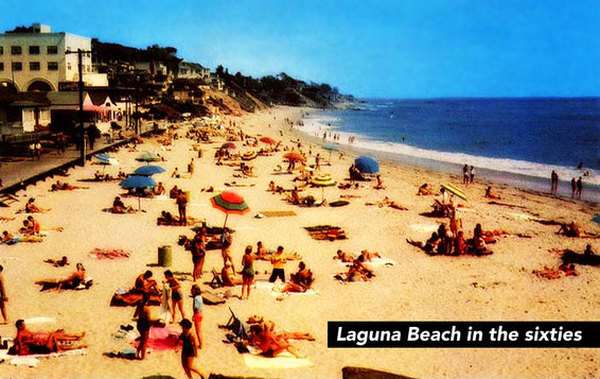
1960s: We buzzed up and down Hwy 1 in our white Renault Caravelle Cabrio, the hot car in Paris at the time. Other times we rode in our boyfriends' surf wagons. I remember the foggy drives through Laguna Canyon, survivable only by intuitive second-sight. Because I had relatives there, I was already familiar with the twisting roads. I also have fond memories of the 'Jonah in the Whale' Cave at 1000 Steps Beach. When you sat in it, it felt like being in the belly of a whale. We also loved the 7 sea caves in La Jolla. We partied in Los Trancos, a historic district of 1930s style houses and in the cliff villas.
Maybe there would be a Leary sighting. The twist in BEL's philosophy was that they smuggled hash to pay to make more acid they virtually gave away. They believed their panacea would change the world. Or, at least, that was the story. First they got their legs wet, smuggling pot from Sinaloa, Mexico in rainbow surfboards, then they went to Afghanistan for hash.
BEL's stained-glass shopfront pleasure palace cum headshop, "Mystic Arts World", became a hippie Mecca that stalled traffic on Hwy. 101. You never saw so many beads in your life. Tim Leary declared his candidacy for California Governor from there in 1969. Being young and naive at the time, I had no idea we were partying with what would later be called "the hippie Mafia" by Rolling Stone magazine. That is, until my cousin married one of them.
The Original "Mystic Arts World" is arguably one of the first Organic Spiritual Centers, offering vegetarian health foods and herbs, incense, art, jewelry, beads, a mystic book store, secret stash rooms, and Holy Sacraments with a private Meditation Temple for members of the BEL.
Maybe there would be a Leary sighting. The twist in BEL's philosophy was that they smuggled hash to pay to make more acid they virtually gave away. They believed their panacea would change the world. Or, at least, that was the story. First they got their legs wet, smuggling pot from Sinaloa, Mexico in rainbow surfboards, then they went to Afghanistan for hash.
BEL's stained-glass shopfront pleasure palace cum headshop, "Mystic Arts World", became a hippie Mecca that stalled traffic on Hwy. 101. You never saw so many beads in your life. Tim Leary declared his candidacy for California Governor from there in 1969. Being young and naive at the time, I had no idea we were partying with what would later be called "the hippie Mafia" by Rolling Stone magazine. That is, until my cousin married one of them.
The Original "Mystic Arts World" is arguably one of the first Organic Spiritual Centers, offering vegetarian health foods and herbs, incense, art, jewelry, beads, a mystic book store, secret stash rooms, and Holy Sacraments with a private Meditation Temple for members of the BEL.
The Second Psychedelic Revolution Part Two: Alexander ‘Sasha’ Shulgin, The Psychedelic Godfather
by James Oroc
At a testimonial dinner for the Shulgins in 2010 at the MAPS conference in San Jose, CA, the underground chemist Nick Sand (who had only recently been released from jail), and who (along with Tim Scully, who was Owsley’s chemist) is often credited with the ‘invention’ of Orange Sunshine LSD, revealed that in 1966, after LSD had been made illegal in California thanks to the newly elected Governor Ronald Reagan, the precursors required for creating LSD under the methods of the day dried up, and for a short time LSD actually disappeared and much like would happen some twenty four years later in 2000, it appeared as if there could be ‘an End to Acid’.
According to the historical record, Sand and Scully then started manufacturing DOM (street name STP), an extraordinarily powerful psychedelic phenethylamine invented by Shulgin in 1964. Five thousand ‘doses’ of this new compound were given away at the first Human Be-In in San Francisco (Jan 14th, 1967) in an effort to promote the new drug as a ‘replacement’ to LSD, but unfortunately they (Sand and Scully) had apparently developed a tolerance to DOM, and reputedly made the dosages too high. This combined with the fact that the onset of DOM was much slower than LSD, with many people reportedly making the mistake of taking a second hit after an hour or so with little effect, caused numerous users to overdose and sent scores of ‘tripping hippies’ to the city’s emergency rooms. The press then further demonized LSD by reporting that this was the compound responsible.
Perhaps due to the aftermath of the Human Be-In debacle, Nick Sand and Tim Scully were then given a formula for a new method of manufacturing LSD that got around the constraints of the old method; they were told that it was from a ‘friend’, an ally who believed in what they were doing, but couldn’t be revealed at that time. At the MAPS testimonial dinner for the Shulgins in 2010, in a startling revelation whose importance somewhat slipped by most of the gathered audience and as far as I know has never been reported, Nick Sand identified that mysterious ‘friend’ as Sasha.
Assuming this is true—and obviously Nick Sand would have no reason to make up a story like that—this means that along with popularizing MDMA, and inventing literally hundreds of psychedelic and empathogenic compounds that have surfaced with increasing regularity in the 21st century, Alexander Shulgin was also the inventor of Orange Sunshine LSD, which was by far the most commonly manufactured LSD from the late 1960’s onward (Orange Sunshine is estimated to have been over 75% of the worlds LSD). Or to put it another way, while Albert Hoffman invented LSD, it can now be said that it was thanks to Sasha (and the bravery of Nick Sand, Tim Scully, and the Brotherhood of Eternal Love) that it was available from 1967 on!
http://www.rigorousintuition.ca/board2/viewtopic.php?t=32959&p=538099
by James Oroc
At a testimonial dinner for the Shulgins in 2010 at the MAPS conference in San Jose, CA, the underground chemist Nick Sand (who had only recently been released from jail), and who (along with Tim Scully, who was Owsley’s chemist) is often credited with the ‘invention’ of Orange Sunshine LSD, revealed that in 1966, after LSD had been made illegal in California thanks to the newly elected Governor Ronald Reagan, the precursors required for creating LSD under the methods of the day dried up, and for a short time LSD actually disappeared and much like would happen some twenty four years later in 2000, it appeared as if there could be ‘an End to Acid’.
According to the historical record, Sand and Scully then started manufacturing DOM (street name STP), an extraordinarily powerful psychedelic phenethylamine invented by Shulgin in 1964. Five thousand ‘doses’ of this new compound were given away at the first Human Be-In in San Francisco (Jan 14th, 1967) in an effort to promote the new drug as a ‘replacement’ to LSD, but unfortunately they (Sand and Scully) had apparently developed a tolerance to DOM, and reputedly made the dosages too high. This combined with the fact that the onset of DOM was much slower than LSD, with many people reportedly making the mistake of taking a second hit after an hour or so with little effect, caused numerous users to overdose and sent scores of ‘tripping hippies’ to the city’s emergency rooms. The press then further demonized LSD by reporting that this was the compound responsible.
Perhaps due to the aftermath of the Human Be-In debacle, Nick Sand and Tim Scully were then given a formula for a new method of manufacturing LSD that got around the constraints of the old method; they were told that it was from a ‘friend’, an ally who believed in what they were doing, but couldn’t be revealed at that time. At the MAPS testimonial dinner for the Shulgins in 2010, in a startling revelation whose importance somewhat slipped by most of the gathered audience and as far as I know has never been reported, Nick Sand identified that mysterious ‘friend’ as Sasha.
Assuming this is true—and obviously Nick Sand would have no reason to make up a story like that—this means that along with popularizing MDMA, and inventing literally hundreds of psychedelic and empathogenic compounds that have surfaced with increasing regularity in the 21st century, Alexander Shulgin was also the inventor of Orange Sunshine LSD, which was by far the most commonly manufactured LSD from the late 1960’s onward (Orange Sunshine is estimated to have been over 75% of the worlds LSD). Or to put it another way, while Albert Hoffman invented LSD, it can now be said that it was thanks to Sasha (and the bravery of Nick Sand, Tim Scully, and the Brotherhood of Eternal Love) that it was available from 1967 on!
http://www.rigorousintuition.ca/board2/viewtopic.php?t=32959&p=538099
Dodge City
Mystic Arts World, Headshop / Art Gallery
The year was 1969, and Laguna Beach, once the sleepy refuge of surfers, artists, and bohemians of little consequence, was a center of counterculture foment after a band of outlaws and outcasts went up a mountain with LSD and came down as messengers of love, peace and the transformational qualities of acid and hash. They called themselves the Brotherhood of Eternal Love, and Mystic Arts World was their public face, a hippie hangout where vegetarianism, Buddhism, meditation and all sorts of Aquarian ideals spread like gospel.
http://slake.la/features/the-pirate-of-penance
http://slake.la/features/the-pirate-of-penance
Turn Off Your Mind, Relax and Float Downstream..."
TERRY LAMB
http://www.terrylambart.com/
http://www.terrylambart.com/
http://www.druglibrary.net/schaffer/lsd/books/bel3.htm
The Mystic Arts World Store was opposite a Mexican fast-food stand on South Laguna Beach. At the front it sold the sort of things to be found in a thousand similar stores that were sprouting up across the America of 1966 and 1967—home-made clothes, natural foods, leatherware, brass, tapestries, pipes and papers for marijuana smoking: another 'head shop', a sort of frontier store for America's newest pioneers, the hippies; a corner shop for the colony of young people moving into Laguna Beach, south of Los Angeles, to enjoy a 'Haight-Ashbury on sea'.
But the real business of Mystic Arts lay at the back in the meditation room. The floor was covered from wall to wall by foam rubber overlaid with thick carpeting, making visitors feel as though they were walking on a huge, luxurious bed. At one end, a small waterfall tumbled into an indoor rock garden. The sound was soft and rhythmic, lulling. In another corner stood a water pipe. Scatter cushions had been left here and there for customers, who removed their shoes before entering, to loll at their ease. A group of young men in their twenties might be sitting round at the beginning of an LSD session: their hair was long; they wore patched jeans and loose shirts, embroidered waistcoats over painted T-shirts and single strings of thick, crude beads. Some had the deep sunburn that you find in this part of California on surfers, where the heat of the sun has burnt into the skin, magnified by the sea-water, and left a rich tan. Others had the thick-set, hard-muscled build of mechanics.
They were men with a cause, yet theirs was not quite the burning ardor of the radicals elsewhere in the country, streaming across the campuses towards the administration blocks and screaming against betrayal, grappling with the police as they denounced L.B.J. and vowing they would never fight in Vietnam. Theirs was another kind of fervor: there was no violence, just the unswerving confidence of missionaries going about their work.
The meditation room was, on occasion, the private chapel of the Brotherhood of Eternal Love, a legally incorporated religious charity. At other times it was the front office of the Brotherhood of Eternal Love, drug dealers extraordinary. The essence of the Brotherhood might well be summed up in Owsley's 'chemistry is theology'.
The man to watch at the LSD sessions was a short, stocky character wearing a Hopi Indian headband and flowing green Eastern trousers and shirt. John Griggs, dark and intense with bright blue eyes, was the founding figure of the Brotherhood: a man who had discovered LSD in dramatic circumstances.
At the time, Griggs, approaching his middle twenties, was the leader of a marijuana-smoking south Los Angeles motorcycle gang, preying on supermarkets. Largely unschooled, Griggs was a wandering adventurer who had earned the name of 'Farmer John' after disappearing into the Californian mountains to live as a trapper. He rode with his pack along the freeways and highways that criss-crossed Los Angeles in search of fresh excitement. On a summer night he led his gang through Hollywood towards Beverly Hills and Mulholland Drive. According to the grapevine, a well-known Hollywood film producer up there kept a cache of pure LSD in his refrigerator. Griggs and the gang decided it was time they tried this LSD stuff everyone was talking about.
They burst in on the producer during a dinner party. All the guests froze as the gang, armed with guns and knives, came out of the darkness... but all they wanted was the LSD, and they took it. The host was so relieved that he rushed out to the driveway as they started up their motorcycles and cried after them: 'Have a great trip, boys. Jesus, I thought it was something serious.'
The gang roared out of Los Angeles towards the vast, high acres of Joshua Tree National Park beyond the city. They climbed higher and higher into the hills among the yucca trees until they were above Palm Springs and, at midnight, they came to a halt. Motorcycles parked in a group, they stood round in the clear, sharp mountain air and shared out the LSD, made by Sandoz. Each man swallowed the equivalent of 1,000 micrograms, four times a normal dose, and wandered off to await the result. It was cold and the yuccas with their twisted stems and shrouds of dead leaves cast fantastic shapes in the gloom.
As the sun burst across the sky at dawn, hours later, Griggs threw his gun into the dry scrub and shouted: 'This is it. This is it.' The gang regrouped round their motorbikes, shaken and overwhelmed. All had thrown away their weapons. They started home for Anaheim, a flat Los Angeles suburb of pale-coloured houses, and what was to be a new life.
Griggs was the proselytizer, the moving spirit. He talked to old schoolfriends like Glen Lynd and Calvin Delaney. Lynd had already tried marijuana and now took the LSD Griggs passed on to him. Like Griggs, Lynd was in his middle twenties and something of a drifter. The group that began to assemble totalled nine. Most of the young men, all in their early or middle twenties, came from Anaheim. Michael Randall was from Long Beach, although he had attended Anaheim Western High School. He started smoking marijuana in 1963 but remained on the edge of the group, since, he was finishing a course in business administration at California State College.
At first, the group did little more than meet at the weekends to try out the psychedelics, but Griggs had wider visions. He urged the others to move with him out of Los Angeles, east to Modjeska Canyon, in the countryside beyond the city. The group shared a couple of houses, feeling, like Alpert and Leary had felt at Harvard, that they had 'something wonderful in common'. Those who had jobs continued to work—Russ Harrigan for example was a longshoreman—but all now began a little drug dealing as well. Lynd and Harrigan went down to San Pedro with the odd kilo of marijuana brought back from trips to Mexico, and all the group sold LSD from San Francisco to visitors to Modjeska Canyon. Several of them enrolled in research programs at the University of California, Los Angeles, in order to continue using the psychedelics for free.
But on Wednesday nights they came together to talk about their futures. Lynd said later: 'There was hopeful thought of buying land... the purpose was to buy it so people could live on it. We could farm it or whatever.' Plans began to form round the notion. Lynd had heard Leary lecturing and had been impressed. Griggs went east to meet him at Millbrook. Leary was taken with him: 'an incredible genius' was how he described Griggs; 'although unschooled and unlettered he was an impressive person. He had this charisma, energy, that sparkle in his eye. He was good-natured, surfing the energy waves with a smile on his face.' As far as Griggs was concerned, Leary was his guru, one with some useful practical ideas.
In the summer of 1966 when Griggs went to Millbrook, Leary was working on his plans for the formation of the League of Spiritual Discovery. Griggs and his friends seemed to have a good thing going out there in the West, so why not set up something similar? The new psychedelic religion was not something all-embracing and spiritually omnipotent. There was no Pope to set out the prescribed dogma. This religion was about a new kind of spiritual freedom which you found for yourself. The basic tenets of the League included: 'enthusiastic acceptance of the sacramental method by the young... a recognition that the search for God is a private affair... the rituals spring from experiences of the small worship group... the leaven works underground... friends initiate, teach, prepare and guide...'
Ten days after California banned LSD in October 1966, Lynd, his wife and a friend walked into the offices of a Los Angeles attorney on Sunset Boulevard and signed the papers incorporating the Brotherhood; Lynd was the only Brother who did not have a criminal record, so he was designated to organize the incorporation. According to the legal papers, the Brotherhood, tax exempt, was dedicated 'to bring to the world a greater awareness of God through the teachings of Jesus Christ, Rama-Krishnam Babaji, Paramahansa Yogananda, Mahatma Gandhi and all true prophets and apostles of God'. Was there a hint of Leary's influence in this list? Griggs had recently returned from a trip to the East, and the Brothers were largely 'unschooled'.
To achieve its ends, the Brotherhood intended to 'buy, manage and own and hold real and personal property necessary and proper for a place of public worship and carry on educational and charitable work'. Was there an echo of the League's tenets in article 4-D which read: 'We believe in the sacred right of each individual to commune with God in spirit and in truth as it is empirically revealed to him'? This was 'a recognition that the search for God is a private matter', written another way.
Lynd said years later: 'Well, it was John Griggs' main idea to incorporate because he had talked to Leary, and it was possible to incorporate to become tax-exempt as far as land goes and, if and when marijuana ever becomes legal, become tax-exempt on marijuana.' There were no fixed rules for joining; no name signing or ritual. But there was one basic rule among the Brothers—they believed in taking as much of the psychedelics as possible, the largest doses of LSD they could buy. The articles of association did not explain how the Brotherhood intended to buy its land or establish its place of worship. You cannot really tell a lawyer or the State of California that you intend to raise capital by breaking the law—by massive dealing in drugs.
Laguna Beach is an artists' colony and resort thirty miles south of Los Angeles. There are only two roads into the town: the Pacific Coast Highway or, from inland, down Laguna Canyon. The town itself, like the Stage of an amphitheatre, sits at the base of a semicircle of sandstone hills rising to 1,200 feet above the Pacific. Amid the bright flowers and clapboard homes the hissing rush of the surf, rolling across the sand eight to twelve feet high, is the major disturber of the peace. The plastic and concrete sprawl of Los Angeles could be on another planet. The peace brought the artists—Laguna has a museum devoted to the works of early Californian painters—and the ocean brought the surfers.
In the early 1960s Laguna was a sleepy little township with the sort of mix to be found in many Californian communities. The American Legion and the Daughters of the American Revolution thrived alongside the artistic community—indeed, the local high school football team was called the Laguna Beach Artists. Once a year on Labor Day, things got a mite out of hand on the 'Walkaround', a fifty-year-old custom in which the passing of summer was mourned, by a walk from bar to bar along the Pacific Coast Highway. Other than that, not much happened in Laguna.
But in the mid-1960s, the number of young surfers was growing and they brought with them other young people eager to live a rude life away from the cities; among them were the Brotherhood. A mile from the beach, a cluster of about fifty houses made up a sub-suburb called Woodland Drive beneath one of the sandstone hills in Laguna Canyon. It was a ramshackle area of gorse and dirt tracks, running down to badly paved streets and a single street light, but it was home for the colony of youngsters. The Brotherhood moved into four white-painted houses.
The scene was painted for a journalist some years later by one of the young men who lived in the Drive: 'I went to school in Hollywood and got into surfing and just like everyone else I wound up in Laguna. Things were happening then, opening up. The chicks were seeing things and there was a lot of grass and there was a vibe that you could make it with love and digging each other... I'd go down to Laguna more and more and finally I just moved into a place on the Canyon with some chicks and a couple of other guys. It was cheap and it was fun. You know the bond, the thing that tied us up together was surfing and dope and balling. We'd get up early in the morning, stay out in the sun all day and somebody always had more grass... Then this cat Farmer John started coming around and he was really into acid. So we did a lot of acid and dug it and Farmer John was putting down a heavy brother-love rap.' Griggs, a charismatic figure, began to enlarge the Brotherhood, drawing people in to create concentric rings which spread out from the central core of Brothers who had moved into Laguna.
The Brotherhood and its apostles were no longer occasional dealers. ne business was now a full-time occupation, financing the way they lived and the opening of the Mystic Arts World Store. At first, there had been odd deals of marijuana tucked inside matchboxes—and, the next moment, consignments of kilos. They arrived in Laguna so often that Lynd for one no longer found anything strange in this new life. 'It was just an everyday occurrence. We would buy kilos of marijuana across the Mexican border and sell them to other Brothers who would turn round and sell them, with the money going to the store. Then there was the LSD sales. Different people would go up to San Francisco which was the place to buy LSD and buy it in quantity to resell in Laguna,' he said.
As far as the marijuana was concerned, 'there could be anything from one kilo to as many as 300 to possibly 400 kilos at a time. I had taken kilos most likely on half a dozen occasions, possibly even a dozen occasions to places like San Francisco. Most of the money that was made was turned into the shop. Randall would collect money and Johnny Griggs would collect...'The two men were at the centre of the distribution system for the marijuana. According to Lynd, kilos were bought for $45, sold to Griggs and Randal for $65-$70, who then sold them for $100 or more. The buyers broke down the kilos to smaller dealers selling on the streets. Sales were not confined to the houses up in Woodland Drive. At night, the area round the Taco Bell fast-food stand, close to the Mystic Arts World, and crowded with surfers, beach bums and hippies, buying and trading small deals.
Lynd may have sounded nonchalant about the source of supply in Mexico, but the Brothers worked out a careful system centred on a town near Tijuana, a few miles south of San Diego. The long-haired Brothers may have seemed unlikely company for an officer in the Mexican police, but once a month they met for a quiet chat. There was not much that a policeman missed in a tiny Mexican town. A group of young Americans renting a house, coming and going with battered cars and trucks on the dusty roads in and out of town stood out among the local peasantry and the tourist buses thundering past. But a policeman has to live, even a local police chief. He had arranged their tenancy and offered to watch the house for a few dollars; for $30 a month, the Brothers paid him not to. In return for this outlay, the Brothers could buy their marijuana, hide it in the fenders of their cars and drive across the border without problems. No one seemed to bother them.
Griggs was so excited by the Brothers' successes, he would telephone Leary at Millbrook: 'Hey, Uncle Tim, we've just moved half a ton of grass and we've got some righteous acid.' The calls came in about once a week, but Leary tended to dismiss them, although Jack, his son, now in his teens, decided he would go west to California and have a look. He returned home to Millbrook filled with enthusiasm. One evening, he told his father, Griggs was counting out a stack of $1,000 bills by the light of candies. The air in Griggs' home on Woodland Drive was heavy with incense and the smell of marijuana. Jack Leary leant over, took a banknote and lit it with one of the candles. As a thousand dollars disappeared in a bright flame, black ash and the smell of burning paper, no one batted an eyelid.
But back at Millbrook, Leary was astonished. He called Griggs and offered to repay the $1,000 dollars, but Griggs would have none of it. 'Hey, Uncle Tim, we all wanted to burn a thousand-dollar bill. It was a great thing he did, very enlightening.'
Leary was becoming a frequent visitor to the West Coast as he toured the country lecturing and lobbying. When he decided to visit Laguna with Rosemary, his latest wife, he was greeted like an elder statesman and given conducted tours of the Brothers' achievements. He said: 'They were running the store which was an enormous, beautiful place. Just a group of guys who were pooling all their resources to raise consciousness. They were dedicating their lives to becoming better people. They could see it happening round the country. They were pioneers.'
Hollingshead, the man who had given Leary his first LSD experience, had returned from Britain and joined Leary in Laguna. 'The Brotherhood felt they were leading a new society,' he remembered. 'California was the country of the future. It was as if the culture had entered into them. They were responding. Righteous dealing was a sacrament, with Tim as their guru. I have always found them very gracious people, very honest, very wise—but also very naive. It was the Dead-end Kids who took acid and fell in love with beauty.' The Brothers were making money out of dealing, but Hollingshead said: 'Griggs was not thinking in those terms. He was only thinking of getting the psychedelics on the streets so that people could take them. They were totally committed. They had tremendous determination. They were all very tough; once they were moving dope, they were manic. When the stuff came from Mexico they did this non-stop thing...'
http://www.druglibrary.net/schaffer/lsd/books/bel3.htm
At Christmas 1969, the Mystic Arts World Store burned down in circumstances no one could ever explain. The fire was not considered a terrible loss. The idea of eventually living off the profits of the shop had been doomed by the drugs that were dealt to get it started. Everyone grew too fascinated in drug dealing to want to serve in the store. As the smoke cleared, the Brothers with the rest of the psychedelic movement were heading towards the Badlands where outlaws survive—at a price.
The Mystic Arts World Store was opposite a Mexican fast-food stand on South Laguna Beach. At the front it sold the sort of things to be found in a thousand similar stores that were sprouting up across the America of 1966 and 1967—home-made clothes, natural foods, leatherware, brass, tapestries, pipes and papers for marijuana smoking: another 'head shop', a sort of frontier store for America's newest pioneers, the hippies; a corner shop for the colony of young people moving into Laguna Beach, south of Los Angeles, to enjoy a 'Haight-Ashbury on sea'.
But the real business of Mystic Arts lay at the back in the meditation room. The floor was covered from wall to wall by foam rubber overlaid with thick carpeting, making visitors feel as though they were walking on a huge, luxurious bed. At one end, a small waterfall tumbled into an indoor rock garden. The sound was soft and rhythmic, lulling. In another corner stood a water pipe. Scatter cushions had been left here and there for customers, who removed their shoes before entering, to loll at their ease. A group of young men in their twenties might be sitting round at the beginning of an LSD session: their hair was long; they wore patched jeans and loose shirts, embroidered waistcoats over painted T-shirts and single strings of thick, crude beads. Some had the deep sunburn that you find in this part of California on surfers, where the heat of the sun has burnt into the skin, magnified by the sea-water, and left a rich tan. Others had the thick-set, hard-muscled build of mechanics.
They were men with a cause, yet theirs was not quite the burning ardor of the radicals elsewhere in the country, streaming across the campuses towards the administration blocks and screaming against betrayal, grappling with the police as they denounced L.B.J. and vowing they would never fight in Vietnam. Theirs was another kind of fervor: there was no violence, just the unswerving confidence of missionaries going about their work.
The meditation room was, on occasion, the private chapel of the Brotherhood of Eternal Love, a legally incorporated religious charity. At other times it was the front office of the Brotherhood of Eternal Love, drug dealers extraordinary. The essence of the Brotherhood might well be summed up in Owsley's 'chemistry is theology'.
The man to watch at the LSD sessions was a short, stocky character wearing a Hopi Indian headband and flowing green Eastern trousers and shirt. John Griggs, dark and intense with bright blue eyes, was the founding figure of the Brotherhood: a man who had discovered LSD in dramatic circumstances.
At the time, Griggs, approaching his middle twenties, was the leader of a marijuana-smoking south Los Angeles motorcycle gang, preying on supermarkets. Largely unschooled, Griggs was a wandering adventurer who had earned the name of 'Farmer John' after disappearing into the Californian mountains to live as a trapper. He rode with his pack along the freeways and highways that criss-crossed Los Angeles in search of fresh excitement. On a summer night he led his gang through Hollywood towards Beverly Hills and Mulholland Drive. According to the grapevine, a well-known Hollywood film producer up there kept a cache of pure LSD in his refrigerator. Griggs and the gang decided it was time they tried this LSD stuff everyone was talking about.
They burst in on the producer during a dinner party. All the guests froze as the gang, armed with guns and knives, came out of the darkness... but all they wanted was the LSD, and they took it. The host was so relieved that he rushed out to the driveway as they started up their motorcycles and cried after them: 'Have a great trip, boys. Jesus, I thought it was something serious.'
The gang roared out of Los Angeles towards the vast, high acres of Joshua Tree National Park beyond the city. They climbed higher and higher into the hills among the yucca trees until they were above Palm Springs and, at midnight, they came to a halt. Motorcycles parked in a group, they stood round in the clear, sharp mountain air and shared out the LSD, made by Sandoz. Each man swallowed the equivalent of 1,000 micrograms, four times a normal dose, and wandered off to await the result. It was cold and the yuccas with their twisted stems and shrouds of dead leaves cast fantastic shapes in the gloom.
As the sun burst across the sky at dawn, hours later, Griggs threw his gun into the dry scrub and shouted: 'This is it. This is it.' The gang regrouped round their motorbikes, shaken and overwhelmed. All had thrown away their weapons. They started home for Anaheim, a flat Los Angeles suburb of pale-coloured houses, and what was to be a new life.
Griggs was the proselytizer, the moving spirit. He talked to old schoolfriends like Glen Lynd and Calvin Delaney. Lynd had already tried marijuana and now took the LSD Griggs passed on to him. Like Griggs, Lynd was in his middle twenties and something of a drifter. The group that began to assemble totalled nine. Most of the young men, all in their early or middle twenties, came from Anaheim. Michael Randall was from Long Beach, although he had attended Anaheim Western High School. He started smoking marijuana in 1963 but remained on the edge of the group, since, he was finishing a course in business administration at California State College.
At first, the group did little more than meet at the weekends to try out the psychedelics, but Griggs had wider visions. He urged the others to move with him out of Los Angeles, east to Modjeska Canyon, in the countryside beyond the city. The group shared a couple of houses, feeling, like Alpert and Leary had felt at Harvard, that they had 'something wonderful in common'. Those who had jobs continued to work—Russ Harrigan for example was a longshoreman—but all now began a little drug dealing as well. Lynd and Harrigan went down to San Pedro with the odd kilo of marijuana brought back from trips to Mexico, and all the group sold LSD from San Francisco to visitors to Modjeska Canyon. Several of them enrolled in research programs at the University of California, Los Angeles, in order to continue using the psychedelics for free.
But on Wednesday nights they came together to talk about their futures. Lynd said later: 'There was hopeful thought of buying land... the purpose was to buy it so people could live on it. We could farm it or whatever.' Plans began to form round the notion. Lynd had heard Leary lecturing and had been impressed. Griggs went east to meet him at Millbrook. Leary was taken with him: 'an incredible genius' was how he described Griggs; 'although unschooled and unlettered he was an impressive person. He had this charisma, energy, that sparkle in his eye. He was good-natured, surfing the energy waves with a smile on his face.' As far as Griggs was concerned, Leary was his guru, one with some useful practical ideas.
In the summer of 1966 when Griggs went to Millbrook, Leary was working on his plans for the formation of the League of Spiritual Discovery. Griggs and his friends seemed to have a good thing going out there in the West, so why not set up something similar? The new psychedelic religion was not something all-embracing and spiritually omnipotent. There was no Pope to set out the prescribed dogma. This religion was about a new kind of spiritual freedom which you found for yourself. The basic tenets of the League included: 'enthusiastic acceptance of the sacramental method by the young... a recognition that the search for God is a private affair... the rituals spring from experiences of the small worship group... the leaven works underground... friends initiate, teach, prepare and guide...'
Ten days after California banned LSD in October 1966, Lynd, his wife and a friend walked into the offices of a Los Angeles attorney on Sunset Boulevard and signed the papers incorporating the Brotherhood; Lynd was the only Brother who did not have a criminal record, so he was designated to organize the incorporation. According to the legal papers, the Brotherhood, tax exempt, was dedicated 'to bring to the world a greater awareness of God through the teachings of Jesus Christ, Rama-Krishnam Babaji, Paramahansa Yogananda, Mahatma Gandhi and all true prophets and apostles of God'. Was there a hint of Leary's influence in this list? Griggs had recently returned from a trip to the East, and the Brothers were largely 'unschooled'.
To achieve its ends, the Brotherhood intended to 'buy, manage and own and hold real and personal property necessary and proper for a place of public worship and carry on educational and charitable work'. Was there an echo of the League's tenets in article 4-D which read: 'We believe in the sacred right of each individual to commune with God in spirit and in truth as it is empirically revealed to him'? This was 'a recognition that the search for God is a private matter', written another way.
Lynd said years later: 'Well, it was John Griggs' main idea to incorporate because he had talked to Leary, and it was possible to incorporate to become tax-exempt as far as land goes and, if and when marijuana ever becomes legal, become tax-exempt on marijuana.' There were no fixed rules for joining; no name signing or ritual. But there was one basic rule among the Brothers—they believed in taking as much of the psychedelics as possible, the largest doses of LSD they could buy. The articles of association did not explain how the Brotherhood intended to buy its land or establish its place of worship. You cannot really tell a lawyer or the State of California that you intend to raise capital by breaking the law—by massive dealing in drugs.
Laguna Beach is an artists' colony and resort thirty miles south of Los Angeles. There are only two roads into the town: the Pacific Coast Highway or, from inland, down Laguna Canyon. The town itself, like the Stage of an amphitheatre, sits at the base of a semicircle of sandstone hills rising to 1,200 feet above the Pacific. Amid the bright flowers and clapboard homes the hissing rush of the surf, rolling across the sand eight to twelve feet high, is the major disturber of the peace. The plastic and concrete sprawl of Los Angeles could be on another planet. The peace brought the artists—Laguna has a museum devoted to the works of early Californian painters—and the ocean brought the surfers.
In the early 1960s Laguna was a sleepy little township with the sort of mix to be found in many Californian communities. The American Legion and the Daughters of the American Revolution thrived alongside the artistic community—indeed, the local high school football team was called the Laguna Beach Artists. Once a year on Labor Day, things got a mite out of hand on the 'Walkaround', a fifty-year-old custom in which the passing of summer was mourned, by a walk from bar to bar along the Pacific Coast Highway. Other than that, not much happened in Laguna.
But in the mid-1960s, the number of young surfers was growing and they brought with them other young people eager to live a rude life away from the cities; among them were the Brotherhood. A mile from the beach, a cluster of about fifty houses made up a sub-suburb called Woodland Drive beneath one of the sandstone hills in Laguna Canyon. It was a ramshackle area of gorse and dirt tracks, running down to badly paved streets and a single street light, but it was home for the colony of youngsters. The Brotherhood moved into four white-painted houses.
The scene was painted for a journalist some years later by one of the young men who lived in the Drive: 'I went to school in Hollywood and got into surfing and just like everyone else I wound up in Laguna. Things were happening then, opening up. The chicks were seeing things and there was a lot of grass and there was a vibe that you could make it with love and digging each other... I'd go down to Laguna more and more and finally I just moved into a place on the Canyon with some chicks and a couple of other guys. It was cheap and it was fun. You know the bond, the thing that tied us up together was surfing and dope and balling. We'd get up early in the morning, stay out in the sun all day and somebody always had more grass... Then this cat Farmer John started coming around and he was really into acid. So we did a lot of acid and dug it and Farmer John was putting down a heavy brother-love rap.' Griggs, a charismatic figure, began to enlarge the Brotherhood, drawing people in to create concentric rings which spread out from the central core of Brothers who had moved into Laguna.
The Brotherhood and its apostles were no longer occasional dealers. ne business was now a full-time occupation, financing the way they lived and the opening of the Mystic Arts World Store. At first, there had been odd deals of marijuana tucked inside matchboxes—and, the next moment, consignments of kilos. They arrived in Laguna so often that Lynd for one no longer found anything strange in this new life. 'It was just an everyday occurrence. We would buy kilos of marijuana across the Mexican border and sell them to other Brothers who would turn round and sell them, with the money going to the store. Then there was the LSD sales. Different people would go up to San Francisco which was the place to buy LSD and buy it in quantity to resell in Laguna,' he said.
As far as the marijuana was concerned, 'there could be anything from one kilo to as many as 300 to possibly 400 kilos at a time. I had taken kilos most likely on half a dozen occasions, possibly even a dozen occasions to places like San Francisco. Most of the money that was made was turned into the shop. Randall would collect money and Johnny Griggs would collect...'The two men were at the centre of the distribution system for the marijuana. According to Lynd, kilos were bought for $45, sold to Griggs and Randal for $65-$70, who then sold them for $100 or more. The buyers broke down the kilos to smaller dealers selling on the streets. Sales were not confined to the houses up in Woodland Drive. At night, the area round the Taco Bell fast-food stand, close to the Mystic Arts World, and crowded with surfers, beach bums and hippies, buying and trading small deals.
Lynd may have sounded nonchalant about the source of supply in Mexico, but the Brothers worked out a careful system centred on a town near Tijuana, a few miles south of San Diego. The long-haired Brothers may have seemed unlikely company for an officer in the Mexican police, but once a month they met for a quiet chat. There was not much that a policeman missed in a tiny Mexican town. A group of young Americans renting a house, coming and going with battered cars and trucks on the dusty roads in and out of town stood out among the local peasantry and the tourist buses thundering past. But a policeman has to live, even a local police chief. He had arranged their tenancy and offered to watch the house for a few dollars; for $30 a month, the Brothers paid him not to. In return for this outlay, the Brothers could buy their marijuana, hide it in the fenders of their cars and drive across the border without problems. No one seemed to bother them.
Griggs was so excited by the Brothers' successes, he would telephone Leary at Millbrook: 'Hey, Uncle Tim, we've just moved half a ton of grass and we've got some righteous acid.' The calls came in about once a week, but Leary tended to dismiss them, although Jack, his son, now in his teens, decided he would go west to California and have a look. He returned home to Millbrook filled with enthusiasm. One evening, he told his father, Griggs was counting out a stack of $1,000 bills by the light of candies. The air in Griggs' home on Woodland Drive was heavy with incense and the smell of marijuana. Jack Leary leant over, took a banknote and lit it with one of the candles. As a thousand dollars disappeared in a bright flame, black ash and the smell of burning paper, no one batted an eyelid.
But back at Millbrook, Leary was astonished. He called Griggs and offered to repay the $1,000 dollars, but Griggs would have none of it. 'Hey, Uncle Tim, we all wanted to burn a thousand-dollar bill. It was a great thing he did, very enlightening.'
Leary was becoming a frequent visitor to the West Coast as he toured the country lecturing and lobbying. When he decided to visit Laguna with Rosemary, his latest wife, he was greeted like an elder statesman and given conducted tours of the Brothers' achievements. He said: 'They were running the store which was an enormous, beautiful place. Just a group of guys who were pooling all their resources to raise consciousness. They were dedicating their lives to becoming better people. They could see it happening round the country. They were pioneers.'
Hollingshead, the man who had given Leary his first LSD experience, had returned from Britain and joined Leary in Laguna. 'The Brotherhood felt they were leading a new society,' he remembered. 'California was the country of the future. It was as if the culture had entered into them. They were responding. Righteous dealing was a sacrament, with Tim as their guru. I have always found them very gracious people, very honest, very wise—but also very naive. It was the Dead-end Kids who took acid and fell in love with beauty.' The Brothers were making money out of dealing, but Hollingshead said: 'Griggs was not thinking in those terms. He was only thinking of getting the psychedelics on the streets so that people could take them. They were totally committed. They had tremendous determination. They were all very tough; once they were moving dope, they were manic. When the stuff came from Mexico they did this non-stop thing...'
http://www.druglibrary.net/schaffer/lsd/books/bel3.htm
At Christmas 1969, the Mystic Arts World Store burned down in circumstances no one could ever explain. The fire was not considered a terrible loss. The idea of eventually living off the profits of the shop had been doomed by the drugs that were dealt to get it started. Everyone grew too fascinated in drug dealing to want to serve in the store. As the smoke cleared, the Brothers with the rest of the psychedelic movement were heading towards the Badlands where outlaws survive—at a price.
Taxonomic Mandala, Dion Wright
http://www.dionwright.com/mandala.htm
"Taxonomic Mandala of Life on Earth"
oil on plywood; Woodstock 1965-66; 8' by 11'6"
$150,000; enquire, [email protected]
“The Taxonomic Mandala of Life on Earth” was painted at Woodstock in oil on three-quarter inch plywood in 1965 and 1966 by Dion Wright. It measures twelve feet high and eight feet wide, plus a few inches for the oak frame (not shown here). All together, it weighs over 200 pounds, but disassembles into four parts, two half-frames and two half-paintings, for ease of handling
http://www.dionwright.com/mandala.htm
"Taxonomic Mandala of Life on Earth"
oil on plywood; Woodstock 1965-66; 8' by 11'6"
$150,000; enquire, [email protected]
“The Taxonomic Mandala of Life on Earth” was painted at Woodstock in oil on three-quarter inch plywood in 1965 and 1966 by Dion Wright. It measures twelve feet high and eight feet wide, plus a few inches for the oak frame (not shown here). All together, it weighs over 200 pounds, but disassembles into four parts, two half-frames and two half-paintings, for ease of handling
Leary Legacy
Blacklight Poster
Acid-Washed Surfers
Rainbow Surfboards
Brotherhood of Eternal Love, Canyon Acres, Laguna Canyon (David Nuuhiwa and John Gail), 1971, Photo Jeff Divine
Acid-Washed Surfers
Rainbow Surfboards was founded by Johnny Gale (above) in 1969 in Laguna Beach, California. The late 1960’s and early 1970’s were a time of mind expansion, new music, and pure cosmic surf soul. John Gale was Mike Hynson's business partner in Rainbow Surfboards, which the two founded as well as his best friend. Combining then business partner John Hawthorn with the ground breaking designs of Mike Hynson, the psychedelic airbrush art of John Bredin, Starman, as well as the Rainbow Island Family,… Rainbow Surfboards was born. The Rainbow movement and the turn of the decade were both times of transformation. Boards were going shorter, hair was getting longer and the next generation of surfing history was beginning; ultimately changing it forever. Rainbow Surfboards has a deep history that originates in Laguna Beach, from drug smuggling, to prison breaks, to evading the FBI, to psychedelic surfing.
Rainbow Surfboards was founded by Johnny Gale (above) in 1969 in Laguna Beach, California. The late 1960’s and early 1970’s were a time of mind expansion, new music, and pure cosmic surf soul. John Gale was Mike Hynson's business partner in Rainbow Surfboards, which the two founded as well as his best friend. Combining then business partner John Hawthorn with the ground breaking designs of Mike Hynson, the psychedelic airbrush art of John Bredin, Starman, as well as the Rainbow Island Family,… Rainbow Surfboards was born. The Rainbow movement and the turn of the decade were both times of transformation. Boards were going shorter, hair was getting longer and the next generation of surfing history was beginning; ultimately changing it forever. Rainbow Surfboards has a deep history that originates in Laguna Beach, from drug smuggling, to prison breaks, to evading the FBI, to psychedelic surfing.
1970 Christmas Happening
UPDATE 2016Curtis Rainbow Helped to Organize the Biggest Hippie Happening in OC History. Now, He's HomelessMay 25, 2016
The outdoor concert at the top of Laguna Canyon is the most storied cultural event in Laguna Beach. But Rainbow's importance to Orange County's countercultural history didn't begin or end there. In the mid-1960s, Rainbow opened Laguna's first head shop, Things, and followed that in 1972 with a legendary vegetarian restaurant called Love Animals, Don't Eat Them. He even founded a hippie commune called Rainbow Island, which operated a nonprofit church and sustained itself by painting psychedelic shirts that were widely distributed at rock concerts and art festivals throughout Southern California and beyond.
http://www.ocweekly.com/news/curtis-rainbow-helped-to-organize-the-biggest-hippie-happening-in-oc-history-now-hes-homeless-7213851
The outdoor concert at the top of Laguna Canyon is the most storied cultural event in Laguna Beach. But Rainbow's importance to Orange County's countercultural history didn't begin or end there. In the mid-1960s, Rainbow opened Laguna's first head shop, Things, and followed that in 1972 with a legendary vegetarian restaurant called Love Animals, Don't Eat Them. He even founded a hippie commune called Rainbow Island, which operated a nonprofit church and sustained itself by painting psychedelic shirts that were widely distributed at rock concerts and art festivals throughout Southern California and beyond.
http://www.ocweekly.com/news/curtis-rainbow-helped-to-organize-the-biggest-hippie-happening-in-oc-history-now-hes-homeless-7213851
The successful airdrop of massive amounts of LSD at the Laguna Happening
gave new meaning to the phrase, "Dropping Acid".
gave new meaning to the phrase, "Dropping Acid".
Lp: 100% Unknown Fibers: Odd Lots, 1971 - Private.
This is a live recording at Laguna Beach festival.
This is a live recording at Laguna Beach festival.
Laguna Beach's Great Hippie Invasion, 40 Years On
by Nick Schou
http://blogs.ocweekly.com/navelgazing/2010/12/laguna_beachs_great_hippie_inv.php
This week's meteorological mayhem aside, not much seems to happen in Laguna Beach that would qualify as strange, much less surreal. But things haven't always been that way. And by far the strangest thing that has ever happened in this otherwise sleepy coastal village, and probably the strangest thing that's ever happened in Orange County, was just starting to unfold there 40 years ago today.
On this morning 40 years ago, hippies from all over California and beyond were massing in caravans that lined for miles on Pacific Coast Highway in both directions. They were gathering for a rock concert that originally had been billed as a "birthday party for Jesus" but which quickly became known as either the "Christmas Happening" or "The Great Happening." The concert, which was held in a grassy bowl at the top of Laguna Canyon known as Sycamore Flats, began on Christmas Day and ended three days later when hundreds of police officers and sheriff's deputies, who had already blocked off the town with barricades, forced stragglers onto buses and used bulldozers to bury everything left behind.
Invitations to the show had been hand-delivered to hippie communes up and down the Pacific Coast and beyoned, and each one contained a tab of Orange Sunshine acid, the trademark brand of the Brotherhood of Eternal Love, a group of Timothy Leary acolytes and hash smugglers who just two months earlier had raised funds to help Leary escape from prison. Halfway during the first day of the show, someone parachuted into the show--despite rumors to the contrary, the man wasn't Leary and nobody ever found out who he was--and later, another airplane flew overhead and thousands more of of the acid-bearing cards tumbled from the sky.
The Weekly first wrote about this amazing spectacle--which at least one organizer, artist Dion Wright, believes was the "true death of hippiedom"--12 years ago, in a fascinating story by freelancer Bob Emmers, which you can read here. That article led yours truly on a several years journey to discover more about both this strange event and the Brotherhood of Eternal Love itself, which I wrote about earlier this year in--shameless plug alert--my book Orange Sunshine: The Brotherhood of Eternal Love and Its Quest to Spread Peace, Love and Acid to the World, which is still on bookshelves and available online.
Documentary film-maker William Kirkley is making a film about the Brotherhood also called Orange Sunshine, and he's busy compiling rare footage of the show, including the apocryphal-seeming acid drop. You can view a pretty mind-blowing trailer for his film here. There's also a great piece courtesy of the Lama Workshop that features photographs and other artwork pertaining to the show that makes for a fun read.
For rain-soaked Lagunans, if nothing else, the thought of all this probably breaks down in two distinct ways. Folks of the hippie-hating variety can take solace in the fact that nothing like this is likely to happen in their town again. For others, including some residents who were actually there when the show happened, it's more likely a sad reminder of how much things have changed, not just in their town, but in our nation and world as a whole. Nothing that a few plane-loads of acid couldn't fix, though...
by Nick Schou
http://blogs.ocweekly.com/navelgazing/2010/12/laguna_beachs_great_hippie_inv.php
This week's meteorological mayhem aside, not much seems to happen in Laguna Beach that would qualify as strange, much less surreal. But things haven't always been that way. And by far the strangest thing that has ever happened in this otherwise sleepy coastal village, and probably the strangest thing that's ever happened in Orange County, was just starting to unfold there 40 years ago today.
On this morning 40 years ago, hippies from all over California and beyond were massing in caravans that lined for miles on Pacific Coast Highway in both directions. They were gathering for a rock concert that originally had been billed as a "birthday party for Jesus" but which quickly became known as either the "Christmas Happening" or "The Great Happening." The concert, which was held in a grassy bowl at the top of Laguna Canyon known as Sycamore Flats, began on Christmas Day and ended three days later when hundreds of police officers and sheriff's deputies, who had already blocked off the town with barricades, forced stragglers onto buses and used bulldozers to bury everything left behind.
Invitations to the show had been hand-delivered to hippie communes up and down the Pacific Coast and beyoned, and each one contained a tab of Orange Sunshine acid, the trademark brand of the Brotherhood of Eternal Love, a group of Timothy Leary acolytes and hash smugglers who just two months earlier had raised funds to help Leary escape from prison. Halfway during the first day of the show, someone parachuted into the show--despite rumors to the contrary, the man wasn't Leary and nobody ever found out who he was--and later, another airplane flew overhead and thousands more of of the acid-bearing cards tumbled from the sky.
The Weekly first wrote about this amazing spectacle--which at least one organizer, artist Dion Wright, believes was the "true death of hippiedom"--12 years ago, in a fascinating story by freelancer Bob Emmers, which you can read here. That article led yours truly on a several years journey to discover more about both this strange event and the Brotherhood of Eternal Love itself, which I wrote about earlier this year in--shameless plug alert--my book Orange Sunshine: The Brotherhood of Eternal Love and Its Quest to Spread Peace, Love and Acid to the World, which is still on bookshelves and available online.
Documentary film-maker William Kirkley is making a film about the Brotherhood also called Orange Sunshine, and he's busy compiling rare footage of the show, including the apocryphal-seeming acid drop. You can view a pretty mind-blowing trailer for his film here. There's also a great piece courtesy of the Lama Workshop that features photographs and other artwork pertaining to the show that makes for a fun read.
For rain-soaked Lagunans, if nothing else, the thought of all this probably breaks down in two distinct ways. Folks of the hippie-hating variety can take solace in the fact that nothing like this is likely to happen in their town again. For others, including some residents who were actually there when the show happened, it's more likely a sad reminder of how much things have changed, not just in their town, but in our nation and world as a whole. Nothing that a few plane-loads of acid couldn't fix, though...
The weather was cold and crisp in Laguna Canyon, but the vibes were toasty at the 1970 Christmas Happening,
a one-time event by and for 25,000 flower children. Read the articles:
http://www.ocinsite.com/index.php/lif...
http://articles.latimes.com/1990-12-19/news/vw-6328_1_laguna-beach
http://www.lysergia.com/LamaWorkshop/LagunaBeach/lamaLaguna.htm
Laguna On Acid: http://www.ocweekly.com/1998-12-31/news/laguna-on-acid/3/
a one-time event by and for 25,000 flower children. Read the articles:
http://www.ocinsite.com/index.php/lif...
http://articles.latimes.com/1990-12-19/news/vw-6328_1_laguna-beach
http://www.lysergia.com/LamaWorkshop/LagunaBeach/lamaLaguna.htm
Laguna On Acid: http://www.ocweekly.com/1998-12-31/news/laguna-on-acid/3/
Stage photo by Dion Wright; View from the Stage
http://www.ocinsite.com/lifestyle/articles/the_happening
http://www.ocinsite.com/lifestyle/articles/the_happening
Artist Dion Wright leaving Laguna Beach after the Christmas 1970 happening.
He called the event, which was routed by the cops, the "true death of hippiedom."
He called the event, which was routed by the cops, the "true death of hippiedom."
http://lagunabeachmagazine.com/the-happening/
LA FREE PRESS 1/1/1971
The Laguna Beach event was covered in detail in early 1971 issues of the LA Free Press . It was an illustrated front cover article originally published in the LA Free Press, that was reprinted in the Berkeley Barb and many other alternative news world wide. The LA Times also published it.
Contents:
* Second Coming At Laguna - beyond drugs, Jesus, drugs and meditation.
* R. Cobb political cartoon.
* Life among the South Vietnamese.
* Kurosawa Film Festival.
* Fantastic full page ad /poster for The Johnny Otis Show on KPPC Radio.
* Lengthy reviews for the films "Little Big Man" & "Groupies".
* Tom Paxton Interview.
* Buffy Ste. Marie On The American Indian Struggle
* Harlan Ellison The Glass Teat column. His infamous writings about American Television.
The Laguna Beach event was covered in detail in early 1971 issues of the LA Free Press . It was an illustrated front cover article originally published in the LA Free Press, that was reprinted in the Berkeley Barb and many other alternative news world wide. The LA Times also published it.
Contents:
* Second Coming At Laguna - beyond drugs, Jesus, drugs and meditation.
* R. Cobb political cartoon.
* Life among the South Vietnamese.
* Kurosawa Film Festival.
* Fantastic full page ad /poster for The Johnny Otis Show on KPPC Radio.
* Lengthy reviews for the films "Little Big Man" & "Groupies".
* Tom Paxton Interview.
* Buffy Ste. Marie On The American Indian Struggle
* Harlan Ellison The Glass Teat column. His infamous writings about American Television.
CHAPTER SIXTEEN
http://www.druglibrary.net/schaffer/lsd/books/bel4.htm
Just before Christmas 1970, brightly painted posters circulated throughout California calling 'All Wise Beings' to come to Laguna Beach on Christmas Day and celebrate the holiday with cosmic light shows, celestial music and fun. The poster was signed by 'The Brotherhood of Eternal Love'. One of the organizers was a young woman who had lived in the town most of her life. She said later, 'There was no real organization. The Brotherhood was more a vibe than a group. It symbolized freak power... So a group of us got together and called ourselves members of the Brotherhood and had posters done. It was that simple.' That was one view of the Brotherhood, something from the 1960s.
The other, the 1970s view, could be seen in another holiday celebration, the convention on the new repopulated ranch. About thirty people had gathered for what one guest, a European who had never met the Brothers before, thought was a drug-world parody of the meetings of the great gangs during the Prohibition days. There were dealers from New York, the East, the Midwest and, of course, California. The righteousness he had heard of was there—Randall gossiped about the Leary escape—but the atmosphere was heavily commercial as well. Many of the other people on the ranch struck the guest as street-wise rather than beatific and there was a strain of violence: discussion about setting up a contract to kill someone who was giving them trouble—the Brothers, however, could not bring themselves to do it. Instead, they turned to business, the problems of LSD supplies, new hash routes, marijuana deals.
Both the view of the Brotherhood at the ranch and the view in Laguna were legitimate, both part of a Brotherhood which by the early 1970s was a schizophrenic creature. The Brotherhood had expanded like the ripples from a stone thrown into a pond, circles moving further and further out. The mythology of the Brotherhood and its freewheeling structure allowed anyone to claim membership or understand the 'vibes'.
There were those who just believed that the Brotherhood was a simple summation of their views, their loyalties. At the same time, the Brotherhood had grown into a huge network of drug smugglers, manufacturers and suppliers. Partnerships would come together and split like amoebae. But key figures, the people with the connections and the experience, remained at the center.
Randall was the organizer of much of the LSD trading while Fat Bobby Andrist had risen to control much of the hash movement. No one was eliminated to make way for new leaders and no one shot it out in Woodland Drive for possession of a garage-full of marijuana. If this was a mafia, it was one with a distinctly different ethos from the traditional idea of organized crime.
The more deals you got into, the more money they generated, which meant more deals and more money, and again more deals.
The dealing had an addictive, almost hypnotic effect, like playing an enormous and never-ending game of Monopoly. Many things were now acceptable.
The Brothers may have baulked at a contract killing, but Andrist always carried a gun in the Middle East. The Brothers had already moved into the world of secret bank accounts and deposits with the help of Hitchcock. Why should they not? They now operated on the scale of a conglomerate, a multinational.
Some of the Brothers were moving into cocaine from South America via Costa Rica. It was not big business at any time, but it was there for those who wanted to take it up. The Brothers did not discourage the infiltration of a non-psychedelic drug into their range. That was one of the differences between the people at the ranch and the people at Laguna Beach, between the 'vibes', imagined or real, and the marketplace.
There is no doubt the Brothers could enjoy the money that drugs provided. The Christmas meeting dripped with money. Andrist brought back a Porsche sports car from West Germany on one of his trips; he was too fat to drive it and had to get John Gale to chauffeur him. Yet the same Andrist turned up in Laguna with a suitcase filled with $1 million from various deals and promised that one day he would bum such amounts. The Brothers were not completely rid of their original ideals, but they were often dwarfed by the size of the enterprise. The ambiguities of trying to establish a new lifestyle in the midst of the old were showing through.
Their interests now stretched south through Mexico to South America, west to Hawaii and east across the Atlantic to Europe and on to the Middle East and Asia. Members had invested in shops along the Laguna front, in other Southern Californian towns and in the Hawaiian islands. Between them, Sand and the Brothers owned two ranches in California and land in Oregon.
The LSD system headed by Randall boasted over thirty regional and local distributors, covering not only California but also the Eastern Seaboard. Orange Sunshine could be found in Texas, Illinois, New York, Connecticut, Pennsylvania and eventually as far afield as Argentina and Australia. John Gale was still throwing LSD doses to the crowds; but he was also distributing on a commercial basis between 80,000 and 250,000 doses at a time. Randall, who supplied them, dealt in tens of grams. Andrist's hash runs were organized to bring in 1,000 kilos from Afghanistan in three deliveries a month on a highly organized basis.
The Brothers no longer took potluck as Lynd had done. An advance party met up with the Tokhis in Kandahar. Ostensibly, the Americans were interested in buying rugs for export to the United States. Somewhere in Turkey a Volkswagen, a Mercedes or even a pick-up truck brought over from the United States would be ploughing its way along the lonely roads towards Iran.
Once in Teheran, the driver would cable Kabul, using a simple code to give his estimated time of arrival. At the border, one of the Tokhis' minions would be waiting. As the pick-up or camper crossed through the customs point, an Afghani car would pull out behind it. The small convoy headed out into the desert until the coast was clear and the Tokhis' man identified himself.
'The Brotherhood driver was directed south-east along the main road linking Herat in the north to Kandahar in the south. Eighty miles outside Kandahar, the Brotherhood vehicle turned off further into the desert near Lashkar Gah. With the main road behind him the going got rougher, but it was also isolated and undisturbed: sand dunes and hills which rose in the east towards foothills and then mountain ranges. The Tokhis' messenger picked a suitable spot and left him.
A few hours later, an ancient Borgward truck would bounce and sway into view, its springs low on the ground under the weight of its load.
Hidden compartments built into the Brotherhood vehicle would be loaded with kilo after kilo of hash. To protect the drugs and kill off the scent, the Brotherhood had taught the Tokhis methods of packaging the polythene-covered hash with latex paint, hot wax or styrofoam supplied from the United States on previous runs. Oil-filter cans soaked with canine repellents were placed in the hidden compartments to confuse sniffer dogs used by police and customs investigators.
With the loading complete, the Brotherhood vehicle waited for the cover of darkness before driving back on to the main road. The car or van went straight through Kandahar without stopping, on to Kabul and across the Pakistan border, heading for the port of Karachi, or Bombay further south in India.
The vehicle and its load arrived in the United States or Canada at one of eight ports where the Brotherhood thought customs surveillance was slack. Driven to Laguna, the contents would be bought up by Andrist who arranged the unloading. The hash was hidden in rubber garbage cans buried in the hills around the town until sales were made, usually at 50 kilos a time.
In his garage, Andrist used his stock to experiment with making hash oil, a distillation of the resin which is high in THC but low in bulk. The Brothers were fascinated by new ideas. Now matter how extravagant the ideas, they were always willing to give them a try.
Seven of the Brothers were to be found crewing a 96-foot yacht off the western coast of Mexico in 1970. Most had previously got no nearer the sea than the surf at Laguna, but they had successfully brought their vessel out of Maui in Hawaii, across the Pacific to stand off Zapategas outside the twelve-mile limit.
This was no pleasure cruise. As the yacht lay anchored a convoy of small launches put out from the shore, roaring across the open sea and tossing in the swell. The Brothers lined the rails as the first of the launches cut its engine, bobbing gently. Tied alongside the yacht, Mexicans on board the launch began to pass up bales. The yacht took on board 1,500 kilos of best Mexican marijuana before hauling up anchor and turning westwards back to Maui.
Safe ashore, the Brotherhood's crew's travels were not over. Several of them flew to Japan and ordered stereo speakers for importation to Maui. In the back room of a health food bar, the Mexican cargo was packed into the speakers which were sent to the American mainland. Part of it was also canned as Hawaiian produce.
The yacht was only one way of moving marijuana in bulk without meeting the problems and risks of overland travel. There were plans to use a couple of battered DC3s to move it up from Mexico and South America. Perhaps one day the same could be done for cargoes from Afghanistan or the Middle East, where the Brothers had discovered the potential of Lebanon.
Such multinational trade needed unsuspecting specialist advisers. Through the good offices of Stark, they now had the services of an international law firm. Stark had first presented himself to the law firm of Surrey, Karasik and Morse in the United States, where the son of the American diplomat he had met in West Africa now worked. The firm decided that since Stark appeared to live in Paris their French branch should handle his affairs. Sam Goekjian, the partner in Paris, received a letter of recommendation from his firm in the United States and assumed that Stark was, as his colleague believed, a rather impressive entrepreneur.
Using Goekjian in Europe and Buchanan, who had worked for Sand and Hitchcock, in San Francisco, Stark began to lay a false trail over the investments of both the Brotherhood and their chemist. Through Goekjian, Stark bought a Panamanian paper company called La Hormega. It would be used by Stark to conceal Sand's ownership of the Cloverdale ranch.
Buchanan was also hired by Randall to deal with the purchase of $80,000 worth of land which the Brothers were buying to merge into their land at Idylwild. Title to the land did not pass to Randall but to Four Star Anstalt, the Liechtenstein company Hitchcock had concocted for the off-shore laboratory site which never materialized. In Paris, Goekjian was told by Stark that the company was to be another of his holding companies for interests in California.
The job of false companies completed and reported to the Brothers, Stark began work on his other projects for the Brotherhood. He was a very busy and much-travelled man in the aftermath of the Christmas convention. But he still-found time to check on the results of Kemp's apprenticeship.
It is a moot point whether the British LSD operation was a proper and deliberate offshoot of the Brotherhood or something that simply grew under the initial influence of the Brothers through Stark. On the one hand Stark maintained his contacts and interests with the Solomon group, even though his arrangements with them were said to be at an end; and he told Solomon of his links to the Brotherhood. On the other hand, with the rapid spread of the drugs world in the late 1960s and early 1970s, there were bound to be overlaps across the continents, loose federated networks working in much the same way as the Brotherhood itself now operated.
From the start the British group operated in the sort of world Scully had forecast to Hitchcock. LSD had been banned in Britain for four years and there was none of the impetus or experience which created Scully and his master, Owsley. Both Kemp and Solomon were firm believers in the efficacy of LSD, yet they were also driven by the sheer excitement of their achievements and rewards. Stark found that Solomon was expanding.
CELEBRATE! : Orange County's First 100 Years : COMING OF AGE : HIPPIE HAVEN
May 21, 1989|ELLIOTT ALMOND | Almond is a Times staff writer
On a chill but clear Christmas morning 19 years ago, the scent of incense and marijuana filled the air over a lush, tree-covered Laguna Canyon landscape. As a sliver of dappled light beckoned the new day, longhaired flower children congregated near a stage in Sycamore Flats. Shortly after dawn, a young girl with an acoustic guitar walked onto the stage and began singing in a tremulous voice, joining the chirping of hundreds of birds. So commenced a three-day rock festival--from Dec. 25 to 27, 1970--that attracted about 15,000 youths armed with peace signs and flower power. The Happening, as it was called, marked the end of a colorful, though inharmonious, period in Laguna Beach's recent past.
Between 1967 and 1971, the cozy art colony became known nationally as a haven for hippies. The city, which then had only about 13,000 residents, was inundated by a roving population of hippies that reached its peak at about 3,000 in late 1969.
For many residents, it was an acrimonious time during which they saw these hirsute, oddly dressed intruders as spoiling the city's serenity. For others, it was a magical mystery tour through a new age.
The flower children trekked across America on soul-searching crusades and came to Laguna because of the mild weather and its climate of permissiveness, elements that had attracted artists since the turn of the century.
The hippies lived in caves above the city or in ramshackle homes in the canyon, slept on the beach, organized love-ins and, police contend, turned Laguna Beach into a sanctuary for drug users.
BETH LEEDS, WHO RAN A vegetarian restaurant on Coast Highway where hippies used to hang out, was among those at the Happening.
"It evolved so fast we just went along with the flow," she said recently while relaxing in her Laguna Canyon home. "We didn't know what to expect. It sort of started as an idea to celebrate the birth of Jesus Christ. It was never meant to be another Woodstock."
But as word got out, there were rumors that such superstars as Joan Baez, Bob Dylan and George Harrison would be there, and youths expecting Woodstock West inundated Laguna Beach.
With beads and blankets, bracelets and backpacks, they arrived in beat-up VW vans and on motorcycles and bicycles, strung along Coast Highway north and south of the city, looking like a band of refugees. Police estimated at the time that cars were streaming into the area on Christmas Day at a rate of 500 per hour.
Although the big-name musicians failed to materialize, Buddy Miles and a number of local rock groups performed. People danced on the grounds, participated in sing-alongs, chanted and enjoyed free drugs and free love. For three days, Leeds says, an atmosphere of peace, love and understanding prevailed.
But not everyone was understanding.
The influx of humanity caused the City Council to order the police to put up barricades on Coast Highway and Laguna Canyon Road on Dec. 26 to stop the flow of festival-goers. For eight hours, Laguna Beach was isolated from the world. Still, the hippies kept coming, hiking over the hills when they could not get through on the main roads.
Some residents panicked, says Alex Jimenez, a Laguna detective who worked during the Happening. Fearing that the festival would continue beyond its planned three days, frantic residents rushed to stores to stock up on food, causing traffic jams downtown.
Laguna officials called upon neighboring communities to help them assemble a police force of about 400 riot-equipped officers. They even borrowed a tank from the National Guard, though it never left the Laguna Beach High School football field where it was parked. Jimenez says that the law enforcement team took over the high school, where officers slept on makeshift bunks Christmas night and through the weekend.
Not wanting to incite a riot, the police were low-key, and Jimenez, now retired and living in San Clemente, says that the youths were cooperative. When police asked them to turn over their drugs with the agreement there would be no arrests, most complied. Three drug-related deaths were reported nonetheless.
Still, the youths were orderly. When police requested that the crowd disperse after three days--the length of the organizers' permit to hold the festival on the private canyon property--most left quietly. Leeds says about 1,000 stragglers stayed behind after the weekend, many to help clean up the site.
"We wanted to leave the canyon the way we found it," says Leeds, who today is active in environmental issues when she is not waitressing at a Laguna cafe.
But before the clean-up operation could begin, police early that Monday morning, Dec. 28, descended from the hills like a cavalry charge. Clusters of the remaining hippies were escorted onto school buses.
"People were running everywhere," Leeds recalls. "Some didn't have time to gather up their sleeping bags or belongings. They just had time to get their clothes on and were taken away."
THE HAPPENING WAS but the culmination of years of conflict between the hippies and the city establishment.
"It's an era the city went through, and I'm glad it's over," says Neil Purcell, Laguna's silver-haired, robust police chief.
Purcell's sentiment is shared by many who remember those tumultuous times.
About nine months before the Happening, city officials responded to the public outcry by passing a host of ordinances to discourage transients from staying too long. They barred people from sitting on curbs or lying on sidewalks, and police enforced the letter of the law--even citing jaywalkers. Weathered, broken-down cottages shared by large groups of hippies were inspected and condemned, forcing the youths' ouster.
Belinda Blacketer, an attorney and one-time Laguna planning commissioner, recalls being harassed in front of her dress shop, the Pink Daisy, along Coast Highway.
"We used to play bounce ball with a little girl on the sidewalk, and the police stopped us," she says. "We weren't hippies. I wore dresses and makeup. When all these young, weird people hit town, the townspeople were aghast. They tried to turn it into an armed camp."
But the police felt they had to take some action to appease the business community, which was vehemently against the youths.
"We were madder than hell," says Bill Thomas, a businessman who has been in the community since 1947. "They hurt business for a period of time. You couldn't walk down the sidewalk without stepping on them. They had no respect for anybody."
City Council meetings became forums for heated discussions and often had to be moved to the high school to accommodate the crowds. Charlton Boyd, a longtime Laguna businessman and former City Council member, recalls that one councilman suggested in 1970 that the best remedy for the city's "nuisance" was to bomb the caves where the hippies slept on the ground amid peace signs they had carved in the walls.
But often the council resisted the pressures to take action against the hippies. Then-city administrator James Wheaton told a reporter in March, 1970: "If we have laws that let me turn away the hippies, what's to keep me from turning around and using that same power to turn away shorthairs?"
Such sentiment infuriated the business community. About 80 merchants banned together in April, 1970, and marched on City Hall, demanding a crackdown on hippies. Wheaton responded with a hastily arranged meeting where, The Times reported, restaurant owner Jules Marine said: "We're not a lynch mob. But we want action, and I mean action today. We want our laws rigidly enforced." The merchants' outburst was timed just before City Council elections, which centered on the hippie issue. The debate at community forums involving the five candidates reflected pent-up fears that had been building since the hippies started settling in Laguna three years earlier.
The three candidates who were perceived to be most critical of hippies were elected to the council that spring. Subsequently, an almost total overhaul of the city administration occurred, which helped bring about the hippies' demise.
Much of the opposition to the hippies' presence in Laguna focused on the unabashed drug use and drug dealing that started in 1967.
"I got a real surprise when I first came here," says Purcell, who was a rookie Laguna police officer in 1968. "You could go out at sunset on the beach and literally see hundreds of people smoking pot. I saw it as a situation that totally got away from the community."
It was Purcell who arrested Timothy Leary in Laguna on the night of Dec. 26, 1968. Purcell says he didn't know until he saw some identification that the man he was investigating was Leary, the one-time Harvard psychology lecturer turned "high priest of pot" who lived in Laguna for a time in 1968.
Purcell recalls that, while on patrol, he came upon a battered station wagon in the middle of a street. He says that there were a man, a woman and a youth in the car, and that the youth in the back seat was causing some sort of commotion.
Purcell smelled the odor of marijuana in Leary's car and called for a backup unit. Once help arrived, he confiscated two marijuana butts as evidence and made the arrest, he says, noting that he also confiscated a number of drugs from Leary's wife, Rosemary, and their son, John.
All three were taken to jail on possession charges, then released on bail the same night. Rosemary and John were ultimately acquitted, but Leary was sentenced in March, 1970, to 1 to 10 years in prison by Orange County Superior Court Judge Byron McMillan. Later, however, Leary escaped from the men's prison at San Luis Obispo and remained a fugitive in Algiers, Afghanistan and Switzerland before being extradited to the United States in 1973. He served more than 2 1/2 years in prison in California before being paroled in 1975. Today, at 67, he lives in Beverly Hills and is a lecturer and president of a computer-software company.
Leary's arrest in Laguna received national attention and fueled fears about the city's growing drug trade, which, police say, was centered in a two-block radius in Laguna Canyon.
While the transient hippies--the runaways and rovers--lived in inexpensive hotels or in the caves in what they called Indian Village, a neighborhood of resident hippies emerged in ramshackle houses at Woodland Drive and Roosevelt Avenue in the summer of 1968. The locals called their two-block community Dodge City.
Andy Wing, a longtime Laguna artist who lived in the area, says the hippies' arrival startled him: "I looked over on a vacant lot next door and saw a group of 50 people sleeping in bags," he says. "They just wandered in and there they were."
But they brought a communal feeling to the neighborhood. He says the hippies held weekly picnics with "a rare feeling of joy and camaraderie."
The feeling was enhanced by a street-bazaar atmosphere in which drugs were omnipresent. Wing told a reporter in 1971: "I used to see kids running up and down the paths with garbage can liners full of kilo bricks of marijuana."
The neighborhood had but one entrance, a dirt street, and it backed up to the brushy hillside. Its overgrown paths concealed hiding spots where lookouts watched for local police. Purcell claims that residents trained watchdogs to react to the scent of oil on undercover officers' guns.
According to testimony presented in 1973 to the Orange County Grand Jury, which was investigating the drug scene in Laguna, hundreds of grams of pure LSD were brought to Dodge City, where it was buffered and cut into individual doses. A single gram of LSD could be cut into 3,500 doses.
Dodge City wasn't the only area where drugs were prevalent. In the caves of Indian Village, the sharing of pot, pills and peyote was a nightly ritual. But the caves were difficult to reach at night and thus safe from police raids.
"There is something special about the atmosphere at Indian Village," Virgil Kret wrote in The Times in 1970. "The caves were whittled out of the sandstone by centuries of wind, and despite the sight of the city far below and the sounds of traffic and passing aircraft, it has a certain timelessness about it."
Citing health and safety problems, Laguna police often raided the caves during the day, sending the dwellers on their way.
But during blissful times, the community thrived.
Hippies from Indian Village and Dodge City convened at love-ins held in a vacant lot in Laguna's Top of the World neighborhood, where local rock groups would perform with such superstars as Jimi Hendrix, Janis Joplin and Tower of Power.
Corky Smith, a former hippie who is now an archeologist living in Laguna, says the gatherings were informal but festive. Drugs were passed around like tea and crumpets at a British garden party.
Smith says he took LSD a few times, but one bad trip at a July 4, 1970, love-in ended his experimentation. He and a friend went to the party where Dodge City leaders were passing out Orange Sunshine, a special concoction of orange juice laced with acid. Orange Sunshine was a home brew designed by the Brotherhood of Eternal Love, a close-knit organization that was influential in Laguna's drug underground, according to Orange County court records.
Primarily because of the drugs, Charlton Boyd says, "a sigh of relief rose from parents when the movement phased out in Laguna."
It was just such a sigh that this community breathed when the hippies were bused out of town that late December day in 1970.
May 21, 1989|ELLIOTT ALMOND | Almond is a Times staff writer
On a chill but clear Christmas morning 19 years ago, the scent of incense and marijuana filled the air over a lush, tree-covered Laguna Canyon landscape. As a sliver of dappled light beckoned the new day, longhaired flower children congregated near a stage in Sycamore Flats. Shortly after dawn, a young girl with an acoustic guitar walked onto the stage and began singing in a tremulous voice, joining the chirping of hundreds of birds. So commenced a three-day rock festival--from Dec. 25 to 27, 1970--that attracted about 15,000 youths armed with peace signs and flower power. The Happening, as it was called, marked the end of a colorful, though inharmonious, period in Laguna Beach's recent past.
Between 1967 and 1971, the cozy art colony became known nationally as a haven for hippies. The city, which then had only about 13,000 residents, was inundated by a roving population of hippies that reached its peak at about 3,000 in late 1969.
For many residents, it was an acrimonious time during which they saw these hirsute, oddly dressed intruders as spoiling the city's serenity. For others, it was a magical mystery tour through a new age.
The flower children trekked across America on soul-searching crusades and came to Laguna because of the mild weather and its climate of permissiveness, elements that had attracted artists since the turn of the century.
The hippies lived in caves above the city or in ramshackle homes in the canyon, slept on the beach, organized love-ins and, police contend, turned Laguna Beach into a sanctuary for drug users.
BETH LEEDS, WHO RAN A vegetarian restaurant on Coast Highway where hippies used to hang out, was among those at the Happening.
"It evolved so fast we just went along with the flow," she said recently while relaxing in her Laguna Canyon home. "We didn't know what to expect. It sort of started as an idea to celebrate the birth of Jesus Christ. It was never meant to be another Woodstock."
But as word got out, there were rumors that such superstars as Joan Baez, Bob Dylan and George Harrison would be there, and youths expecting Woodstock West inundated Laguna Beach.
With beads and blankets, bracelets and backpacks, they arrived in beat-up VW vans and on motorcycles and bicycles, strung along Coast Highway north and south of the city, looking like a band of refugees. Police estimated at the time that cars were streaming into the area on Christmas Day at a rate of 500 per hour.
Although the big-name musicians failed to materialize, Buddy Miles and a number of local rock groups performed. People danced on the grounds, participated in sing-alongs, chanted and enjoyed free drugs and free love. For three days, Leeds says, an atmosphere of peace, love and understanding prevailed.
But not everyone was understanding.
The influx of humanity caused the City Council to order the police to put up barricades on Coast Highway and Laguna Canyon Road on Dec. 26 to stop the flow of festival-goers. For eight hours, Laguna Beach was isolated from the world. Still, the hippies kept coming, hiking over the hills when they could not get through on the main roads.
Some residents panicked, says Alex Jimenez, a Laguna detective who worked during the Happening. Fearing that the festival would continue beyond its planned three days, frantic residents rushed to stores to stock up on food, causing traffic jams downtown.
Laguna officials called upon neighboring communities to help them assemble a police force of about 400 riot-equipped officers. They even borrowed a tank from the National Guard, though it never left the Laguna Beach High School football field where it was parked. Jimenez says that the law enforcement team took over the high school, where officers slept on makeshift bunks Christmas night and through the weekend.
Not wanting to incite a riot, the police were low-key, and Jimenez, now retired and living in San Clemente, says that the youths were cooperative. When police asked them to turn over their drugs with the agreement there would be no arrests, most complied. Three drug-related deaths were reported nonetheless.
Still, the youths were orderly. When police requested that the crowd disperse after three days--the length of the organizers' permit to hold the festival on the private canyon property--most left quietly. Leeds says about 1,000 stragglers stayed behind after the weekend, many to help clean up the site.
"We wanted to leave the canyon the way we found it," says Leeds, who today is active in environmental issues when she is not waitressing at a Laguna cafe.
But before the clean-up operation could begin, police early that Monday morning, Dec. 28, descended from the hills like a cavalry charge. Clusters of the remaining hippies were escorted onto school buses.
"People were running everywhere," Leeds recalls. "Some didn't have time to gather up their sleeping bags or belongings. They just had time to get their clothes on and were taken away."
THE HAPPENING WAS but the culmination of years of conflict between the hippies and the city establishment.
"It's an era the city went through, and I'm glad it's over," says Neil Purcell, Laguna's silver-haired, robust police chief.
Purcell's sentiment is shared by many who remember those tumultuous times.
About nine months before the Happening, city officials responded to the public outcry by passing a host of ordinances to discourage transients from staying too long. They barred people from sitting on curbs or lying on sidewalks, and police enforced the letter of the law--even citing jaywalkers. Weathered, broken-down cottages shared by large groups of hippies were inspected and condemned, forcing the youths' ouster.
Belinda Blacketer, an attorney and one-time Laguna planning commissioner, recalls being harassed in front of her dress shop, the Pink Daisy, along Coast Highway.
"We used to play bounce ball with a little girl on the sidewalk, and the police stopped us," she says. "We weren't hippies. I wore dresses and makeup. When all these young, weird people hit town, the townspeople were aghast. They tried to turn it into an armed camp."
But the police felt they had to take some action to appease the business community, which was vehemently against the youths.
"We were madder than hell," says Bill Thomas, a businessman who has been in the community since 1947. "They hurt business for a period of time. You couldn't walk down the sidewalk without stepping on them. They had no respect for anybody."
City Council meetings became forums for heated discussions and often had to be moved to the high school to accommodate the crowds. Charlton Boyd, a longtime Laguna businessman and former City Council member, recalls that one councilman suggested in 1970 that the best remedy for the city's "nuisance" was to bomb the caves where the hippies slept on the ground amid peace signs they had carved in the walls.
But often the council resisted the pressures to take action against the hippies. Then-city administrator James Wheaton told a reporter in March, 1970: "If we have laws that let me turn away the hippies, what's to keep me from turning around and using that same power to turn away shorthairs?"
Such sentiment infuriated the business community. About 80 merchants banned together in April, 1970, and marched on City Hall, demanding a crackdown on hippies. Wheaton responded with a hastily arranged meeting where, The Times reported, restaurant owner Jules Marine said: "We're not a lynch mob. But we want action, and I mean action today. We want our laws rigidly enforced." The merchants' outburst was timed just before City Council elections, which centered on the hippie issue. The debate at community forums involving the five candidates reflected pent-up fears that had been building since the hippies started settling in Laguna three years earlier.
The three candidates who were perceived to be most critical of hippies were elected to the council that spring. Subsequently, an almost total overhaul of the city administration occurred, which helped bring about the hippies' demise.
Much of the opposition to the hippies' presence in Laguna focused on the unabashed drug use and drug dealing that started in 1967.
"I got a real surprise when I first came here," says Purcell, who was a rookie Laguna police officer in 1968. "You could go out at sunset on the beach and literally see hundreds of people smoking pot. I saw it as a situation that totally got away from the community."
It was Purcell who arrested Timothy Leary in Laguna on the night of Dec. 26, 1968. Purcell says he didn't know until he saw some identification that the man he was investigating was Leary, the one-time Harvard psychology lecturer turned "high priest of pot" who lived in Laguna for a time in 1968.
Purcell recalls that, while on patrol, he came upon a battered station wagon in the middle of a street. He says that there were a man, a woman and a youth in the car, and that the youth in the back seat was causing some sort of commotion.
Purcell smelled the odor of marijuana in Leary's car and called for a backup unit. Once help arrived, he confiscated two marijuana butts as evidence and made the arrest, he says, noting that he also confiscated a number of drugs from Leary's wife, Rosemary, and their son, John.
All three were taken to jail on possession charges, then released on bail the same night. Rosemary and John were ultimately acquitted, but Leary was sentenced in March, 1970, to 1 to 10 years in prison by Orange County Superior Court Judge Byron McMillan. Later, however, Leary escaped from the men's prison at San Luis Obispo and remained a fugitive in Algiers, Afghanistan and Switzerland before being extradited to the United States in 1973. He served more than 2 1/2 years in prison in California before being paroled in 1975. Today, at 67, he lives in Beverly Hills and is a lecturer and president of a computer-software company.
Leary's arrest in Laguna received national attention and fueled fears about the city's growing drug trade, which, police say, was centered in a two-block radius in Laguna Canyon.
While the transient hippies--the runaways and rovers--lived in inexpensive hotels or in the caves in what they called Indian Village, a neighborhood of resident hippies emerged in ramshackle houses at Woodland Drive and Roosevelt Avenue in the summer of 1968. The locals called their two-block community Dodge City.
Andy Wing, a longtime Laguna artist who lived in the area, says the hippies' arrival startled him: "I looked over on a vacant lot next door and saw a group of 50 people sleeping in bags," he says. "They just wandered in and there they were."
But they brought a communal feeling to the neighborhood. He says the hippies held weekly picnics with "a rare feeling of joy and camaraderie."
The feeling was enhanced by a street-bazaar atmosphere in which drugs were omnipresent. Wing told a reporter in 1971: "I used to see kids running up and down the paths with garbage can liners full of kilo bricks of marijuana."
The neighborhood had but one entrance, a dirt street, and it backed up to the brushy hillside. Its overgrown paths concealed hiding spots where lookouts watched for local police. Purcell claims that residents trained watchdogs to react to the scent of oil on undercover officers' guns.
According to testimony presented in 1973 to the Orange County Grand Jury, which was investigating the drug scene in Laguna, hundreds of grams of pure LSD were brought to Dodge City, where it was buffered and cut into individual doses. A single gram of LSD could be cut into 3,500 doses.
Dodge City wasn't the only area where drugs were prevalent. In the caves of Indian Village, the sharing of pot, pills and peyote was a nightly ritual. But the caves were difficult to reach at night and thus safe from police raids.
"There is something special about the atmosphere at Indian Village," Virgil Kret wrote in The Times in 1970. "The caves were whittled out of the sandstone by centuries of wind, and despite the sight of the city far below and the sounds of traffic and passing aircraft, it has a certain timelessness about it."
Citing health and safety problems, Laguna police often raided the caves during the day, sending the dwellers on their way.
But during blissful times, the community thrived.
Hippies from Indian Village and Dodge City convened at love-ins held in a vacant lot in Laguna's Top of the World neighborhood, where local rock groups would perform with such superstars as Jimi Hendrix, Janis Joplin and Tower of Power.
Corky Smith, a former hippie who is now an archeologist living in Laguna, says the gatherings were informal but festive. Drugs were passed around like tea and crumpets at a British garden party.
Smith says he took LSD a few times, but one bad trip at a July 4, 1970, love-in ended his experimentation. He and a friend went to the party where Dodge City leaders were passing out Orange Sunshine, a special concoction of orange juice laced with acid. Orange Sunshine was a home brew designed by the Brotherhood of Eternal Love, a close-knit organization that was influential in Laguna's drug underground, according to Orange County court records.
Primarily because of the drugs, Charlton Boyd says, "a sigh of relief rose from parents when the movement phased out in Laguna."
It was just such a sigh that this community breathed when the hippies were bused out of town that late December day in 1970.
ART SHOW 2002: Legends of Laguna
Taxonomic Mandala, Wright
Legends of Laguna exhibit heats up [seven-degrees] June 21, 2002
Suzie Harrison
http://articles.coastlinepilot.com/2002-06-21/news/export7137_1_sawdust-festival-laguna-canyon-road-laguna-beach
Tonight [seven-degrees] will be fostering an eclectic mix of the old and new in its pursuit of bringing the best art and creativity, ranging in every spectrum of art media, to Laguna Beach. Legends of Laguna is a showcase honoring longtime Laguna art legends Roark Gourley and Dion Wright, who can be traced back to the 1960s in the Laguna Beach art scene.
"In moving forward with [seven-degrees] exhibits of multimedia art and contemporary art, we'd like to recognize the history of the movement of art in Laguna Beach that has allowed for this evolution," said Allison Ahfeldt, marketing director. Gourley explains that the whole concept of the show is something he and Wright had been talking about for a long time.
"There's a lot of history of Laguna legends that is missing," he said. "Legends are people who have actually affected the world, Lagunans who have done something outside of Laguna Beach as well." He added that there are a lot of talented artists who exhibit in the Festival of Arts and the Sawdust Festival who have also have world experience, stressing that Laguna should know about the artists who have contributed to our art scene in such a fashion.
Gourley first started back in 1967 at the Sawdust Festival where he met Wright. The two became great friends during the 1960s, back when Timothy Leary was an inspiration and the artists would gather in a sort of Southern California, Haight Ashbury-like experience. This year marks the gallery's first year for the Legends of Laguna exhibit, which will become an annual event.
"These two celebrated artists have each conveyed an interpretation and clarity through their art, created during exciting, mystifying, distracting, even tragic times," Ahfeldt said. Both artists have contributed much to the art world over the years. This exhibit is a true chance to meet art revolutionaries. Legends of Laguna art exhibit will be shown at [seven-degrees] beginning today and running through Aug. 31, with an artist reception from 6 to 9 p.m.. [seven-degrees] is at 891 Laguna Canyon Road.
Dion Wright
http://www.dionwright.com/
Rick Gourleyhttp://www.dionwright.com/
http://roarkgourley.zenfolio.com/
http://www.fineart-e.com/gourley.htm
Suzie Harrison
http://articles.coastlinepilot.com/2002-06-21/news/export7137_1_sawdust-festival-laguna-canyon-road-laguna-beach
Tonight [seven-degrees] will be fostering an eclectic mix of the old and new in its pursuit of bringing the best art and creativity, ranging in every spectrum of art media, to Laguna Beach. Legends of Laguna is a showcase honoring longtime Laguna art legends Roark Gourley and Dion Wright, who can be traced back to the 1960s in the Laguna Beach art scene.
"In moving forward with [seven-degrees] exhibits of multimedia art and contemporary art, we'd like to recognize the history of the movement of art in Laguna Beach that has allowed for this evolution," said Allison Ahfeldt, marketing director. Gourley explains that the whole concept of the show is something he and Wright had been talking about for a long time.
"There's a lot of history of Laguna legends that is missing," he said. "Legends are people who have actually affected the world, Lagunans who have done something outside of Laguna Beach as well." He added that there are a lot of talented artists who exhibit in the Festival of Arts and the Sawdust Festival who have also have world experience, stressing that Laguna should know about the artists who have contributed to our art scene in such a fashion.
Gourley first started back in 1967 at the Sawdust Festival where he met Wright. The two became great friends during the 1960s, back when Timothy Leary was an inspiration and the artists would gather in a sort of Southern California, Haight Ashbury-like experience. This year marks the gallery's first year for the Legends of Laguna exhibit, which will become an annual event.
"These two celebrated artists have each conveyed an interpretation and clarity through their art, created during exciting, mystifying, distracting, even tragic times," Ahfeldt said. Both artists have contributed much to the art world over the years. This exhibit is a true chance to meet art revolutionaries. Legends of Laguna art exhibit will be shown at [seven-degrees] beginning today and running through Aug. 31, with an artist reception from 6 to 9 p.m.. [seven-degrees] is at 891 Laguna Canyon Road.
Dion Wright
http://www.dionwright.com/
Rick Gourleyhttp://www.dionwright.com/
http://roarkgourley.zenfolio.com/
http://www.fineart-e.com/gourley.htm
The Evolutionary Surfer and Timothy Leary’s view of surfing Posted on July 5, 2011
In 1978 Surfer Magazine published an interview with Dr Leary entitled ‘The Evolutionary Surfer’. Some of the quotes encapsulate surfing succinctly, and have stood the test of time, others seem lost in a naive drug fuelled landscape. At the time Leary promoted himself as the west coast link between the youth counter culture and the status quo of square rationality because of his doctorate. The hippies knew him as one of their own- a purveyor of strong high quality acid, and allowed him to be their spokesman.
Here are some outtakes from the interview. Both SURFER and Leary come across as highly literate and erudite. The magazine and surfing culture, for better or worse has made a lot of changes.
Surfer Magazine: One of the great lessons that you learn in the ocean is that while you are totally insignificant to the total mass, that you can survive in it by being part of it. Surfing gives you very elemental illustrations of broader truths by serving as a microcosm that we can grasp.
Timothy Leary: I’ve been doing a lot of lecturing, and I’ve picked out as my symbol, surf; and I want to have film of a surfer right at that point moving along constantly right at the edge of the tube. That position is the metaphor of life to me, the highly conscious life. That you think of the tube as being the past, and I’m an evolutionary agent, and what I try to do is to be at that point where you’re going into the future, but you have to keep in touch with the past … there’s where you get the power; … and sure you’re most helpless, but you also have most precise control at that moment. And using the past … the past is pushing you forward, isn’t it? The wave is crashing behind you, yeah? And you can’t be slow about it or you … (Leary illustrates the lip picking you off.)
Surfer: Another thing, when you talk about the next step being the exploration of space … the most popular type of article we can run in our magazine is travel/exploration for new surf.
L: Is that right? See, that’s beautiful, isn’t it! S: So there’s much yet to be discovered here, yet what happens where the waves are all discovered here?
L: O.K. I can give you the answer to that question. And I urge you to contact people at the Jet Propulsion Laboratory. George can give you the names. The next thing after sea surfing will be solar wave surfing, solar sailing. Now this may sound like acid hallucination, but the Jet Propulsion Laboratory is one of the most respected scientific institutions we have in the country, with enormous government grants and aerospace investments. It has as one of its largest projects now, working out the hardware aspects of solar sailing. The action out there … since there’s no gravity or resistance, we’re going to just float along on solar winds. George would you explain further?
George (A scientist brought in to add gravitas): Well, coming out from the sun, there are great waves of energy, which if you erect super-thin sheets of phase vapor deposited nylon mesh that’s about one-tenth the diameter of a human hair, you can catch and harness these waves of solar energy.
S: I can relate to that. There are quite a few surfers who have evolved from surfboarding to sailing. They’re all aspects of what we call nature’s free rides.
There is an important sub text to the story however, and that is the group known as ‘The Brotherhood of Eternal Love’ a gang of hippy surfers affiliated to and led by Leary who espoused a communal, free love lifestyle based in Laguna Beach. They had a vegetarian outlook, opening a cafe where no prices were given and diners chose to pay what they felt reasonable. Many of the group became involved in selling contraband and suffered the considerable ire of the establishment, who made their final arrest of the group in 2009. It is thought that ‘The Hippy Mafia’ were responsible for bringing wholesale amounts of pot from a myriad of countries including Afghanistan, Nepal and Pakistan, helped by the Welshman Howard Marks. Whether the millions of dollars thought by the narcs to be made by the group ever materialised is too close to history to yet be known. Leary said of them ”The whole concept of the Brotherhood of Eternal Love is like a bogeyman invented by the narcs. The brotherhood was about eight surfer kids from Southern California, Laguna Beach, who took the LSD, and they practiced the religion of the worship of nature, and they’d go into the mountains. But they were not bigshots at all. None of them ever drove anything better than a VW bus. They were just kind of in it for the spiritual thrill.” But then he would say that. The group has become a part of the surfing collective unconscious and folklore, and I am sure referenced in ‘Point Break’, and ‘Big Wednesday’.
In 1978 Surfer Magazine published an interview with Dr Leary entitled ‘The Evolutionary Surfer’. Some of the quotes encapsulate surfing succinctly, and have stood the test of time, others seem lost in a naive drug fuelled landscape. At the time Leary promoted himself as the west coast link between the youth counter culture and the status quo of square rationality because of his doctorate. The hippies knew him as one of their own- a purveyor of strong high quality acid, and allowed him to be their spokesman.
Here are some outtakes from the interview. Both SURFER and Leary come across as highly literate and erudite. The magazine and surfing culture, for better or worse has made a lot of changes.
Surfer Magazine: One of the great lessons that you learn in the ocean is that while you are totally insignificant to the total mass, that you can survive in it by being part of it. Surfing gives you very elemental illustrations of broader truths by serving as a microcosm that we can grasp.
Timothy Leary: I’ve been doing a lot of lecturing, and I’ve picked out as my symbol, surf; and I want to have film of a surfer right at that point moving along constantly right at the edge of the tube. That position is the metaphor of life to me, the highly conscious life. That you think of the tube as being the past, and I’m an evolutionary agent, and what I try to do is to be at that point where you’re going into the future, but you have to keep in touch with the past … there’s where you get the power; … and sure you’re most helpless, but you also have most precise control at that moment. And using the past … the past is pushing you forward, isn’t it? The wave is crashing behind you, yeah? And you can’t be slow about it or you … (Leary illustrates the lip picking you off.)
Surfer: Another thing, when you talk about the next step being the exploration of space … the most popular type of article we can run in our magazine is travel/exploration for new surf.
L: Is that right? See, that’s beautiful, isn’t it! S: So there’s much yet to be discovered here, yet what happens where the waves are all discovered here?
L: O.K. I can give you the answer to that question. And I urge you to contact people at the Jet Propulsion Laboratory. George can give you the names. The next thing after sea surfing will be solar wave surfing, solar sailing. Now this may sound like acid hallucination, but the Jet Propulsion Laboratory is one of the most respected scientific institutions we have in the country, with enormous government grants and aerospace investments. It has as one of its largest projects now, working out the hardware aspects of solar sailing. The action out there … since there’s no gravity or resistance, we’re going to just float along on solar winds. George would you explain further?
George (A scientist brought in to add gravitas): Well, coming out from the sun, there are great waves of energy, which if you erect super-thin sheets of phase vapor deposited nylon mesh that’s about one-tenth the diameter of a human hair, you can catch and harness these waves of solar energy.
S: I can relate to that. There are quite a few surfers who have evolved from surfboarding to sailing. They’re all aspects of what we call nature’s free rides.
There is an important sub text to the story however, and that is the group known as ‘The Brotherhood of Eternal Love’ a gang of hippy surfers affiliated to and led by Leary who espoused a communal, free love lifestyle based in Laguna Beach. They had a vegetarian outlook, opening a cafe where no prices were given and diners chose to pay what they felt reasonable. Many of the group became involved in selling contraband and suffered the considerable ire of the establishment, who made their final arrest of the group in 2009. It is thought that ‘The Hippy Mafia’ were responsible for bringing wholesale amounts of pot from a myriad of countries including Afghanistan, Nepal and Pakistan, helped by the Welshman Howard Marks. Whether the millions of dollars thought by the narcs to be made by the group ever materialised is too close to history to yet be known. Leary said of them ”The whole concept of the Brotherhood of Eternal Love is like a bogeyman invented by the narcs. The brotherhood was about eight surfer kids from Southern California, Laguna Beach, who took the LSD, and they practiced the religion of the worship of nature, and they’d go into the mountains. But they were not bigshots at all. None of them ever drove anything better than a VW bus. They were just kind of in it for the spiritual thrill.” But then he would say that. The group has become a part of the surfing collective unconscious and folklore, and I am sure referenced in ‘Point Break’, and ‘Big Wednesday’.
1968: Laguna Beach policeman Neil Purcell got national attention when on the day after Christmas in 1968 he arrested Dr. Timothy Leary, the former Harvard professor turned drug-cult guru who gave the hippie movement the mantra “turn on, tune in, drop out.”
Purcell, who later became Laguna’s chief of police, handcuffed Leary on Woodland Drive in Laguna Canyon andcharged him with possession of marijuana, LSD and hashish.
His trial in Orange County Superior Court drew media from across the nation.
“The High Priest of LSD” was convicted and sentenced to prison, but he escaped from the California Mens Colony in San Luis Obispo with assistance from the drug cult The Brotherhood of Eternal Love, members of the radical group the Weather Underground and the Black Panthers. He fled to Algiers, later moved to Switzerland and finally to Afghanistan before he was re-captured and returned to prison.
Purcell, who later became Laguna’s chief of police, handcuffed Leary on Woodland Drive in Laguna Canyon andcharged him with possession of marijuana, LSD and hashish.
His trial in Orange County Superior Court drew media from across the nation.
“The High Priest of LSD” was convicted and sentenced to prison, but he escaped from the California Mens Colony in San Luis Obispo with assistance from the drug cult The Brotherhood of Eternal Love, members of the radical group the Weather Underground and the Black Panthers. He fled to Algiers, later moved to Switzerland and finally to Afghanistan before he was re-captured and returned to prison.
Idyllwild Ranch
All the notoriety surrounding Leary's movements and pronouncements was something of a mixed blessing for the Brotherhood. They were happy to provide living expenses for the acid guru and finance his frequent travels up to Berkeley, where he rented another house, but Leary attracted a lot of attention—which was exactly what a secret dope-smuggling outfit didn't need. Griggs and several of his cohorts decided to establish a second base of operations at a secluded ranch near Idylwild, California. They bought a three-hundred-acre plot at the arid base of the Santa Ana Mountains to provide a safe haven for their extralegal activities. The Brotherhood occupied a run-down farmhouse surrounded by a circle of seven teepees and grew their own vegetables, which their wives and girlfriends dutifully cooked. A wooden watchtower camouflaged by eucalyptus trees enabled the dealers to spot any unwanted intruders moving up the winding dirt road to their hideaway. They stayed high all the time, smoking as much as thirty joints per day per person and dropping acid whenever the spirit moved them.
The setup was ideal, and everything went smoothly. The Brotherhood even started to deal a new product—hash oil, a gooey resin thirty times more potent than the bricks they were importing from Afghanistan at a rate of a thousand kilos a month. The Brothers were making a lot of money, but that wasn't their sole motivation. They
believed they were carrying out a special mission. "It was the Dead End Kids who took acid and fell in love with beauty," stated Michael Hollingshead, who visited the Brotherhood commune in Idylwild. "They were totally committed. They had tremendous determination. They were all very tough; once they were moving dope,
they were manic … they did this nonstop thing." --Acid Dreams
The setup was ideal, and everything went smoothly. The Brotherhood even started to deal a new product—hash oil, a gooey resin thirty times more potent than the bricks they were importing from Afghanistan at a rate of a thousand kilos a month. The Brothers were making a lot of money, but that wasn't their sole motivation. They
believed they were carrying out a special mission. "It was the Dead End Kids who took acid and fell in love with beauty," stated Michael Hollingshead, who visited the Brotherhood commune in Idylwild. "They were totally committed. They had tremendous determination. They were all very tough; once they were moving dope,
they were manic … they did this nonstop thing." --Acid Dreams
Nick Scully had already manufactured a sizable allotment of LSD when the police discovered his underground drug lab in Denver in June 1968. They seized and tagged all his equipment, which was returned to the young chemist after his lawyers got him off the hook. Shortly after the Denver bust a delegation of Brothers led by John Griggs first made contact with Sand and Scully. The powwow, which had been suggested by Leary, took place at Hitchcock's villa in Sausalito, with the everobliging Mr. Billy in attendance. The Brothers were looking for a good connection, and they couldn't have asked for a more righteous brew. A few weeks later Sand
traveled south to Idylwild to finalize the arrangement.
With the Brotherhood ready to serve as their distribution arm, Sand and Scully embarked upon a full-fledged manufacturing spree. Hitchcock bought some property in Windsor, a small town sixty miles north of San Francisco. He helped Scully move to the premises, hauling large metal drums and wooden crates full of glass beakers, Bunsen burners, flasks, rubber tubing, chromatography columns, vacuum evaporators, and bundles of semiprecious compounds—all the equipment necessary for a sophisticated drug lab. In January, 1969, Sand and Scully went to work, each on a modest $12,000 yearly retainer from Hitchcock. Scully was absolutely
meticulous, keeping hour-by-hour logs whenever he made a new batch of acid so there'd be no chance of mistakes. His LSD was said to be purer than Sandoz. Sand, on the other hand, liked to take liberties. He cut his product with a pinch of this or that (usually Methedrine), and sometimes went on binges, working for thirty
consecutive days with little sleep or rest. During these marathon sessions Sand inevitably got stoned to the gills from breathing dust particles of LSD and absorbing it through his fingers.
By the time the Windsor lab shut down in June 1969, Sand and Scully had turned out no less than ten million hits of the soon-to-be-famous orange sunshine. The chemists protected themselves by keeping the drug off the streets until they liquidated the entire laboratory. They also experimented with new formulas, concocting a grab bag of psychedelics, some of them scarcely known to the scientific community, let alone narcotics officials. Hitchcock concurrently hired a prestigious New York law firm— Rabinowitz, Boudin and Standard—to research the legal status of obscure hallucinogenic drugs.
At a rock concert in Anaheim, the Brothers' hometown, it suddenly began to rain orange pills. A man in black leather trousers wearing a T-shirt that read "Orange Sunshine Express" was scattering LSD into the air, his long hair flowing behind him. The psychedelic sower was a member of the Brotherhood, and he was handing out as many as a hundred thousand doses in a single day. Leary, meanwhile, began to act as an unofficial publicist for the new product. During his frequent public lectures he made appoint of endorsing orange sunshine above all other brands. He even wrote an article for the East Village Other, "Deal for Real—the Dealer as Robin Hood," in which he sang the praises of the Brotherhood. The High Priest suggested that as a moral exercise all psychedelic users ought to do a little dealing "to pay tribute to this most honorable profession, brotherhoods or groups of men."
Charles Rumsey, Hitchcock's bagman, ran afoul of Customs as he reentered the US in the summer of 1969 with $100,000 in cash. Rumsey choked and fingered his boss, revealing that the money came from various
Paravacini accounts in Switzerland. Customs officials alerted the IRS, which already had a thick file on Billy Hitchcock. Freddie Paravacini, owner of the bank, produced a letter stating that the money was a loan, but his credibility was suspect among federal agents. He and Hitchcock had garnered millions from fraudulent stock
manipulations. The scam buckled later that year when they gambled on some chancy issues. Both men took a bath, and Paravacini was eventually forced to sell his bank. Most of the LSD booty was squandered in the process—much to the chagrin of Nick Sand and the Brothers. A large chunk of Owsley's money, which Hitchcock had been managing, was also lost due to stock market chicanery.
At the same time there were also problems at the Brotherhood commune in Idylwild. In July 1969 Charlene Almeida, a teenage friend of Leary's daughter, drowned in a pond at the ranch. An autopsy revealed traces of LSD in her blood, provoking a raid by the Riverside County sheriff. Leary was charged with contributing to the
delinquency of a minor, and five Brothers were sent to jail on pot charges. But the greatest setback occurred in early August when Farmer John Griggs took an overdose of PCP. Griggs refused medical assistance as he lay dying in a teepee at Idylwild. "It's just between me and God," he muttered softly before passing away.
In the aftermath of Griggs's death there was a shakeup in the Brotherhood hierarchy. A different breed took over, and their approach to dealing was more competitive and cutthroat than before. Robert ("Fat Bobby") Andrist became the kingpin of the hashish operation. His counterparts in the LSD trade were Michael Boyd Randall and Nick Sand, who controlled a network that included over thirty regional distributors. They unloaded orange sunshine in parcels of eighty to two hundred fifty thousand, and the supply was quickly dwindling. Sand wanted to commence another manufacturing run, but he was stymied by a lack of raw materials. Hitch-cock's source in Europe had dried up, leaving the Brothers in the lurch.
It was at this point that a mysterious figure named Ronald Hadley Stark appeared on the scene. The first time anyone heard of Stark was when one of his emissaries turned up in New York to see Hitch-cock. The man claimed to represent a large French LSD operation. He was seeking to unload his product through covert
channels. Hitchcock, who was then trying to distance himself from the drug trade, directed his visitor to the Brotherhood ranch. A few weeks later Stark and his assistant traveled to Idylwild.
In retrospect Scully realized that the love-and-peace mythology associated with LSD made the scene especially attractive to hustlers and con men who claimed to have lofty motives. This in part explains how a complete stranger like Stark was able to insinuate himself with such ease into the core of the Brotherhood and assume a
commanding position within the organization. His fateful appearance at the Idylwild ranch coincided with the unpleasant changes that began in the summer of 1969, when Griggs died and Hitchcock pulled away from the group. Ironically, things started to sour just when the acid generation was celebrating its greatest public
triumph on a rain-soaked weekend in upstate New York.
traveled south to Idylwild to finalize the arrangement.
With the Brotherhood ready to serve as their distribution arm, Sand and Scully embarked upon a full-fledged manufacturing spree. Hitchcock bought some property in Windsor, a small town sixty miles north of San Francisco. He helped Scully move to the premises, hauling large metal drums and wooden crates full of glass beakers, Bunsen burners, flasks, rubber tubing, chromatography columns, vacuum evaporators, and bundles of semiprecious compounds—all the equipment necessary for a sophisticated drug lab. In January, 1969, Sand and Scully went to work, each on a modest $12,000 yearly retainer from Hitchcock. Scully was absolutely
meticulous, keeping hour-by-hour logs whenever he made a new batch of acid so there'd be no chance of mistakes. His LSD was said to be purer than Sandoz. Sand, on the other hand, liked to take liberties. He cut his product with a pinch of this or that (usually Methedrine), and sometimes went on binges, working for thirty
consecutive days with little sleep or rest. During these marathon sessions Sand inevitably got stoned to the gills from breathing dust particles of LSD and absorbing it through his fingers.
By the time the Windsor lab shut down in June 1969, Sand and Scully had turned out no less than ten million hits of the soon-to-be-famous orange sunshine. The chemists protected themselves by keeping the drug off the streets until they liquidated the entire laboratory. They also experimented with new formulas, concocting a grab bag of psychedelics, some of them scarcely known to the scientific community, let alone narcotics officials. Hitchcock concurrently hired a prestigious New York law firm— Rabinowitz, Boudin and Standard—to research the legal status of obscure hallucinogenic drugs.
At a rock concert in Anaheim, the Brothers' hometown, it suddenly began to rain orange pills. A man in black leather trousers wearing a T-shirt that read "Orange Sunshine Express" was scattering LSD into the air, his long hair flowing behind him. The psychedelic sower was a member of the Brotherhood, and he was handing out as many as a hundred thousand doses in a single day. Leary, meanwhile, began to act as an unofficial publicist for the new product. During his frequent public lectures he made appoint of endorsing orange sunshine above all other brands. He even wrote an article for the East Village Other, "Deal for Real—the Dealer as Robin Hood," in which he sang the praises of the Brotherhood. The High Priest suggested that as a moral exercise all psychedelic users ought to do a little dealing "to pay tribute to this most honorable profession, brotherhoods or groups of men."
Charles Rumsey, Hitchcock's bagman, ran afoul of Customs as he reentered the US in the summer of 1969 with $100,000 in cash. Rumsey choked and fingered his boss, revealing that the money came from various
Paravacini accounts in Switzerland. Customs officials alerted the IRS, which already had a thick file on Billy Hitchcock. Freddie Paravacini, owner of the bank, produced a letter stating that the money was a loan, but his credibility was suspect among federal agents. He and Hitchcock had garnered millions from fraudulent stock
manipulations. The scam buckled later that year when they gambled on some chancy issues. Both men took a bath, and Paravacini was eventually forced to sell his bank. Most of the LSD booty was squandered in the process—much to the chagrin of Nick Sand and the Brothers. A large chunk of Owsley's money, which Hitchcock had been managing, was also lost due to stock market chicanery.
At the same time there were also problems at the Brotherhood commune in Idylwild. In July 1969 Charlene Almeida, a teenage friend of Leary's daughter, drowned in a pond at the ranch. An autopsy revealed traces of LSD in her blood, provoking a raid by the Riverside County sheriff. Leary was charged with contributing to the
delinquency of a minor, and five Brothers were sent to jail on pot charges. But the greatest setback occurred in early August when Farmer John Griggs took an overdose of PCP. Griggs refused medical assistance as he lay dying in a teepee at Idylwild. "It's just between me and God," he muttered softly before passing away.
In the aftermath of Griggs's death there was a shakeup in the Brotherhood hierarchy. A different breed took over, and their approach to dealing was more competitive and cutthroat than before. Robert ("Fat Bobby") Andrist became the kingpin of the hashish operation. His counterparts in the LSD trade were Michael Boyd Randall and Nick Sand, who controlled a network that included over thirty regional distributors. They unloaded orange sunshine in parcels of eighty to two hundred fifty thousand, and the supply was quickly dwindling. Sand wanted to commence another manufacturing run, but he was stymied by a lack of raw materials. Hitch-cock's source in Europe had dried up, leaving the Brothers in the lurch.
It was at this point that a mysterious figure named Ronald Hadley Stark appeared on the scene. The first time anyone heard of Stark was when one of his emissaries turned up in New York to see Hitch-cock. The man claimed to represent a large French LSD operation. He was seeking to unload his product through covert
channels. Hitchcock, who was then trying to distance himself from the drug trade, directed his visitor to the Brotherhood ranch. A few weeks later Stark and his assistant traveled to Idylwild.
In retrospect Scully realized that the love-and-peace mythology associated with LSD made the scene especially attractive to hustlers and con men who claimed to have lofty motives. This in part explains how a complete stranger like Stark was able to insinuate himself with such ease into the core of the Brotherhood and assume a
commanding position within the organization. His fateful appearance at the Idylwild ranch coincided with the unpleasant changes that began in the summer of 1969, when Griggs died and Hitchcock pulled away from the group. Ironically, things started to sour just when the acid generation was celebrating its greatest public
triumph on a rain-soaked weekend in upstate New York.
Hollingshead
After a couple of months in Berkeley, we moved to Southern California, to a ranch in Idyllwild near the San Bernardino Forest and the headquarters of the Brotherhood of Eternal Love, a former Los Angeles motor-cycle gang who had taken acid and dropped out of crime and into dope-dealing. And Tim it was who had become their leader/guru/teacher. The ranch was sited a couple of miles along a dirt road off the Palms-to-Pines Highway; the hills at the back overlooked Palm Springs and the desert. It was a beautiful place, and there were some thirty of us living there. Tim lived in a small bungalow with his wife, Rosemary, while I had a room in a smaller building adjacent. The Brothers either lived in the ranch house or in small outbuildings.
The ranch hadn't been lived in for over a year, so there was a lot of work to be done. For my part, I built a sauna hut, utilizing a couple of old stoves for the purpose and insulating the walls with sand. There was room inside for perhaps half a dozen people, and we'd often retire there in the evenings with a couple of cherry pipes filled with hashish, and sweat and smoke until we'd either pass out or freak out in the heat. I also worked the huge caterpillar bulldozer in an attempt to smooth out some of the bumps in the earth road leading to the ranch, but it kept breaking down or, perhaps due to my inexperience with heavy-duty machinery, it would sometimes swivel off the road and into the ditch and it could take all of us a whole day to get it back on the road again.
The summer passed gloriously, and apart from the occasional police helicopter hovering overhead, we were not troubled much by contact with the outside world. There was also a lot of good acid available, and we would celebrate each Full Moon in the mountains, when the sessions would be run along the lines of the Indian Peyote ceremonies—that is, we'd all be seated in a circle around a blazing fire chanting or shaking an Indian rattle to ward off evil spirits. There would also be drums and guitars, and sometimes one of the Brothers would dance around the fire shouting incoherently as though touched with the 'gift of tongues', though you'd hardly call us Pentecostal. We also tried to communicate with flying-saucers of which many had been reported in the skies above the ranch. However, by the Fall, I was again restless, this time for a more solitary refuge, somewhere where I could simply be, and preferably alone. I had met too many people in California, heard too many things, maybe even taken too much acid. Now I wanted out. And it was thus to Tonga in the South Pacific that I went... http://www.druglibrary.org/schaffer/lsd/holl9.htm
After a couple of months in Berkeley, we moved to Southern California, to a ranch in Idyllwild near the San Bernardino Forest and the headquarters of the Brotherhood of Eternal Love, a former Los Angeles motor-cycle gang who had taken acid and dropped out of crime and into dope-dealing. And Tim it was who had become their leader/guru/teacher. The ranch was sited a couple of miles along a dirt road off the Palms-to-Pines Highway; the hills at the back overlooked Palm Springs and the desert. It was a beautiful place, and there were some thirty of us living there. Tim lived in a small bungalow with his wife, Rosemary, while I had a room in a smaller building adjacent. The Brothers either lived in the ranch house or in small outbuildings.
The ranch hadn't been lived in for over a year, so there was a lot of work to be done. For my part, I built a sauna hut, utilizing a couple of old stoves for the purpose and insulating the walls with sand. There was room inside for perhaps half a dozen people, and we'd often retire there in the evenings with a couple of cherry pipes filled with hashish, and sweat and smoke until we'd either pass out or freak out in the heat. I also worked the huge caterpillar bulldozer in an attempt to smooth out some of the bumps in the earth road leading to the ranch, but it kept breaking down or, perhaps due to my inexperience with heavy-duty machinery, it would sometimes swivel off the road and into the ditch and it could take all of us a whole day to get it back on the road again.
The summer passed gloriously, and apart from the occasional police helicopter hovering overhead, we were not troubled much by contact with the outside world. There was also a lot of good acid available, and we would celebrate each Full Moon in the mountains, when the sessions would be run along the lines of the Indian Peyote ceremonies—that is, we'd all be seated in a circle around a blazing fire chanting or shaking an Indian rattle to ward off evil spirits. There would also be drums and guitars, and sometimes one of the Brothers would dance around the fire shouting incoherently as though touched with the 'gift of tongues', though you'd hardly call us Pentecostal. We also tried to communicate with flying-saucers of which many had been reported in the skies above the ranch. However, by the Fall, I was again restless, this time for a more solitary refuge, somewhere where I could simply be, and preferably alone. I had met too many people in California, heard too many things, maybe even taken too much acid. Now I wanted out. And it was thus to Tonga in the South Pacific that I went... http://www.druglibrary.org/schaffer/lsd/holl9.htm
Lynd slammed down the boot of the car, climbed into the driving seat and drove over to pick up his wife and children. Once they were settled, he turned the car northwards out of the suburbs of Phoenix, Arizona, on to the long, dusty desert roads; a young man and his family innocently about their business. Christmas 1967 was just a few days away. Perhaps they were heading home for the holidays, visiting the grandparents. The highway patrols ignored them.
The brand-new Cadillac, the dream and envy of many a full-blooded American, took the miles of tarmac like a stately liner. There was no rest for the huge chrome car. The family slept as Lynd crossed America straight as an arrow on the long country roads, whistling past farms, towns, cities. He drove, eyes fixed, for New York. The car's air-conditioning went off and the heating came on as the air outside grew colder. The roads were sometimes snow-lined now.
As he drove into New York, Lynd, tired after his marathon, searched for a telephone. Griggs had told him to call a certain number in New Jersey and the people at the other end would be ready. In the boot were 250 kilos of best marijuana.
He rang. No money yet. Leary needed $5,000 fast. Lynd tried the contact number again. The buyer had raised a stake. Lynd dropped his family off, and grabbed a flight back to the West Coast. At one in the morning he was back in Laguna with the money for Leary. He took another flight back to New York to finalize the deal on the marijuana.
He had hardly recovered his breath back home in Laguna before he was on the road again. As 1968 opened, the Cadillac had been replaced by a big Ford camper and a cargo of 500 kilos, again bound for New York and the same buyer. This time there were no hitches. Ten days later Griggs appeared in Woodland Drive with two suitcases. He opened them up in front of Lynd and Randall, revealing wads of banknotes. Three times the Brothers counted the money and then they were satisfied. Lynd's two drives had yielded $98,000. Over $40,000 had to be paid to a connection in Los Angeles who provided the marijuana. The arrangement with the Mexican police chief had fallen through after someone had tried getting across the border without paying the monthly dues and had been caught on a tipoff from the policeman. Mexican marijuana now came to the Brothers from the barrios of Los Angeles, or across the border in Arizona.
Nearly $50,000 the richer, the Brothers drove over to Palm Springs. Leary's advice was to do what they had always promised themselves—buy land. Led by Griggs, the Brotherhood put a cash down-payment on the Idylwild Ranch and bought themselves a 300-acre retreat. Not for them the crowded streets of Haight-Ashbury and a beaten-up Victorian house. Southern California slept on in the sun, paying them no heed.
http://www.druglibrary.net/schaffer/lsd/books/bel3.htm
The brand-new Cadillac, the dream and envy of many a full-blooded American, took the miles of tarmac like a stately liner. There was no rest for the huge chrome car. The family slept as Lynd crossed America straight as an arrow on the long country roads, whistling past farms, towns, cities. He drove, eyes fixed, for New York. The car's air-conditioning went off and the heating came on as the air outside grew colder. The roads were sometimes snow-lined now.
As he drove into New York, Lynd, tired after his marathon, searched for a telephone. Griggs had told him to call a certain number in New Jersey and the people at the other end would be ready. In the boot were 250 kilos of best marijuana.
He rang. No money yet. Leary needed $5,000 fast. Lynd tried the contact number again. The buyer had raised a stake. Lynd dropped his family off, and grabbed a flight back to the West Coast. At one in the morning he was back in Laguna with the money for Leary. He took another flight back to New York to finalize the deal on the marijuana.
He had hardly recovered his breath back home in Laguna before he was on the road again. As 1968 opened, the Cadillac had been replaced by a big Ford camper and a cargo of 500 kilos, again bound for New York and the same buyer. This time there were no hitches. Ten days later Griggs appeared in Woodland Drive with two suitcases. He opened them up in front of Lynd and Randall, revealing wads of banknotes. Three times the Brothers counted the money and then they were satisfied. Lynd's two drives had yielded $98,000. Over $40,000 had to be paid to a connection in Los Angeles who provided the marijuana. The arrangement with the Mexican police chief had fallen through after someone had tried getting across the border without paying the monthly dues and had been caught on a tipoff from the policeman. Mexican marijuana now came to the Brothers from the barrios of Los Angeles, or across the border in Arizona.
Nearly $50,000 the richer, the Brothers drove over to Palm Springs. Leary's advice was to do what they had always promised themselves—buy land. Led by Griggs, the Brotherhood put a cash down-payment on the Idylwild Ranch and bought themselves a 300-acre retreat. Not for them the crowded streets of Haight-Ashbury and a beaten-up Victorian house. Southern California slept on in the sun, paying them no heed.
http://www.druglibrary.net/schaffer/lsd/books/bel3.htm
RIP
First, there are questions about whether John Griggs really died of an overdose of synthetic psilocybin.
I've asked Schou and he replied:
"Yes this question always comes up every time someone mentions Griggs' death. Although it's not in the book since I only talked to [Brenice] Brennie Smith after I turned in the manuscript, he was there the night Griggs died and confirms that he died of a toxic reaction to a crystallized form of psilocybin as stated in my book. Who knows what else was mixed in with it, but by all accounts, it was poisonous in the extreme in so far as Griggs ingested far too much of it, according to Smith as well as other Brotherhood members who weren't there but got that story straight from those who were present. Nobody I interviewed for the book who was in the Brotherhood and on the scene when he died have any confusion that this is how he died. It was widely known among the Brotherhood that this psilocybin was making the rounds, see where I mention Ed Padilla mentioning Griggs' enthusiasm for the stuff the last time he saw Griggs. Some speculate that Griggs choked on his own vomit on the way to the hospital, but Smith says this is not the case and backs up the version in my book."
Schou also enclosed a death certificate, which listed Griggs' death as a consequence of "suspected drug intoxication (psilocin)". This is one of the few known deaths claimed to be caused by an overdose of psilocybin/psilocin. Given that no other fatal ODs from synthetic psilocybin or psilocin have ever been reported, it is possible that this was actually something else, or that the psilocybin was contaminated or adulterated.
First, there are questions about whether John Griggs really died of an overdose of synthetic psilocybin.
I've asked Schou and he replied:
"Yes this question always comes up every time someone mentions Griggs' death. Although it's not in the book since I only talked to [Brenice] Brennie Smith after I turned in the manuscript, he was there the night Griggs died and confirms that he died of a toxic reaction to a crystallized form of psilocybin as stated in my book. Who knows what else was mixed in with it, but by all accounts, it was poisonous in the extreme in so far as Griggs ingested far too much of it, according to Smith as well as other Brotherhood members who weren't there but got that story straight from those who were present. Nobody I interviewed for the book who was in the Brotherhood and on the scene when he died have any confusion that this is how he died. It was widely known among the Brotherhood that this psilocybin was making the rounds, see where I mention Ed Padilla mentioning Griggs' enthusiasm for the stuff the last time he saw Griggs. Some speculate that Griggs choked on his own vomit on the way to the hospital, but Smith says this is not the case and backs up the version in my book."
Schou also enclosed a death certificate, which listed Griggs' death as a consequence of "suspected drug intoxication (psilocin)". This is one of the few known deaths claimed to be caused by an overdose of psilocybin/psilocin. Given that no other fatal ODs from synthetic psilocybin or psilocin have ever been reported, it is possible that this was actually something else, or that the psilocybin was contaminated or adulterated.
Leary and Rosemary at the ranch
In the late 1960s and 1970s, there was an influx of hippies, which changed the nature of the town and alarmed many longtime residents. Timothy Leary lived on a ranch in nearby Garner Valley, with the ranch serving as the headquarters of The Brotherhood of Eternal Love.[2] Currently the ranch encampment in Garner Valley is operated by Camp Ronald McDonald for Good Times as a year-round retreat for children with cancer and their families.
In the late 1960s and 1970s, there was an influx of hippies, which changed the nature of the town and alarmed many longtime residents. Timothy Leary lived on a ranch in nearby Garner Valley, with the ranch serving as the headquarters of The Brotherhood of Eternal Love.[2] Currently the ranch encampment in Garner Valley is operated by Camp Ronald McDonald for Good Times as a year-round retreat for children with cancer and their families.
|
|
|
Timothy Leary and Wife Being Greeted by Police Detective
Original caption: A police officer identifies himself to Timothy Leary, hippie high priest and LSD drug proponent, as Leary and his wife, Rosemary, arrived at the Los Angeles Free Press, a Hollywood underground newspaper. Leary came for a press conference in connection with the death of a teenage girl at Leary's Mountain Center Ranch near Idyllwild, California, a mountain community about 80 miles from Los Angeles. Leary was arrested on the spot on the basis of a warrant issued in Riverside Municipal Court. Stock Photo ID: U1639131 Date Photographed: July 25, 1969
Original caption: A police officer identifies himself to Timothy Leary, hippie high priest and LSD drug proponent, as Leary and his wife, Rosemary, arrived at the Los Angeles Free Press, a Hollywood underground newspaper. Leary came for a press conference in connection with the death of a teenage girl at Leary's Mountain Center Ranch near Idyllwild, California, a mountain community about 80 miles from Los Angeles. Leary was arrested on the spot on the basis of a warrant issued in Riverside Municipal Court. Stock Photo ID: U1639131 Date Photographed: July 25, 1969
http://the-wanderling.com/fry.html
Joshu Sasaki Roshi arrived in Los Angeles from Japan on July 21, 1962. His sponsor took him to a small rented house on Mariposa Street in Gardena, where he took up residence. He immediately began conducting Zen meetings on weeknights and Sunday mornings, initially using the garage as a Zendo. Because of the increase in his popularity, by 1966 the Mariposa site had outgrown its quarters, so the Roshi started holding Zazen in a nearby donated office space.
In January 1968, under the Roshi, what had now become a legal religious organization, bought its first property, the Cimarron Zen Center, formally dedicating it on April 21, 1968, the same day I stumbled across the Zen Center.
A couple of years before, near the end of the year 1966, a few members of a then still under the radar loose knit hippie group operating out of Orange County, California calling themselves The Brotherhood of Eternal Love, whose main purpose of existence was advocating the use of LSD, began attending Zen sessions held at the Roshi's Gardena office space. They asked the Roshi if he would be willing to present a meditation session at their then Modjeska Canyon digs, and much to their surprise the Roshi accepted. It was near Christmas of 1966 and somewhere along the way I heard the Roshi was going to be in Modjeska Canyon, so just for the heck of it I attended that session, the first time I came into any real contact with the Brotherhood.
In DON JUAN MATUS: Real or Imagined, I told of meeting with my uncle in Kingman, Arizona, a small desert community located about halfway between where I lived in California and where my uncle lived near the Sangre de Christo mountains of New Mexico, a meeting of which he arranged. When the meeting ended the following transpired:
"(A)s we were parting he gave me a small package to deliver in person to a man in Laguna Beach, California --- and told me whatever I did, NOT give it to anybody else under any circumstances. When I arrived in Laguna Beach I went to an establishment on Pacific Coast Highway called Mystic Arts World as directed by my uncle. There someone took me to the man who was sequestered in a remote cave hidden in the hills above Laguna Canyon Road. The man, Dr. Timothy Leary. The contents of the box not known."
The Laguna Beach establishment my uncle sent me to, Mystic Arts World, for all outward appearances looked like not much more than an early 60s head shop, with racks of tie-dyed shirts, the smell of burning incense, psychedelic posters, and bongs. It was actually the new base of operations for The Brotherhood of Eternal Love after moving from Modjeska Canyon. By the time my uncle sent me to the Mystic Arts World, because of my interactions with the Modjeska Canyon Zen sessions I was known enough not to be viewed suspiciously, so getting the box my uncle gave me to Timothy Leary, and doing so personally, did not present a problem.
The Brotherhood dealt heavily in the movement and sale of marijuana, psychedelic mushrooms, and LSD --- reportedly with upwards of $200 million in sales in the late 60s. The organization began to fall apart shortly after its leader died of an overdose of synthetic psilocybin in August 1969 and the Mystic Arts World building burning to the ground following a mysterious fire that started just before midnight June 4, 1970, a fire widely viewed as arson. By 1974, following an August of 1972 multi-agency government raid, most of the remnants of the organization were dispersed, scattered, or gone.
In 1971, year or so before the government raid, seminal the book Be Here Now by Ram Dass, which Apple Computer mogul Steve Jobs, for example, mentioned as being highly influential in his life before Apple, was published. In the book, which became a wildly popular best seller and almost a bible in the counter-culture, Dass mentioned a deeply respected young white American he met in India called Bhagavan Das, a follower of the venerated Indian saint Neem Karoli Baba, that was fully ingrained into the spiritual culture of India. The two of them traveled around the sub-continent together partaking of a variety of religious and spiritual undertakings as well as indulging in a lot of LSD. It just so happened Bhagavan Das was originally from Laguna Beach and because of his stature given him in the Ram Dass book, had become a growing sort of hero amongst the local LSD crowd associated with the Mystic Arts World and the Brotherhood of Eternal Love. In the milieu of Laguna Beach it wasn't long before Bhagavan Das was brought to my attention and I learned he had returned from India after six or seven years, living quietly as a civilian in the northern California bay area, most notedly, Santa Cruz and sometimes Berkeley.
Joshu Sasaki Roshi arrived in Los Angeles from Japan on July 21, 1962. His sponsor took him to a small rented house on Mariposa Street in Gardena, where he took up residence. He immediately began conducting Zen meetings on weeknights and Sunday mornings, initially using the garage as a Zendo. Because of the increase in his popularity, by 1966 the Mariposa site had outgrown its quarters, so the Roshi started holding Zazen in a nearby donated office space.
In January 1968, under the Roshi, what had now become a legal religious organization, bought its first property, the Cimarron Zen Center, formally dedicating it on April 21, 1968, the same day I stumbled across the Zen Center.
A couple of years before, near the end of the year 1966, a few members of a then still under the radar loose knit hippie group operating out of Orange County, California calling themselves The Brotherhood of Eternal Love, whose main purpose of existence was advocating the use of LSD, began attending Zen sessions held at the Roshi's Gardena office space. They asked the Roshi if he would be willing to present a meditation session at their then Modjeska Canyon digs, and much to their surprise the Roshi accepted. It was near Christmas of 1966 and somewhere along the way I heard the Roshi was going to be in Modjeska Canyon, so just for the heck of it I attended that session, the first time I came into any real contact with the Brotherhood.
In DON JUAN MATUS: Real or Imagined, I told of meeting with my uncle in Kingman, Arizona, a small desert community located about halfway between where I lived in California and where my uncle lived near the Sangre de Christo mountains of New Mexico, a meeting of which he arranged. When the meeting ended the following transpired:
"(A)s we were parting he gave me a small package to deliver in person to a man in Laguna Beach, California --- and told me whatever I did, NOT give it to anybody else under any circumstances. When I arrived in Laguna Beach I went to an establishment on Pacific Coast Highway called Mystic Arts World as directed by my uncle. There someone took me to the man who was sequestered in a remote cave hidden in the hills above Laguna Canyon Road. The man, Dr. Timothy Leary. The contents of the box not known."
The Laguna Beach establishment my uncle sent me to, Mystic Arts World, for all outward appearances looked like not much more than an early 60s head shop, with racks of tie-dyed shirts, the smell of burning incense, psychedelic posters, and bongs. It was actually the new base of operations for The Brotherhood of Eternal Love after moving from Modjeska Canyon. By the time my uncle sent me to the Mystic Arts World, because of my interactions with the Modjeska Canyon Zen sessions I was known enough not to be viewed suspiciously, so getting the box my uncle gave me to Timothy Leary, and doing so personally, did not present a problem.
The Brotherhood dealt heavily in the movement and sale of marijuana, psychedelic mushrooms, and LSD --- reportedly with upwards of $200 million in sales in the late 60s. The organization began to fall apart shortly after its leader died of an overdose of synthetic psilocybin in August 1969 and the Mystic Arts World building burning to the ground following a mysterious fire that started just before midnight June 4, 1970, a fire widely viewed as arson. By 1974, following an August of 1972 multi-agency government raid, most of the remnants of the organization were dispersed, scattered, or gone.
In 1971, year or so before the government raid, seminal the book Be Here Now by Ram Dass, which Apple Computer mogul Steve Jobs, for example, mentioned as being highly influential in his life before Apple, was published. In the book, which became a wildly popular best seller and almost a bible in the counter-culture, Dass mentioned a deeply respected young white American he met in India called Bhagavan Das, a follower of the venerated Indian saint Neem Karoli Baba, that was fully ingrained into the spiritual culture of India. The two of them traveled around the sub-continent together partaking of a variety of religious and spiritual undertakings as well as indulging in a lot of LSD. It just so happened Bhagavan Das was originally from Laguna Beach and because of his stature given him in the Ram Dass book, had become a growing sort of hero amongst the local LSD crowd associated with the Mystic Arts World and the Brotherhood of Eternal Love. In the milieu of Laguna Beach it wasn't long before Bhagavan Das was brought to my attention and I learned he had returned from India after six or seven years, living quietly as a civilian in the northern California bay area, most notedly, Santa Cruz and sometimes Berkeley.
Fair Use copyrights apply; Educational Purposes Only
(c)2013-2014, Aquarian Temple BEL, BrotherhoodofEternal Love.org
"Official" History Site
Peace * Love * Groovy
(c)2013-2014, Aquarian Temple BEL, BrotherhoodofEternal Love.org
"Official" History Site
Peace * Love * Groovy
